Fractional reserve banking
description: banking system where bank holds reserves equal to fraction of deposit liabilities
81 results
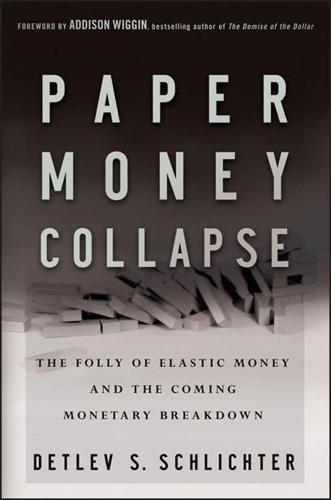
Paper Money Collapse: The Folly of Elastic Money and the Coming Monetary Breakdown
by
Detlev S. Schlichter
Published 21 Sep 2011
Table of Contents Cover Title page Copyright page Dedication Epigraph Foreword Acknowledgments Prologue: The Brave New World of Elastic Money Inelastic versus Elastic Background on the “Reasoning” New Infrastructures and Policies Why I Wrote This Book This Book’s Setup A Note on Pronouns in the Text Part One: THE BASICS OF MONEY Chapter 1 The Fundamentals of Money and Money Demand The Origin and Purpose of Money The Demand for Money The Functions of Money The Unique Position of the Paper Money Producer The Monetary Asset versus Other Goods Chapter 2 The Fundamentals of Fractional-Reserve Banking Money Supply without Money Demand Money as an Enhancer of Lending Activity The Origin and Basics of Fractional-Reserve Banking Relinquishing Ownership of Your Money to the Bank Misconceptions about Fractional-Reserve Banking The Stability of Fractional-Reserve Banking Fractional-Reserve Banks, the State, and the Economists The Desire for Elastic Money Summary Part Two: THE EFFECTS OF MONEY INJECTIONS Chapter 3 Money Injections without Credit Markets Even, Instant, and Transparent Money Injection Even and Nontransparent Money Injection Uneven and Nontransparent Money Injection Chapter 4 Money Injections via Credit Markets Consumption, Saving, and Investing Interest Money Injection via the Loan Market The Process in More Detail Policy Implications of the Austrian Theory Summary Part Three: FALLACIES ABOUT THE PRICE LEVEL AND PRICE LEVEL STABILIZATION Chapter 5 Common Misconceptions Regarding the Price Level The Price Level and Monetary Stability A Historical Perspective on Price Level Stability Why Would Commodity Money Be Unstable?
…
Whatever the reason, the supply of money is not regulated by market forces, such as the interplay of cost of production and consumer demand that operates in the markets for all other goods and services. Once paper money has been established, the production can proceed practically without cost and without regard for money demand. The Stability of Fractional-Reserve Banking It is evident that the practice of fractional-reserve banking involves risks to the banks. Fractional-reserve banks issue claims against themselves that they know they are unable to meet. Every fractional-reserve bank is at risk of bankruptcy if too many depositors ask for their money back. Their solvency thus depends on accurately predicting the probability that a larger than usual amount of these claims could be presented at the same time.
…
Those who advocate an elastic form of money in order to absorb sudden changes in money demand and to keep money’s purchasing power stable will have to explain how the money producer is supposed to anticipate changes in money demand before they affect purchasing power. We will revisit this point when we discuss the concept of price level stabilization in full in a later chapter.14 The third point about the rise of banking, and fractional-reserve banking in particular, is a different one. What fractional-reserve banking is and how it came about will be explained in more detail shortly. Here, a couple of short comments may suffice. Fractional-reserve banking introduced a degree of elasticity into the money supply even at a time when money proper was still a commodity of essentially inelastic supply. Banks created so-called fiduciary media, that is, uncovered claims to commodity money.15 These claims could come in the form of redeemable banknotes or redeemable deposits, redeemable into gold that is.
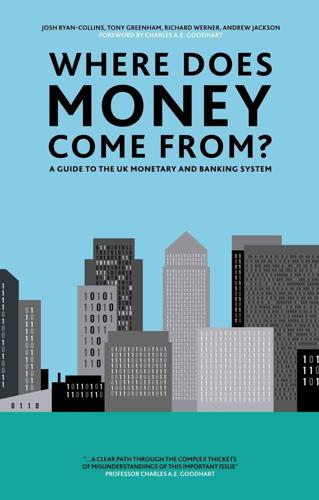
Where Does Money Come From?: A Guide to the UK Monetary & Banking System
by
Josh Ryan-Collins
,
Tony Greenham
,
Richard Werner
and
Andrew Jackson
Published 14 Apr 2012
For a thorough ranging review see Huerta de Soto (2006/1998)67. For a user-friendly and colourful introduction to the origins of fractional reserve banking, download Paul Grignon’s animated film Money as Debt68. * There is some confusion in the various debates around the role of interest and fractional reserve banking literature about which is more important. We would argue that there is not a problem with noncompounding interest when it genuinely represents the lost opportunity cost of not having a resource (in this case money). But in the case of fractional reserve banking, as we have seen, there is no loss of resource by the bank when it makes a loan – no money is being taken from anywhere else.
…
All the deposits, with the exception of the reserve fund, are merely claims on the banker, which, however, never exist as deposits.70 Aside from its questionable legality, fractional reserve banking was and remains a business model quite different from normal market-based activities.71 For most businesses, there is a direct relationship between revenues and the provision of goods and services and hence costs, usually at a declining rate. And in true intermediary banking activity, for example, the loaning of time deposits as described at the start of this chapter, profits are limited by the interest-rate differential between what the bank has to pay to the saver and demand from the borrower. But by lending at interest through fractional reserve banking, the revenue stream can rise exponentially, without the provision of any new goods or services to anyone, and hence without further costs (see also Box 8, Section 4.4).
…
Problems with the orthodox story 3.3. Credit theory of money: money as a social relationship 3.3.1. Money as credit: historical evidence 3.3.2. The role of the state in defining money 3.4. Key historical developments: promissory notes, fractional reserves and bonds 3.4.1. Promissory notes 3.4.2. Fractional reserve banking 3.4.3. Bond issuance and the creation of the Bank of England 3.5. Early monetary policy: the Bullionist debates and 1844 Act 3.6. Twentieth century: the decline of gold, deregulation and the rise of digital money 3.6.1. A brief history of exchange rate regimes 3.6.2. WWI, the abandonment of the gold standard and the regulation of credit 3.6.3.
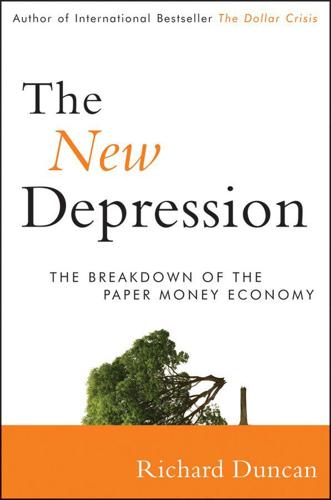
The New Depression: The Breakdown of the Paper Money Economy
by
Richard Duncan
Published 2 Apr 2012
Contents Preface Chapter 1: How Credit Slipped Its Leash Opening Pandora’s Box Constraints on the Fed and on Paper Money Creation Fractional Reserve Banking Run Amok Fractional Reserve Banking Commercial Banks The Broader Credit Market: Too Many Lenders, Not Enough Reserves Credit without Reserves The Flow of Funds The Rest of the World Notes Chapter 2: The Global Money Glut The Financial Account How It Works What Percentage of Total Foreign Exchange Reserves Are Dollars? What to Do with So Many Dollars? What about the Remaining $2.8 Trillion?
…
The second was regulatory approval that allowed new types of creditors to enter the industry with little to no mandatory reserve requirements whatsoever. The following pages describe this evolution of the U.S. financial industry. In order to understand how reserve requirements limited credit creation, it is first necessary to understand how credit is created through Fractional Reserve Banking. Fractional Reserve Banking Most banks around the world accept deposits, set aside a part of those deposits as reserves, and lend out the rest. Banks hold reserves to ensure they have sufficient funds available to repay their customers’ deposits upon demand. To fail to do so could result in a bank run and possibly the failure of the bank.
…
This process occurs again and again (see Exhibit 1.4). Therefore, an initial deposit of $100 worth of gold, through the magic of fractional reserve banking, eventually leaves the banking system with $500 of deposits and $400 of credit, while an amount equivalent to the initial deposit is set aside as $100 worth of reserves. The balance sheet of the banking sector would show assets of $500, made up of $400 in loans plus $100 in reserves; and it would show liabilities of $500 made up entirely of deposits. EXHIBIT 1.4 “Money Creation” through Fractional Reserve Banking In the real world, there are a number of other factors that would have to be taken into consideration.
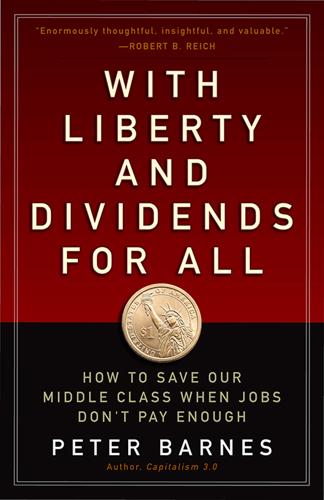
With Liberty and Dividends for All: How to Save Our Middle Class When Jobs Don't Pay Enough
by
Peter Barnes
Published 31 Jul 2014
Dean Baker, “Reducing Waste with an Efficient Medicare Prescription Drug Benefit,” Center for Economic and Policy Research Issue Brief, Washington, DC, January 2013, http://www.cepr.net/documents/publica-tions/medicare-drug-2012-12.pdf. 11. For an explanation of fractional reserve banking, see “Fractional reserve banking,” Wikipedia, http://en.wikipedia.org/wiki/Fractional_reserve_banking. 12. For data on financial-industry profits, see Sameer Khatiwada, “Did the financial sector profit at the expense of the rest of the economy? Evidence from the United States,” Discussion paper 206, International Institute for Labour Studies, Geneva, Switzerland, 2010, figure 1, p. 2, http://www.ilo.org/wcmsp5/groups/public/---dgreports/---inst/documents/publication/wcms_192804.pdf.
…
Indeed, by expanding coverage, they may actually increase the rent extracted by health-related companies. Or consider our financial sector. Commercial banks, the kind that take deposits and make loans, receive an immensely valuable gift from the federal government: the right to create money. They’re allowed to do this through what’s called fractional reserve banking, which lets them lend, with interest, about ten times more than they have on deposit.11 This gift alone is worth billions. Then there are commercial banks’ cousins, investment banks, which are in the business of trading securities. They can’t mint money the way commercial banks do, but they have tricks of their own.
…
And in reality, we the people are the backers of our national currency. If banks—or at least big banks—fail, we pick up the pieces. So if anyone should get the benefits from issuing new US currency, it should be us. How do private banks create official US dollars? They do it through a process called fractional reserve banking. If you deposit $1,000, the banking system uses your money as a reserve to lend about $10,000. To make loans beyond your deposit, a bank simply creates the money electronically. As long as it holds about 10 percent of its loans in reserve (in case depositors want to withdraw cash), the bank is in compliance with the law.
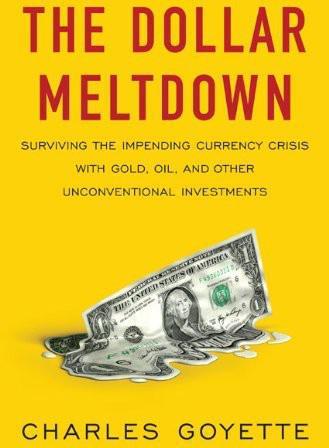
The Dollar Meltdown: Surviving the Coming Currency Crisis With Gold, Oil, and Other Unconventional Investments
by
Charles Goyette
Published 29 Oct 2009
Of course this creation of new money increases the total supply of money in the nation, thereby devaluing all the money that existed before. Now the plot thickens. America’s banks, regulated by the Federal Reserve, are fractional reserve banks. Recall our first fractional reserve banker/goldsmiths who lent out receipts for more gold than they actually had on deposit—until they got caught, that is. Similarly, fractional reserve banks are allowed to maintain on hand only a fraction of the depositsthathavebeenmadewiththemasareserveagainstwithdrawals. This relies on the assumption that not all the banks’ depositors will come in at once to make withdrawals.
…
Once the system got rolling they profited tremendously. For example, a goldsmith /banker who had a thousand ounces of gold on deposit would print up receipts for four times that much. Instead of receiving interest on the thousand ounces he actually had available to lend, he got interest on all four thousand ounces. Fractional reserve banking had been invented; the reserves maintained were a mere fraction of what had been loaned out. The practice had an unfortunate side effect: it was inflationary. The banker had created new money that entered the economy, bidding up the price of goods and services many times over. There was, however, a pitfall in this scheme.
…
The Federal Reserve affects credit conditions by adjusting the reserves the banks must keep on deposit with the Fed. By lowering the reserve requirement, it allows banks to loan more money; by raising the fraction of its deposits that must be held in reserve, it causes banks to loan less. Fractional reserve banking multiplies many times over the money increase of the Federal Reserve’s debt monetization. If the recipient of this newly created money on account in its bank withdraws it from the account, the inflation process ends in the amount of the new money created by the Fed. But suppose the recipient leaves the computer credit of new money in its account.
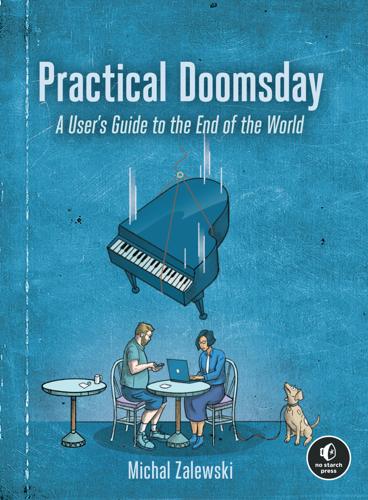
Practical Doomsday: A User's Guide to the End of the World
by
Michal Zalewski
Published 11 Jan 2022
Uniquely Virulent and Deadly Diseases Runaway Climate Change Other Planetary-Scale Natural Disasters Exotic Physics and Miscellaneous Space Phenomena Unimpeded Rise of Totalitarian Regimes Global Thermonuclear War Nuclear Electromagnetic Pulse Ghosts, Bigfoot, and the Coming Robot Apocalypse The Scourge of Extraterrestrials Looking Beyond Doomsday Part II: The Prepared Lifestyle Chapter 5: Mind Over Matter Chapter 6: Building a Rainy-Day Fund Finding Ways to Save Compartmentalizing the Funds Dealing with Debt Knowing Where to Stop Chapter 7: Safeguarding Your Savings The History of Currencies Debt as a Currency The Age of Coin Fractional Reserve Banking and Fiat Money Cryptocurrencies Revisiting Dangers to Liquidity and Capital Loss of Access to Bank Accounts Adverse Judgments Gradual Inflation Hyperinflation Confiscation of Wealth The (Monetary) Zombie Apocalypse Methods for Mitigating Risk Physical Cash Diversified Bank Deposits Bonds Simple Currency Hedges Equities Stock Options and Commodity Futures Options Precious Metals Real Estate Physical Collectibles Cryptocurrencies and NFTs Insurance Policies and Separation of Assets Portfolio Design Strategies Chapter 8: Engineering a Doomsday-Proof Career Chapter 9: Staying Alive Defensive Driving Working at Heights The Enemy in the Medicine Cabinet Alcohol and Recreational Drugs Workshop and Power Tool Safety Fireproofing the Homestead Other Dangers in and Around the Home Chapter 10: Protecting Oneself in the Digital and Physical Realm Dealing with Online Fraud Maintaining Privacy on the Internet Minimizing the Impact of Burglaries Responding to Muggings and Home Invasions Fending Off Pickpockets A Word on Kindness Chapter 11: Getting in Shape The Folly of Miracle Cures Establishing a “No Diet” Diet Calorie Restriction vs.
…
Alas, if there’s one safe generalization about the prepper community, it’s that the domain is replete with misconceptions, politically tinged conspiracy theories, and patently dangerous wealth-management advice. The world of modern finance is simultaneously portrayed as a brutal game rigged against the little guy and as a nihilist charade orchestrated by bankrupt governments, with terms such as modern monetary theory, fractional reserve banking, or bailouts thrown in for dramatic effect. To navigate this perilous landscape, I find it useful to take a step back and consider how money came to be, what purpose it serves, and what determines its value today. The answers to these questions are more complex than one might expect—and they’re crucial to deciphering many of the pop-cultural clichés about how banks, financial markets, or the government are purportedly conspiring to deprive us of our hard-earned cash.
…
Still, as long as people had faith in their leaders and the volume of requests for precious metal stayed reasonably low, the fundamental mechanics of this currency remained the same as before, both domestically and in foreign trade. The only obvious new risk was that in the event of the financial collapse or military defeat of the issuing state, its money would become worthless—but such scenarios weren’t keeping most citizens up at night. Fractional Reserve Banking and Fiat Money In contrast to all the financial skulduggery undertaken by governments, commercial banking remained a rather dull affair for many millennia. It was an exercise in the reconciliation of accounts and the safekeeping of deposits. Perhaps surprisingly, early banks didn’t play much of a role in what we now call consumer lending; instead, the vast majority of personal loans happened between people who knew each other in some way.

The Financial Crisis and the Free Market Cure: Why Pure Capitalism Is the World Economy's Only Hope
by
John A. Allison
Published 20 Sep 2012
In addition to the risk of the bank’s failing, there is another negative effect: under liquidity pressure, banks can no longer make loans, and this often puts businesses that need to borrow into financial distress, with the result that the whole economic system starts to malfunction. Some Austrian economists have argued against fractional reserve banking (specifically for demand deposits, or checking accounts). They have identified the existence of central banks (like the Federal Reserve) as the primary cause of business cycles and fractional reserve banking as a related factor.1 They have a valid and useful insight. In Chapter 18, on solutions to the financial crisis, I will share with you some ideas for dealing with this issue without losing the benefits of magnifying the economic efficiency of intermediate-size investments and small savings that banks provide.
…
It is vital for small businesses and especially for smaller builders/developers in the real estate market, where local knowledge is essential to risk underwriting. Local knowledge is also of great value in most forms of consumer lending. Economists call the system we have just described fractional Reserve banking. This terminology is appropriate because the banks have only a fraction of the depositors’ money in Reserve, or “on hand.” The rest is invested in loans or bonds. The system obviously has an intrinsic risk that leads to economic volatility. The depositors expect to be able to get their money whenever they want it, and yet the bank does not have everyone’s money on hand.
…
In Chapter 18, on solutions to the financial crisis, I will share with you some ideas for dealing with this issue without losing the benefits of magnifying the economic efficiency of intermediate-size investments and small savings that banks provide. The Federal Reserve and FDIC insurance were both created to deal with the issues associated with the nature of fractional reserve banking. In the short term, these “solutions” help; in the long term, they make the problem far, far worse. FDIC insurance primarily reduces the short-term risk of bank runs because depositors perceive their deposits to be insured by the federal government. However, I previously described the fact that FDIC insurance substantially increases the credit and liquidity risk that banks take by eliminating market discipline.
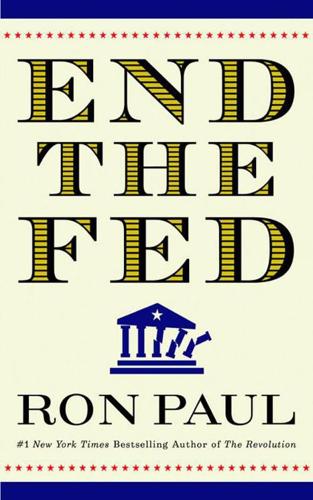
End the Fed
by
Ron Paul
Published 5 Feb 2011
Whenever instability turns up, so do efforts to socialize the losses. Rarely do people ask what the fundamental source of instability really is. For an answer we can turn to a monumental study published in 2006 by Spanish economist Jesús Huerta de Soto. 1 He places the blame on the very institution of fractional-reserve banking, the notion that depositors’ money currently in use as cash may also be loaned out for speculative projects and then redeposited. The system works so long as people do not attempt to withdraw all their money at once, as permitted to them in the banking contract. Once they do attempt this, the bank faces a choice to go bankrupt or suspend payment.
…
Just so that we are clear: the modern system of money and banking is not a free-market system. It is a system that is half socialized—propped up by government—and one that could never be sustained as it is in a clean market environment. And this is the core of the problem. In examining the history of the Fed in particular, we must start far back in the story, since fractional-reserve banking had already become part of established banking practices in the nineteenth century, a fact that goes a very long way to explain the source of periodic instability. The story can be said to begin in 1775, when the Continental Congress issued a paper money called the continental, as in “not worth a continental.”
…
In my sheltered life, I thought we worked for money, paid our bills in money, and when we had too much on hand, we saved it in a bank and it earned interest. That’s what I did with my pennies and quarters earned from lawn mowing and delivering papers and milk. But now, it was explained to me, the bank only had to have a fraction of the actual money on hand. I was told this facilitated economic growth through the concept of fractional-reserve banking. It made me question, but surely not enough, the system the professor was now explaining to me. In a way, it seemed to be a pretty neat trick. My first reaction might have been something like Paul Begala’s startling discovery, while serving in the Clinton administration, regarding executive orders: “Stroke of the pen, law of the land, kinda cool.”
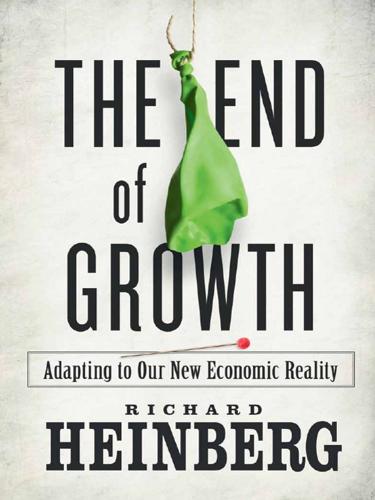
The End of Growth: Adapting to Our New Economic Reality
by
Richard Heinberg
Published 1 Jun 2011
Petroleum has a pivotal place in the modern world — in transportation, agriculture, and the chemicals and materials industries. The Industrial Revolution was really the Fossil Fuel Revolution, and the entire phenomenon of continuous economic growth — including the development of the financial institutions that facilitate growth, such as fractional reserve banking — is ultimately based on ever-increasing supplies of cheap energy. Growth requires more manufacturing, more trade, and more transport, and those all in turn require more energy. This means that if energy supplies can’t expand and energy therefore becomes significantly more expensive, economic growth will falter and financial systems built on expectations of perpetual growth will fail.
…
The practice of loaning out receipts for gold that didn’t really exist worked fine, unless many receipt-holders wanted to redeem paper notes for gold or silver all at once. Fortunately for the bankers, this happened so rarely that eventually the writing of receipts for more money than was on deposit became a perfectly respectable practice known as fractional reserve banking. It turned out that having increasing amounts of money in circulation was a benefit to traders and industrialists during the historical period when all of this was happening — a time when unprecedented amounts of new wealth were being created, first through colonialism and slavery, but then by harnessing the enormous energies of fossil fuels.
…
It was a way of shifting wealth from the many to the few, with Ponzi skimming off a lavish income as the money passed through his hands. At the height of the scheme, Ponzi was raking in $250,000 a day, millions in today’s dollars. Thousands of people lost their savings, in some cases having mortgaged or sold their houses in order to invest. A few critics (primarily advocates of gold-backed currency) have called fractional reserve banking a kind of Ponzi scheme, and there is some truth to the claim.5 As long as the real economy of goods and services within a nation is growing, an expanding money supply seems justifiable, arguably necessary. However, units of currency are essentially claims on labor and natural resources — and as those claims multiply (with the growth of the money supply), and as resources deplete, eventually the remaining resources will be insufficient to satisfy all of the existing monetary claims.
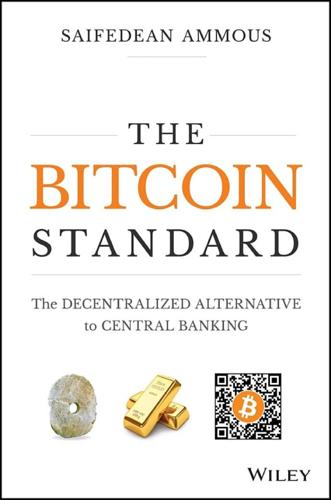
The Bitcoin Standard: The Decentralized Alternative to Central Banking
by
Saifedean Ammous
Published 23 Mar 2018
In other words, there is no distinction between illiquidity and insolvency, and there is no systemic risk that could make any bank “too big to fail.” A bank that fails is the problem of its shareholders and lenders, and nobody else. Unsound money allows the possibility of mismatching maturity, of which fractional reserve banking is but a subset, and this leaves banks always liable to a liquidity crisis, or a bank run. Maturity mismatching, or fractional reserve banking as a special case of it, is always liable to a liquidity crisis if lenders and depositors were to demand their deposits at the same time. The only way to make maturity mismatching safe is with the presence of a lender of last resort standing ready to lend to banks in case of a bank run.26 In a society with sound money, a central bank would have to tax everyone not involved in the bank in order to bail out the bank.
…
Central banks determine the interest rate and the supply of loanable funds through a variety of monetary tools, operating through their control of the banking system.6 A fundamental fact to understand about the modern financial system is that banks create money whenever they engage in lending. In a fractional reserve banking system similar to the one present all over the world today, banks not only lend the savings of their customers, but also their demand deposits. In other words, the depositor can call on the money at any time while a large percentage of that money has been issued as a loan to a borrower.
…
On the other hand, a rise in interest rates causes a reduction in lending and contraction in the money supply, or at least a reduction in the rate of its growth. Business Cycles and Financial Crises Whereas in a free market for capital the supply of loanable funds is determined by the market participants who decide to lend based on the interest rate, in an economy with a central bank and fractional reserve banking, the supply of loanable funds is directed by a committee of economists under the influence of politicians, bankers, TV pundits, and sometimes, most spectacularly, military generals. Any passing familiarity with economics will make the dangers of price controls clear and discernable. Should a government decide to set the price of apples and prevent it from moving, the outcome will be either a shortage or a surplus and large losses to society overall from overproduction or underproduction.
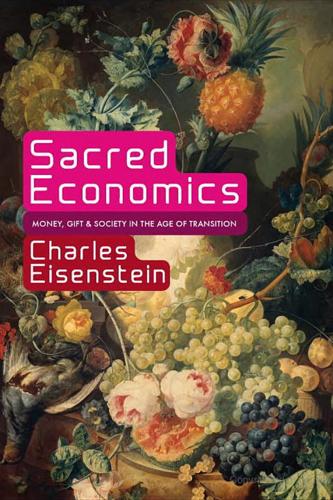
Sacred Economics: Money, Gift, and Society in the Age of Transition
by
Charles Eisenstein
Published 11 Jul 2011
Italian traders used bills of exchange as early as the twelfth century, a practice that spread rapidly and was followed in the sixteenth and seventeenth century by fractional-reserve banking.2 This was a major innovation, since it freed the money supply from the metal supply and allowed it to grow organically in response to economic activity. The detachment of money from metal was gradual. During the fractional-reserve banking era, which lasted several centuries, bank notes were still, at least in theory, backed by metal. Today the era of fractional-reserve banking is over, and money has become pure credit. This is not widely recognized. Many authorities, including most economics textbooks and the Federal Reserve itself,3 still maintain the pretense that reserves are a limiting factor in money creation, but in practice they almost never are.4 Banks’ real constraints on money creation are their total capital and their ability to find willing, creditworthy borrowers—that is, those with either uncommitted earning potential or assets to use as collateral.
…
I ask this question because some monetary reformers think this is a bad idea and have built entire economic philosophies around gold or fiat money systems in which fractional-reserve banking and private creation of credit-money would be prohibited. I will address this issue in some depth because it represents an important line of thinking in the New Economics. Recent proposals by monetary historian Stephen Zarlenga have even found sympathy in the fringes of American politics, notably with Congressman Ron Paul. The abolition of fractional-reserve banking also is part of the philosophies of certain followers of the social credit movement, the Austrian School of economics, and many others.
…
I spent quite a while trying to resolve the question of whether fractional-reserve banking or full-reserve banking is consistent with sacred economics. After wrestling with the formidable complexities of the issue and reading papers going back to the 1930s, one day I gave up and lay down on the couch where, predictably and somewhat to my chagrin, it dawned on me that the two systems are not as fundamentally different as most people think. The confusion, which is rife on the internet, comes on one level from a simplistic and incorrect view of how fractional-reserve banking actually works, and on a deeper level from an artificial and irrelevant distinction between what is conventional and what is real.
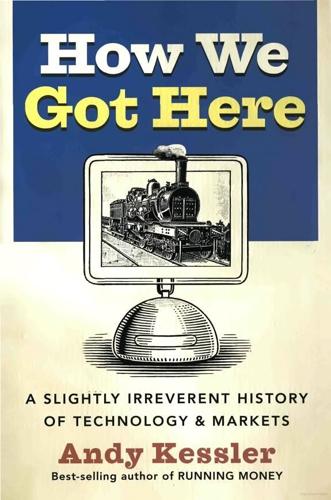
How We Got Here: A Slightly Irreverent History of Technology and Markets
by
Andy Kessler
Published 13 Jun 2005
Goldsmiths in London had long before figured out they could lend money against the gold they held, making money on the interest payments. As long as they were careful to only write good loans, and not everyone asked for their gold back at the same time, this so-called “fractional reserve banking” was a hugely profitable business. Well, the Bank of England existed to make money for its secretive shareholders. So it implemented this goldsmith sleight of hand, and jumped into fractional reserve banking in a big way, by issuing loans, sometimes for 10 times as much gold as it had on hand, mainly to the government. These loans were secured by future tax payments. The more gold in their reserves, then the more loans they could write.
…
Even when “invisible hand” Adam Smith backed Real Bills the Bullionists weren’t swayed. Too bad. Real Bills was only slightly flawed in that it didn’t check the amount of speculative loans a bank could issue, since loans are the source of bank profits. A floating reserve requirement, putting limits on fractional reserve banking in good times, could have fixed that flaw. Perhaps a Real Bills Doctrine could automate the creation of money supply today, in a modern non-gold standard world. But Reserve Bank chairmen have too much fun adjusting interest rates and turning on and off money supply at their whim to entertain the thought.
…
How strange. In times of peace, banknotes are not trustworthy enough and must be backed by gold in reserves, but in times of war, when nobody trusts anyone, banknotes are based on pure fiat, trust out of thin air. Welcome to the backwards world of banking. As an aside, it is bizarre that fractional reserve banks, which describe just about every bank in existence today, are basically FOOL’S GOLD 81 bankrupt. A deposit in a bank is an asset for you and me, but it’s a liability for the bank, since it owes us the money. But then the bank lends out the depositors’ money as loans, and those loans are a bank’s assets.

The Blockchain Alternative: Rethinking Macroeconomic Policy and Economic Theory
by
Kariappa Bheemaiah
Published 26 Feb 2017
Special mention goes out to Nick Sanders, who was the first person to take the risk of giving me a chance to study and then work in GEM when all I had was bold ideas and burning ambition. Contents Chapter 1: Debt-based Economy: The Intricate Dance of Money and Debt An obsession with cash Fractional Reserve banking and Debt-based money Our Waltz with Debt How much debt is too much debt? Shadow banking and systemic risk Rethinking debt-based capitalism Chapter 2: Fragmentation of Finance The Fuzziness of Financialisation Financialization and the Innovation of Risk TBTF #Ending TBTF A new way of looking at fragmentation Sharding Using the Skeleton Keys The enemy of my enemy is my friend Challenges and Solution Pathways Digital Identity and KYC Scalability Chapter 3: Innovating Capitalism Reviewing the current definition of capitalism A Changing Market Structure Lending and Payments Trade Finance Regulating Regulation Accounting Jiggery Pokery Policies for a cashless future Centralized Government Money Issuance and the Cashless Economy Fiat currency on a Blockchain Multiple currencies in a cashless environment One digital money to rule them all—Fiscal Policy instead of Monetary Policy?
…
When the country is a large importer, it can also find its currency being used as a peg by other dependent economies, as is with the case with the US dollar and the Euro.5 As the value of a currency is based on supply and demand of the currency, a question that arises is with respect to the manner in which the main drivers of money creation are adjusted in a free market. In order to understand this concept, we need to refresh our understanding of fractional banking, inflation, and the role played by central and commercial banks. Fractional reserve banking and debt-based money To understand the concept of fractional banking it is important to first acknowledge that although central banks and governments belong to the same ilk and work in unison with respect to the issuance of sovereign coin, it is the central bank that actually influences how much money to create based on the inflation targets and the interest rate.
…
For the sake of simplicity, let’s assume that the minimum amount of capital to be held by a commercial bank (Group 1 or Group 2) is rounded off to around 10% of its total capital. The capital percentage to be held at the central bank would then be calculated as: This 10% minimum requirement is the basis of fractional reserve banking. What it shows is that according to the rules stated by the BIS, a bank only needs to have a fraction of its money in reserve, in this case 10%, in order to make out loans. Based on this stipulation a commercial bank can expand the deposits held by them by keeping only 10% of a deposit in their reserves and lending out the remaining 90% at a fixed or variable interest rate.
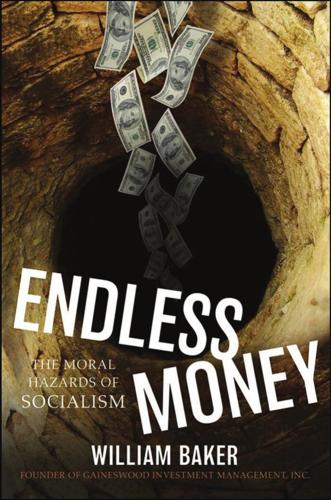
Endless Money: The Moral Hazards of Socialism
by
William Baker
and
Addison Wiggin
Published 2 Nov 2009
Rothbard, view this as counterfeiting. The issue of counterfeiting was swept aside legally through British court cases (Carr v. Carr in 1811 and Devaynes v. Noble in 1816).2 By the 19th century it was generally accepted that banks could continuously pyramid loans against deposits, making fractional reserve banking the principle mechanism by which money could be created in the economy. Some point out that systems of circulating receipts for physical goods constituted paper money well before this time. In the medieval era families such as the Riccis and the Medicis extended credit to customers and accepted an additional fee for the time value of money, but the paper this created was not expanded beyond the value of goods sold.
…
After this gold was returned, merchants sought to avoid the state’s involuntary usage of their wealth by keeping it at goldsmiths instead, who issued receipts for the inventory. The receipts were used as a form of currency and were issued in excess of the gold held, thus giving birth to “fractional reserve” banking at about the same time as the Massachusetts colony began its paper currency system. This expansion of credit built upon a hard base such as the goldsmith’s gold stock is the model of a gold standard such as that adopted by England in 1816 or by the United States in 1879. An important variant was the emergence of state chartered banks as well as the establishment of a central bank.
…
Taken to the extreme, bank reserve requirements could be set near zero to permit infinite expansion of the money stock. The panic of 2008 may have this very characteristic. The experience of the early 19th century provides some evidence of Rothbard’s observation of how strong the profit opportunity was when the United States first witnessed fractional reserve banking. Howard Bodenhorn, an academic authority on the topic, described the rush to set up banks in that era in two books published this decade. What is interesting is that the process was particularly political and intertwined the state with banks, since charters were granted by legislatures.
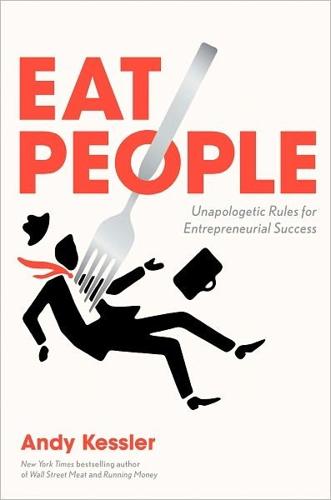
Eat People: And Other Unapologetic Rules for Game-Changing Entrepreneurs
by
Andy Kessler
Published 1 Feb 2011
Still, more money needs to be created to fill the bigger bucket. But since no one knows what the velocity of money is, no one knows how much money is needed to keep the economy working just right. So it’s virtually impossible to fill the bucket just up to the rim. The Federal Reserve, the U.S. central bank that creates our fiat currency by allowing fractional reserve banks to operate, just guesses and creates what they think is the right amount of money. As we all know, too much money chasing too few goods creates inflation, a situation where prices go up above and beyond what they normally would if the supply of money and the actual wealth in society were perfectly matched.
…
And not one dollar for each one dollar in gold held. No, no, no. They might as well lend out ten times as much money as the gold held, figuring not all “depositors” would want their gold back at the same time. Money from nothing (and your checks for free). Sort of, anyway. This sleight of hand is called fractional reserve banking, and was an easy (if not a little sleazy, no?) way to increase money supply to, again, make room for productivity and wealth creation. But how much money? No one knows, which is why there were occasionally bank runs and panics and depressions that followed easy credit, one of the hazards of this flimsy system.
…
(We can argue about whether the FDIC is really an insurance policy, as they undercharge banks for the privilege of insuring against bank runs, and you and I, the taxpayers, make up the difference. Still, the FDIC is a decent bargain. It’s a backstop to panics—bank run panics anyway!) As long as banks make prudent loans, which, as we’ve seen in 2008, is not the greatest assumption. Twin bargains. Twin safety nets for fractional reserve banking so we don’t have to go back to the stifling days of gold. The Federal Reserve allows banks to post assets in exchange for loans to redeem depositors, in effect making the Fed the lender of last resort to banks. And then there’s the FDIC, basically an insurance policy (up to $100,000 and sometimes $250,000) against bank runs, no matter how bad the bankers are at making loans.
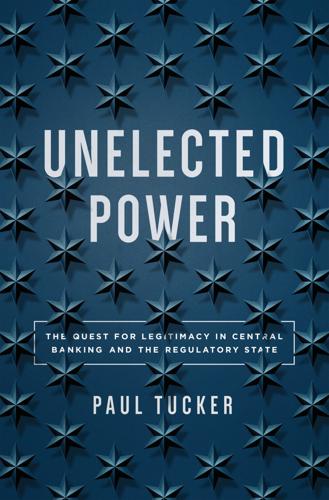
Unelected Power: The Quest for Legitimacy in Central Banking and the Regulatory State
by
Paul Tucker
Published 21 Apr 2018
Quite apart from the irony of Jackson’s own preoccupations having been with the untrammeled power of bankers, I doubt it is worth creating more private political-financial power in order to obtain competitive money issuance.10 But none of that is to deny force in the central point about moral hazard, to which we return when discussing principles for the postcrisis LOLR (chapter 23). To Ban or Permit Fractional-Reserve Banking? Around a century after Jackson’s presidency, Chicago economists launched the other line of attack on the place of banking within a monetary system. Under the “Chicago Plan,” fractional-reserve banking itself would be banned, leaving only what are today known as narrow banks wholly invested in government bonds or central bank reserves (with central banks in turn invested in government bonds).
…
Monetary policy makers have a very clear interest in the structure of labor markets and, more generally, the supply side of the economy: broadly, the more flexible an economy’s product and labor markets, the less central banks have to do to steer aggregate demand in the face of nasty shocks to the economy.6 But no one argues that central banks should have a formal role in supply-side policy. So Volcker’s normative stipulation must rest on something special about the nature of their interest in the financial system, which stems, essentially, from the place of banking in the monetary system and that of central banks in the banking system. Fractional-Reserve Banking: Private Liquidity Insurance and Money Creation An economy’s banking system provides liquidity insurance to the rest of the economy (to households and businesses). Banks do this by allowing customers to withdraw deposits on demand and to draw down committed lines of credit on demand. Their capability to provide this liquidity insurance stems from their deposit liabilities being treated by us (people and businesses) as money.
…
Even if the deposit is immediately transferred to another bank, the monetary liabilities of the system as a whole expand. Banks are monetary institutions. In fact, most of the money in today’s economies is the deposit money issued by private banks, known as broad money (or, because it is created by their own lending activities, inside money). This is not a riskless business. It is known to economists as fractional-reserve banking (FRB) and, for once, the jargon conveys something important. While commercial banks undertake to repay deposits on demand, they employ only a small fraction of those deposits in low-risk, liquid assets (of which the lowest-risk and most liquid are balances with the central bank, known as reserves).
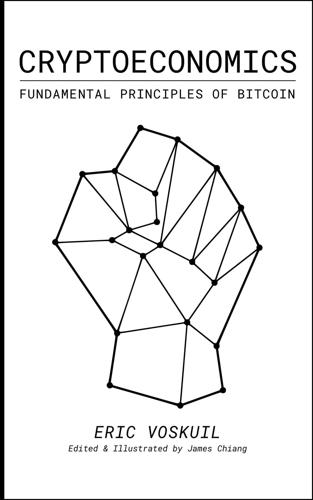
Cryptoeconomics: Fundamental Principles of Bitcoin
by
Eric Voskuil
,
James Chiang
and
Amir Taaki
Published 28 Feb 2020
The amount hoarded is sometimes referred to as the owner’s “reserve”, but properly it is the owner’s hoard, a fraction of that owner’s total savings. This use of the word reserve should not be confused with its use in the state money context of reserve currency [517] (i.e. foreign exchange reserves [518] ) . The term “fractional reserve banking” is a reference to the ratio of a bank’s hoard to its issued credit (money accounts). The total amount of U.S. Dollars in circulation [519] is referred to as “M0”. This includes all tangible currency (“vault cash”) plus intangible bank balances in Federal Reserve accounts. These two forms are considered interchangeable obligations of the Fed [520] .
…
Huerta de Soto considers the possibility “that a certain group of bank customers (or for the sake of argument, all of them) enter into a deposit contract aware and fully accepting that banks will invest (or loan, etc.) a large portion of the money they deposit”. In this case, argues Huerta de Soto, “the supposed authorization from the depositors lacks legal validity” because few lay-persons understand the instability inherent in fractional-reserve banking: they believe their deposit is guaranteed, which Huerta de Soto considers a (near universal) misconception. Wikipedia: Jesús Huerta de Soto Yet those who make this argument believe themselves able to understand it. As such the theory is invalid. Given the moral distinction of nonaggression [592] , it is the right of every individual to contract with another voluntarily.
…
So in the case where demand to transact exceeds the fixed confirmation supply, this scenario is not economically rational. This relation holds at any enforced coin dust level above zero to the extent that dust is an insufficient fee to finance confirmation. Thin Air Fallacy There is a theory that fractional reserve banking [851] inherently gives banks the ability to create money at no material cost. The theory does not depend on the state privilege of seigniorage [852] . It is considered a consequence of the accounting practices of free banking [853] . This is sometimes referred to as creating money ex nihilo or “out of thin air ” [854] .
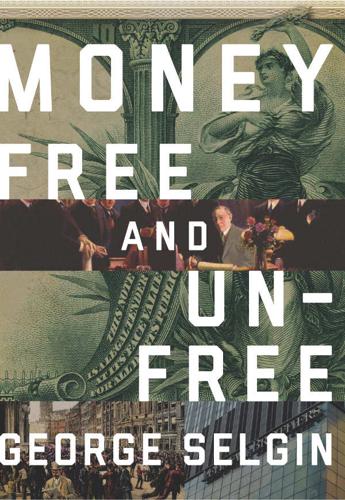
Money Free and Unfree
by
George A. Selgin
Published 14 Jun 2017
A central bank can act as a “lender of last resort” to other banks, assuring depositors that they need never fear a general banking collapse; fiat money in turn guarantees that the lender of last resort itself will never go broke.1 A crucial assumption behind the lender-of-last-resort argument is that fractional-reserve banking is inherently “fragile” and crisis prone—that central banking and fiat money are an unavoidable response to market failure. According to Hyman Minsky (1982: 17), “conditions conducive to financial crises emerge from the normal functioning of a capitalist economy.” In a free market, says Minsky, such conditions will occasionally produce “wide and spreading bankruptcies” that could, however, be prevented by “an alert lender of last resort” (Minsky 1982: 13).2 In this chapter I take issue with the lender-of-last-resort argument by showing that its underlying assumption is false: fractional-reserve banking systems are not inherently weak or unstable.
…
In a free market, says Minsky, such conditions will occasionally produce “wide and spreading bankruptcies” that could, however, be prevented by “an alert lender of last resort” (Minsky 1982: 13).2 In this chapter I take issue with the lender-of-last-resort argument by showing that its underlying assumption is false: fractional-reserve banking systems are not inherently weak or unstable. They are weak and unstable because legal restrictions have made them that way. The collapse of a fully deregulated banking system would be highly improbable if not impossible. It follows that central banks and fiat money are at most second-best solutions to problems peculiar to regulated banking.
…
I believe the answer is that they do not evolve that way at all but have been weakened by legal restrictions ultimately aimed at generating revenue for the government or at propping up special interests within the banking industry. In the United States, the adverse effects of particular restrictions are well understood. What is not appreciated is how their cumulative effects have led to the present reliance upon a lender of last resort. Were an evil dictator to set out purposefully to weaken a fractional-reserve banking system, and to increase its dependence upon a lender of last resort, he would (1) increase the risk exposure of individual banks to enhance their prospects of insolvency; (2) create an environment conducive to “spillover” or “contagion” effects, so that individual bank failures can lead to systemwide runs; and (3) obstruct private-market mechanisms for averting crises.
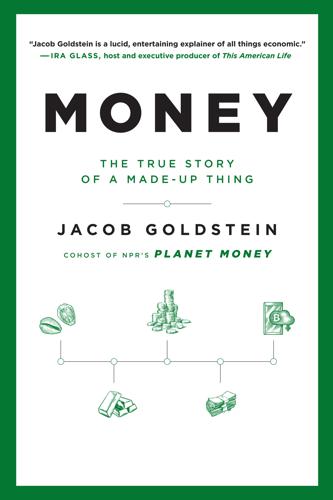
Money: The True Story of a Made-Up Thing
by
Jacob Goldstein
Published 14 Aug 2020
That money—your money—is now in two places at once. It is your money, in your account at the bank. It is also the borrower’s money. The borrower can deposit her money at another bank, which can then lend some of it out to yet another borrower. The same dollar is now in three places at once. This is called fractional-reserve banking, and it’s how the vast majority of money in the world is created. This feels spooky, and for good reason. Even as the goldsmiths were transforming British banking forever and starting to solve the not-enough-money problem, they were creating a new problem. The goldsmiths were giving out more gold claim checks than they had gold.
…
The head of the Dallas Fed warned against “interference with economic trends through artificial methods.” So the Fed sat idle, as falling prices and rising unemployment made it harder for people and businesses to pay their debts. This caused more bank failures. Through the spooky magic of fractional reserve banking, banks had made lots of loans in the 1920s and had turned a relatively small amount of gold and paper bills into a large amount of money in the form of bank deposits. In 1930, that magic ran in reverse. As people pulled their money out of banks, and banks closed, the amount of money in circulation started to fall.
…
They hold our money and make it easier for us to get paid and make payments. They make loans. The dazzlingly simple argument from all of these great economists comes down to this: split those into separate businesses. Variations on this idea are usually called “100% reserve banking” or “full-reserve banking” (as opposed to the current, fractional-reserve banking system) or “narrow banking.” The details of the plans vary, but here’s a simple sketch. In this new world, one kind of business—call it a money warehouse—would hold our money. Our paychecks would get deposited there. We could pay our bills from our account there. We could get cash from the money warehouse’s ATMs.
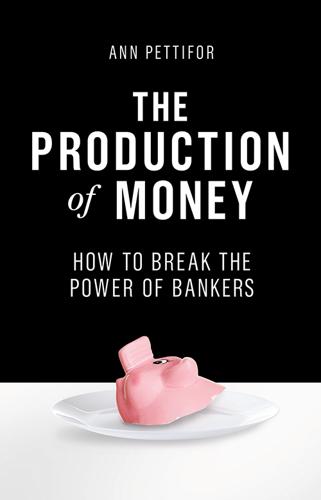
The Production of Money: How to Break the Power of Banks
by
Ann Pettifor
Published 27 Mar 2017
Sadly, the Right are more effective at channelling public anger into the blaming of immigrants, asylum seekers and other bogeymen. And as worrying, sections of the so-called Left are channelling anger at bankers into neoclassical economic policies for resolving the crisis. Some of these proposals for ‘reform’ of the banking system are also discussed in this book. They take the form of ‘fractional reserve banking’, the nationalisation of the money supply and the pursuit of ‘balanced budgets’ for governments. These are policies which owe their origins to the Chicago School and to Friedrich Hayek and Milton Friedman. They would have devastating impacts on the working population and those dependent on government welfare.
…
And yes, the Bank of England confirmed that in a monetary economy the money multiplier (the percentage of deposits that banks are required to hold as reserves against lending) is an incorrect account of the lending process. Bank lending is not constrained by ‘reserves’. The assumption that banks hold reserves equal to a fraction of their lending – ‘fractional reserve banking’ – is wrong. Bank ‘reserves’ are not savings in the sense we understand them. They are resources (resembling an overdraft) made available only to the bankers licensed by the central bank. They are used to facilitate the ‘clearing’ process for settling deposits and liabilities between banks at the end of each day.
…
The purpose must be to ensure that lending is managed to largely preclude speculation, and that decisions about the availability of finance and the setting of interest rates are regulated in such a way as to not discriminate against ‘the makers’ but instead to serve the interests of society, the economy and the ecosystem as a whole. Private deficits cannot finance economic activity The system of fractional reserve banking so enamoured of monetary reformers, implies that bankers would only be allowed to lend the savings or deposits lodged in their vaults by savers or depositors. We know from recent experience that the private sector can move into deficit: that the private sector’s expenditure can exceed income, leading to a fall in savings.
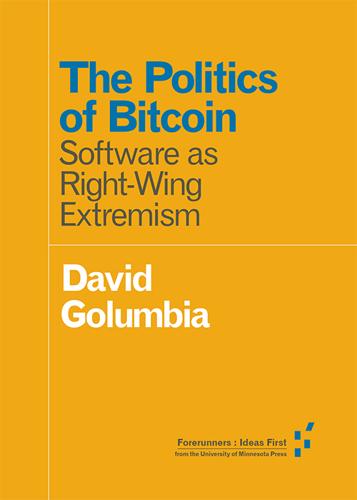
The Politics of Bitcoin: Software as Right-Wing Extremism
by
David Golumbia
Published 25 Sep 2016
To anyone aware of the history of right-wing thought in the United States and Europe, they are shockingly familiar: that central banking such as that practiced by the U.S. Federal Reserve is a deliberate plot to “steal value” from the people to whom it actually belongs; that the world monetary system is on the verge of imminent collapse due to central banking policies, especially fractional reserve banking; that “hard” currencies such as gold provide meaningful protection against that purported collapse; that inflation is a plot to steal money from the masses and hand it over to a shadowy cabal of “elites” who operate behind the scenes; and more generally that the governmental and corporate leaders and wealthy individuals we all know are “controlled” by those same “elites.”
…
Banks must be trusted to hold our money and transfer it electronically, but they lend it out in waves of credit bubbles with barely a fraction in reserve” (Nakamoto 2009). Ironically, Nakamoto seems not to have realized that his belief that Bitcoin would be immune to “debasement” was based on a flawed monetarist definition of inflation, or that Bitcoin itself could fuel credit bubbles and fractional reserve banking. Journalist Nathaniel Popper, in the most thorough history to date of Bitcoin and its connection to these groups (Popper 2015), draws attention to the role of so-called crypto-anarchists and cypherpunks in what would eventually become Bitcoin (for analyses of the direct connections among Bitcoin, cypherpunks, and crypto-anarchists see Boase 2013; DuPont 2014; for this story from the perspective of Bitcoin promoters see Lopp 2016; Redman 2015).
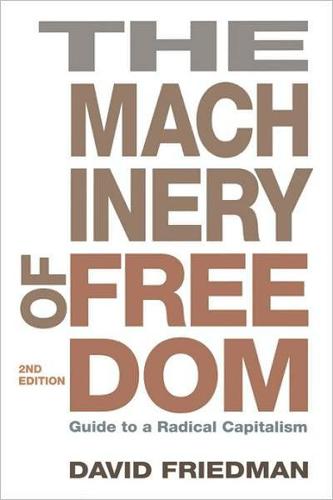
Machinery of Freedom: A Guide to Radical Capitalism
by
David Friedman
Published 2 Jan 1978
The result is a system in which money consists partly of physical commodities (privately minted gold coins) or claims on physical commodities (warehouse receipts) circulating as currency, partly of circulating claims against private fractional reserve banks (bank notes) and partly of non-circulating claims against such banks (checking accounts). This assumes that the fractional reserve banks can offer depositors a reasonable certainty of being able to get their money back if they want it. Most criticisms of private fractional reserve systems depend on their being either unable or unwilling to do so. It is often argued that such a system is inherently unstable; a run due to rumors of weakness in one bank persuades many depositors to withdraw their money, and since the banking system as a whole has obligations much larger than its reserves the banks are unable to pay and the system collapses.
…
Several of the banks did fail, but in most cases the depositors were paid off in full. Another alternative for a private fractional reserve bank, and one used by the Scottish banks, is an option clause. The banks issued notes guaranteeing the bearer "one pound sterling on demand, or in the option of the directors one pound and six pence sterling at the end of six months after day of demand." The customer, by accepting such a note, accepts the bank's right to temporarily suspend payment, provided it pays interest during the interval. Even if private fractional reserve banks can be stable, will they choose to be? Once a bank has built up a reputation for reliability it might pay it to convert that reputation into cash by vastly expanding its deposits without any adequate backing, and then convert that cash from an asset of the corporation to a private asset of its owners and officers, leaving the depositors with a worthless shell.
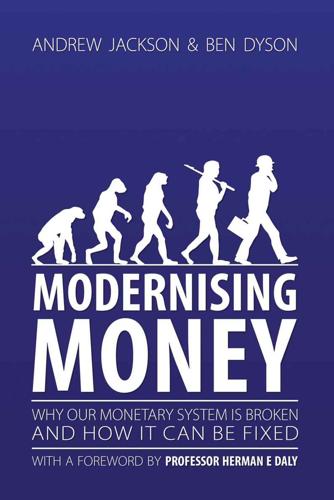
Modernising Money: Why Our Monetary System Is Broken and How It Can Be Fixed
by
Andrew Jackson (economist)
and
Ben Dyson (economist)
Published 15 Nov 2012
Banks would become money brokers, rather than money creators, and the money supply would be stable regardless of whether banks are currently expanding or contracting their lending. Taken together, the reforms end the practice of ‘fractional reserve banking’, a slightly inaccurate term used to describe a banking system where banks promise to repay all customers on demand despite being unable to do so. In late 2010 Mervyn King discussed such ideas in a speech: “A more fundamental, example [of reform] would be to divorce the payment system from risky lending activity – that is to prevent fractional reserve banking … In essence these proposals recognise that if banks undertake risky activities then it is highly dangerous to allow such ‘gambling’ to take place on the same balance sheet as is used to support the payments system, and other crucial parts of the financial infrastructure.
…
In late 2010 Mervyn King discussed such ideas in a speech: “A more fundamental, example [of reform] would be to divorce the payment system from risky lending activity – that is to prevent fractional reserve banking … In essence these proposals recognise that if banks undertake risky activities then it is highly dangerous to allow such ‘gambling’ to take place on the same balance sheet as is used to support the payments system, and other crucial parts of the financial infrastructure. And eliminating fractional reserve banking explicitly recognises that the pretence that risk-free deposits can be supported by risky assets is alchemy. If there is a need for genuinely safe deposits the only way they can be provided, while ensuring costs and benefits are fully aligned, is to insist such deposits do not coexist with risky assets.” (King, 2010) After describing the current system as requiring a belief in ‘financial alchemy’, King went on to say that, “For a society to base its financial system on alchemy is a poor advertisement for its rationality.”
…
This would allow the kind of steady state economy favoured by many environmentalists. Indeed, one of CASSE’s (the Centre for the Advancement of Steady State Economics) fifteen policies for achieving a steady state economy is to “Overhaul banking regulations, starting with gradual elimination of fractional reserve banking, such that the monetary system moves away from a debt structure that requires continuous economic growth.” Why does a reformed system lessen the growth imperative? First, in a reformed system inequality should be lower as ‘rent’ is no longer being paid on the entire money supply. Lower inequality should lower borrowing and working hours by people previously attempting to ‘keep up with the Joneses’’.

The Shifts and the Shocks: What We've Learned--And Have Still to Learn--From the Financial Crisis
by
Martin Wolf
Published 24 Nov 2015
The ideas of the Chicago Plan for monetary and financial reform, or similar radical rearrangements, are, as Mervyn King argues, also intellectually compelling: Another, more fundamental, example [of reform] would be to divorce the payment system from risky lending activity – that is to prevent fractional reserve banking … In essence these proposals recognise that if banks undertake risky activities then it is highly dangerous to allow such ‘gambling’ to take place on the same balance sheet as is used to support the payments system, and other crucial parts of the financial infrastructure. And eliminating fractional reserve banking explicitly recognises that the pretence that risk-free deposits can be supported by risky assets is alchemy. If there is a need for genuinely safe deposits the only way they can be provided, while ensuring costs and benefits are fully aligned, is to insist such deposits do not coexist with risky assets.30 A system that is based, as today, on the ability of profit-seeking institutions to create money as a by-product of often grotesquely irresponsible lending is irretrievably unstable.
…
Chapter Seven will look at how to achieve a better financial system. It will start from the reforms that are now being undertaken and ask whether they will be sufficient to generate a secure future. The discussion will then look at further possible reforms, including much higher capital requirements and proposals to eliminate ‘fractional reserve banking’ altogether. The discussion will conclude by arguing that further radical reform is essential, because the current financial system is inherently dependent on the state. That creates dangerous incentives, ultimately quite likely to destroy the solvency of states. A particularly important aspect of the frailty of finance is its role in generating property bubbles.
…
Again, the so-called ‘mutual assessment programme’ of the G-20 leading economies may have had some influence on securing a better balanced global adjustment process, but it is a small step towards a more rational net flow of capital.23 Again, liquidationists offer an alternative to the new orthodoxy: eliminate controls on cross-border finance, abolish international financial organizations, and go back on to gold. Many in this camp would also abolish fractional reserve banking. This would reduce backing of bank deposits to the supply of gold and increases in the supply of money to whatever mining would produce. To understand how absurd this is, note that the global stock of bank deposits amounted to $54tn at the end of 2010, while the value of the world’s total stock of gold, including jewellery, at prices at the end of 2013 was about $6tn.24 Full gold backing of the broad money supply would require at least a tenfold rise in prices.
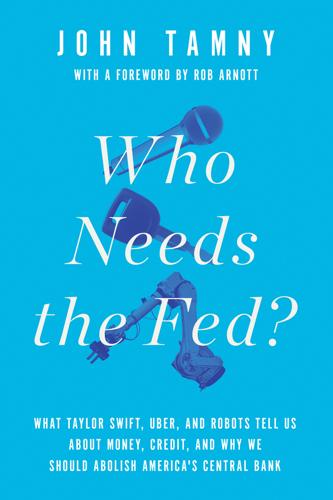
Who Needs the Fed?: What Taylor Swift, Uber, and Robots Tell Us About Money, Credit, and Why We Should Abolish America's Central Bank
by
John Tamny
Published 30 Apr 2016
Rothbard quoted in Ron Paul, “Fractional Reserve Banking, Government, and Moral Hazard,” Financial Sense, July 9, 2012. 3. von Mises, Theory of Money and Credit, 341. 4. Adam Fergusson, When Money Dies: The Nightmare of Deficit Spending, Devaluation, and Hyperinflation in Weimar Germany (New York: Public Affairs, 2010), 113. My emphasis. 5. Ibid., 87. 6. Ibid., 140. My emphasis. 7. von Mises, Theory of Money and Credit, 379. 8. Lawrence W. Reed, Excuse Me, Professor: Challenging the Myths of Progressivism (Washington, D.C.: Regnery, 2015), 154. 9. Ron Paul, “Fractional Reserve Banking, Government, and Moral Hazard,” Financial Sense, July 9, 2012. 10.
…
They say the process whereby banks lend out the majority of funds entrusted to them is fraudulent, that it multiplies money in a destructive, inflationary fashion. Perhaps surprising is that members of the free-market Austrian school are the biggest critics of banks lending out the majority of deposits they take in. As the late Murray Rothbard, a true-blue Austrian, long ago put it, “Fractional reserve banks . . . create money out of thin air. Essentially they do it in the same way as counterfeiters.”2 Underlying Rothbard’s assertion is a fanciful belief that the alleged “money multiplier” is fact. It’s fiction. Wise minds quickly understand that there’s no such thing as a “money multiplier.”
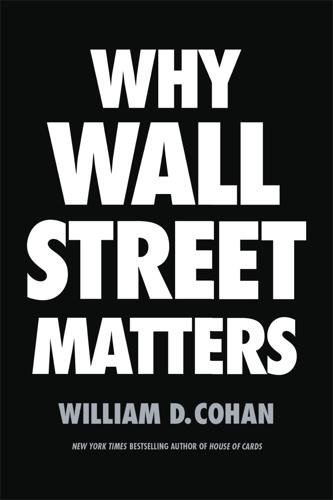
Why Wall Street Matters
by
William D. Cohan
Published 27 Feb 2017
Most people think banks and bankers get rich by not doing very much except moving money around and taking their cut. So let’s get clear on what, exactly, banks actually do. Commercial banks—places with physical branches where customers can deposit and cash checks and keep savings—engage in what is known as “fractional reserve banking,” which sounds perplexing, I know. But the essential idea of it is simple: You keep your money at the bank by having a check directly deposited into an account or by going into a bank branch and depositing a check or cash into an ATM or with a bank teller. These days, of course, you can also use your iPhone to deposit checks.
…
In many ways, banking is the ultimate confidence game: The word “credit” derives from the Latin credere, which means “to believe” or “to trust.” If a banker makes a loan, he or she believes that the borrower will pay the loan back with a sufficient level of interest (and fees) to allow the bank to make a profit. Talk about an act of faith! With ups and downs, this system of fractional reserve banking, incredibly, works fine until it doesn’t. If we all start to fear that somehow we won’t be able to get our money out of the bank when we want it, panic can set in very quickly. That panic becomes a self-fulfilling prophecy, causing the bank to fail because the ensuing stampede drains the bank’s cash, or its ability to borrow, and it can no longer guarantee that we can get our money when we want it.

The Ascent of Money: A Financial History of the World
by
Niall Ferguson
Published 13 Nov 2007
Although it performed the same functions as the Dutch Wisselbank, the Riksbank was also designed to be a Lanebank, meaning that it engaged in lending as well as facilitating commercial payments. By lending amounts in excess of its metallic reserve, it may be said to have pioneered the practice of what would later be known as fractional reserve banking, exploiting the fact that money left on deposit could profitably be lent out to borrowers. Since depositors were highly unlikely to ask en masse for their money, only a fraction of their money needed to be kept in the Riksbank’s reserve at any given time. The liabilities of the bank thus became its deposits (on which it paid interest) plus its reserve (on which it could collect no interest); its assets became its loans (on which it could collect interest).
…
This allows him to introduce two of the core definitions of modern monetary theory: M0 (also known as the monetary base or high-powered money), which is equal to the total liabilities of the central bank, that is, cash plus the reserves of private sector banks on deposit at the central bank; and M1 (also known as narrow money), which is equal to cash in circulation plus demand or ‘sight’ deposits. By the time money has been deposited at three different student banks, M0 is equal to $100 but M1 is equal to $271 ($100 + $90 + $81), neatly illustrating, albeit in a highly simplified way, how modern fractional reserve banking allows the creation of credit and hence of money. The professor then springs a surprise on the first student by asking for his $100 back. The student has to draw on his reserves and call in his loan to the second student, setting off a domino effect that causes M1 to contract as swiftly as it expanded.
…
M3 is broader still, including eurodollar deposits held in offshore markets, and repurchase agreements between banks and other financial intermediaries. The technicalities need not detain us here. The important point to grasp is that with the spread throughout the Western world of a) cashless intra-bank and inter-bank transactions b) fractional reserve banking and c) central bank monopolies on note issue, the very nature of money evolved in a profoundly important way. No longer was money to be understood, as the Spaniards had understood it in the sixteenth century, as precious metal that had been dug up, melted down and minted into coins. Now money represented the sum total of specific liabilities (deposits and reserves) incurred by banks.
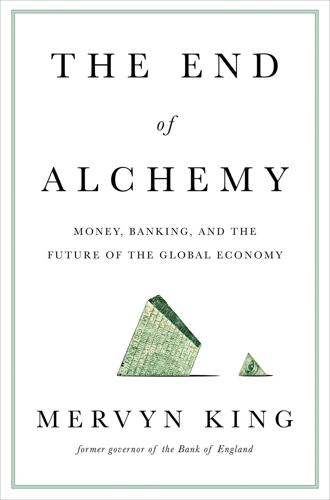
The End of Alchemy: Money, Banking and the Future of the Global Economy
by
Mervyn King
Published 3 Mar 2016
Even though the degree of alchemy of the banking system was much less fifty or more years ago than it is today, it is interesting that many of the most distinguished economists of the first half of the twentieth century believed in forcing banks to hold sufficient liquid assets as reserves to back 100 per cent of their deposits. They recommended ending the system of ‘fractional reserve banking’, under which banks create deposits to finance risky lending and so have insufficient safe cash reserves to back their deposits.12 The elimination of fractional reserve banking was a proposal put forward in 1933 as the ‘Chicago Plan’.13 The proponents of the plan included the brilliant American monetary theorist Irving Fisher and a distinguished group of economists at Chicago such as Frank Knight, Henry Simons and Paul Douglas; later support came from right across the spectrum of post-war economists, ranging from Milton Friedman to James Tobin and Hyman Minsky.14 Interestingly, John Maynard Keynes was not part of this group, largely because Britain did not experience a banking crisis in the 1930s and his focus was on restoring output and employment.15 More recently, a number of economists have proposed variations on the same theme: John Cochrane from Chicago, Jaromir Benes and Michael Kumhof from the IMF, the British economists Andrew Jackson, Ben Dyson and John Kay, Laurence Kotlikoff from Boston and the distinguished FT commentator Martin Wolf.16 There are two ways of looking at these radical approaches to banking reform, one by focusing on the banks’ assets and the other on their liabilities.
…
He closed the Northern Liberator in 1840. 4 Blakey (1839), pp. 58–9. 5 In today’s money roughly equivalent to £5000. 6 In the UK, ring-fencing followed the recommendations of the Independent Commission on Banking chaired by Sir John Vickers, which reported in 2011, and in the US the Dodd-Frank Wall Street Reform and Consumer Protection Act of 2010 included the so-called Volcker rule, which outlawed proprietary trading for their own account by banks. 7 Basel Committee on Banking Supervision, Regulatory Consistency Assessment Program Analysis of Risk-weighted Assets for Credit Risk in the Banking Book, July 2013. 8 Bingham (2010) relates the story of a case in Britain in which neither the lawyers nor the judges realised that the relevant regulations applying to the case at hand had changed between the date of the alleged offence and the date of the hearing because there was no easy way of finding out. 9 Mansfield (1761). 10 Haldane (2013). 11 Information supplied by the Bank of England. 12 A comprehensive survey of proposals to end fractional reserve banking is Lainà (2015). 13 A six-page memorandum describing the plan was circulated confidentially by Henry Simons to about forty individuals in 1933. 14 Fisher (1936a, 1936b), Friedman (1960), Minsky (1994), Tobin (1985). 15 Keynes was nevertheless scathing about bankers. In his memoir of Keynes published by King’s College, Cambridge, in 1949, G.
…
Abe, Shinzo, 363 ABN Amro, 118 Acheson, Dean, 368 Ahmed, Liaquat, The Lords of Finance, 158 AIG, 142, 162 alchemy, financial, 5, 8, 10, 40, 50, 91, 191–2, 257, 261, 263–5, 367, 369; illusion of liquidity, 149–55, 253–5; maturity and risk transformation, 104–15, 117–19, 250–1, 254–5; pawnbroker for all seasons (PFAS) approach, 270–81, 288, 368 Ardant, Henri, 219 Arrow, Kenneth, 79–80, 295 Asian financial crisis (1990s), 28, 349, 350 Asian Infrastructure Investment Bank, 349–50 Australia, 74, 259, 275, 348 Austria, 340, 341 Austro-Hungarian Empire, 216 Bagehot, Walter, 212, 218, 335; Lombard Street (1873), 94–5, 114–15, 188, 189, 190, 191–2, 202, 208, 251, 269 Bank for International Settlements, 31, 255, 276, 324 Bank of America, 103–4, 257 Bank of England, 169, 217, 275, 280, 320–1; Bank Charter Act (1844), 160, 198; during crisis, 36, 37–8, 64, 65, 76, 118, 181–3, 184, 205, 206; Financial Policy Committee, 173; garden at, 73–4; gold reserves, 74, 75, 77, 198; governors of, 6, 12–13, 52–3, 175–6, 178; granting of independence to (1997), 7, 166, 186; history of, 92, 94, 156–7, 159, 160, 180–1, 186, 188–201, 206, 335; inflation targeting policy, 7, 167, 170, 322; Monetary Policy Committee (MPC), 173, 329–31; as Old Lady of Threadneedle Street, 75; weather vane on roof, 181 bank runs, 37–8, 93, 105–8, 187–92, 253–4, 262 Bankia (Spanish bank), 257–8 banking sector: balance sheets, 31, 103–4; capital requirements, 137–9, 255–6, 258, 280; commercial and investment separation, 23, 98, 256, 257; creation of money by, 8, 59–63, 86–7, 91, 161, 253, 263; as dangerous and fragile, 8, 23, 33, 34, 36–7, 91–2, 105, 111, 119, 323–4; deposit insurance, 62, 107–8, 137, 254–5, 328; European universal banks, 23–4; and ‘good collateral’, 188, 190, 202–3, 207, 269; history of, 4–5, 18–19, 59–60, 94–5, 187–202, 206–7; implicit taxpayer subsidy for, 96–7, 107, 116–17, 191–2, 207, 254–5, 263–4, 265–6, 267–8, 269–71, 277; interconnected functions of, 95–6, 111–12, 114–15; levels of equity finance, 103, 105, 109, 112, 137–9, 173, 202, 254–9, 263, 268, 280, 368 see also leverage ratios (total assets to equity capital); liquidity support stigma, 205–7; misconduct scandals, 91, 100, 118, 151, 256; narrow and wide banks, 263–5, 266–7, 279; political influence of, 3, 6, 288–9; recapitalisation of (October 2008), 37–8, 201; taxpayer bailouts during crisis, 4, 38, 41, 43, 93, 94, 106, 118, 162, 243, 247, 261, 267–8; ‘too important to fail’ (TITF), 96–7, 99, 116–17, 118, 254–5, 263–4, 279–80; vast expansion of, 23–4, 31–3, 92–4, 95, 96–9, 115–18; visibility of, 92–3, 94; see also alchemy, financial; central banks; liquidity; regulation Banque de France, 159 Barclays, 95 Barings Bank, 137, 193 ‘behavioural economics’, 132–4, 308, 310 Belgium, 201, 216, 340 Benes, Jaromir, 262 Bergsten, Fred, 234 Berlusconi, Silvio, 225 Bernanke, Ben, 28, 44, 91, 158, 175–6, 183, 188, 287 bills of exchange, 197–8, 199 bitcoins, 282–3 Black, Joseph, 56 Blackett, Basil, 195–6 Blair, Tony, 186 Blakey, Robert, The Political Pilgrim’s Progress (1839), 251–3 Blinder, Alan, 164 BNP Paribas, 35 Brazil, 38 Brecht, Bertolt, The Threepenny Opera (1928), 88, 93 Bremer, Paul, 241 Bretton Woods system, 20–1, 350, 352 British Empire, 216, 217 Bryan, William Jennings, 76, 86–7 Buffett, Warren, 102, 143 building societies, 98 Bunyan, John, Pilgrim’s Progress (1678), 251 Cabaret (film, 1972), 52, 83 Cambodia, 246 Cambridge University, 12, 83, 292–3, 302 Campbell, Mrs Patrick, 220 Campbell-Geddes, Sir Eric, 346 Canada, 116, 167, 170 capitalism, 2, 5, 8, 16–21, 42, 155, 366; as best way to create wealth, 17, 365–6, 369; and end of Cold War, 26–7, 365; money and banking as Achilles heel, 5, 16–17, 23–6, 32–9, 40–1, 50, 369–70; Schumpeter’s ‘creative destruction’, 152; see also market economy Carlyle, Thomas, 16 Carney, Mark, 176 Caruana, Jaime, 324 central banks, 156–9; accountability and transparency, 158, 168, 169–70, 175–6, 178–80, 186, 208; and ‘constrained discretion’, 169–70, 186; creation of ‘emergency money’, 48, 65–6, 71, 86, 172, 182–3, 189, 196–7, 201–7, 247, 275; during crisis, 36–9, 64, 65, 76, 113, 118, 158, 159, 162, 181–4, 205, 206, 335; and disequilibrium, 46–7, 171–2, 175, 208, 329–32; exclusive right to issue paper money, 160, 165, 283; and expectations, 28, 176–8, 304; forecasting by, 179–80, 304–5; future of, 207–10; gold reserves, 74–5, 77, 198; history of, 159–60, 161–2, 180–1; independence of, 5–6, 7, 22, 71, 165–7, 169–70, 185–6, 209–10, 357; industry of private sector watchers, 178; integrated policy framework, 187, 208–9, 288; as ‘lenders of last resort’ (LOLR), 94–5, 109–10, 163, 187–97, 202–7, 208, 259, 268, 269–70, 274–5, 288; and ‘macro-prudential policies’, 173–5, 187; monetary policy rules, 168–9; and money supply, 63, 65–6, 76, 86–7, 162, 163, 180–4, 192, 196–201; pawnbroker for all seasons (PFAS) approach, 270–81, 288, 368; in post-crisis period, 43–4, 63, 76, 162–3, 168–9, 173, 175, 179–80, 183–6; printing of electronic money by, 43, 52, 359; proper role of, 163, 172, 174–5, 287; and swap agreements, 353; see also Bank of England; European Central Bank (ECB); Federal Reserve central planning, 20, 27, 141 Chiang Mai Initiative, 349 ‘Chicago Plan’ (1933), 261–4, 268, 273, 274, 277–8 China, 2–3, 22, 34, 77, 306, 322, 338, 357, 362–3, 364; banking sector, 92, 93; export-led growth strategy, 27–8, 319, 321, 323–4, 356; falling growth rates, 43–4, 324, 363; medieval, 57, 68, 74; one child policy in, 28; problems in financial system, 43–4, 337, 362–3; savings levels in, 27–8, 29, 34; trade surpluses in, 27–8, 46, 49, 319, 321, 329, 364 Chou Enlai, 2 Churchill, Winston, 211, 366 Citigroup, 90, 99, 257 Clark, Kenneth, 193 Clinton, President Bill, 157 Cobbett, William, 71–2 Cochrane, John, 262 Coinage Act, US (1792), 215 Cold War, 26–7, 68, 81–2, 350, 365 Colley, Linda, 213–14 communism, 19, 20, 27 Confucius, 10 Cunliffe, Lord, 178, 193 currencies: break-up of sterling area, 216; dollarisation, 70, 246, 287; ‘fiat’, 57, 283; during government crises, 68–9; monetary unions, 212–18, 238–49 see also European Monetary Union (EMU, euro area); optimal currency areas, 212–13, 215, 217, 248; ‘sterlingisation’ and Scotland, 244–7, 248; US dollar-gold link abandoned (1971), 73; virtual/digital, 282–3; see also exchange rates cybercrime, 282 Cyprus, 363–4 Czech Republic, 216 Debreu, Gerard, 79–80, 295 debt, 140; bailouts as not only response, 343–4; as consequence not cause of crisis, 324–5; forgiveness, 339–40, 346–7; haircut on pledged collateral, 203, 204, 266, 269, 271–2, 275, 277–8, 280; household, 23, 31, 33–4, 35; importance of for real economy, 265–6; as likely trigger for future crisis, 337–8; and low interest rates, 337; quantitative controls on credit, 173, 174–5; rise in external imbalances, 22–3, 24–5, 27–31, 33–4, 45–7, 48–9, 236, 306–7, 319–24, 329–30, 338, 364; and rising asset prices, 23, 24, 31–2; role of collateral, 266–7, 269–81; see also sovereign debt decolonisation process, 215 deflation, 66, 76, 159, 164, 165 demand, aggregate: ‘asymmetric shocks’ to, 213; disequilibrium, 45–9, 316, 319–24, 325–7, 329–32, 335, 358–9; in EMU, 221, 222–3, 229, 230, 236; during Great Stability, 319–24; and Keynesianism, 5, 20, 41, 293, 294–302, 315–16, 325–6, 327, 356; and monetary policy, 30, 41–9, 167, 184–5, 212–13, 221, 229–31, 291–2, 294–302, 319–24, 329–32, 335, 358; nature of, 45, 325; pessimism over future levels, 356, 357–60; price and wage rigidities, 167; and radical uncertainty, 316; rebalancing of, 357, 362–3, 364; saving as source of future demand, 11, 46, 84–5, 185, 325–6, 356; as weak post-crisis, 38–9, 41–2, 44–5, 184–5, 291–2, 337, 350, 356–60 democracy, 26–7, 168, 174, 210, 222, 318, 348, 351; and euro area crisis, 224–5, 231, 234–5, 237–8, 344; and paper money, 68, 77; rise of non-mainstream parties in Europe, 234–5, 238, 344, 352 demographic factors, 354, 355, 362 Denmark, 216–17, 335 derivative instruments, 32–3, 35–6, 90, 93–4, 97–8, 100, 101, 117, 141–5; desert island parable, 145–8 Dickens, Charles, 1, 13–14, 233 disequilibrium: and aggregate demand, 45–9, 316, 319–24, 325–7, 329–32, 335, 358–9; alternative strategies for pre-crisis period, 328–33; and central banks, 11–12, 46–7, 171–2, 175, 208, 329–32; continuing, 42, 45–8, 49, 171–2, 291, 334–5, 347, 353, 356–70; coordinated move to new equilibrium, 347, 357, 359–65; definition of, 8–9; euro area at heart of, 248, 337; and exchange rates, 319, 322–3, 329, 331, 364; high- and low-saving countries (external imbalances), 22–3, 24–5, 27–31, 33–4, 45–7, 48–9, 236, 307, 319–24, 329–30, 338, 364; in internal saving and spending, 45–8, 49, 313–16, 319–21, 324, 325–6, 329–30, 356; and ‘New Keynesian’ models, 306; the next crisis, 334–5, 336–8, 353, 370; and paradox of policy, 48, 326, 328, 333, 357, 358; and stability heuristic, 312–14, 319–21, 323, 331, 332; suggested reform programme, 359–65 division of labour (specialisation), 18, 54–5 Doha Round, 361 Domesday Book, 54, 85 dotcom crash, 35 ‘double coincidence of wants’, 55, 80, 82 Douglas, Paul, 262 Draghi, Mario, 225, 227, 228 Dyson, Ben, 262 econometric modelling, 90, 125, 305–6 economic growth: conventional analysis, 44–5, 47; as low since crisis, 11, 43–4, 290–2, 293, 324, 348, 353–7; origins of, 17–21; pessimism over future levels, 353–7; in pre-crisis period, 329, 330–1, 351–2; slowing of in China, 43–4, 324, 362; stability in post-war period, 317–18 economic history, 4–5, 15–21, 54–62, 67–77, 107–9, 158–62, 180–1, 206–7, 215–17, 317–18; 1797 crisis in UK, 75; 1907 crisis in US, 159, 161, 196, 197, 198, 201; 1914 crisis, 192–201, 206, 307, 368; 1920-1 depression, 326–7; 1931 crisis, 41; ‘Black Monday’ (19 October 1987), 149; Finnish and Swedish crises (early 1990s), 279; German hyperinflation (early 1920s), 52, 68, 69, 86, 158–9, 190; Latin American debt crisis (1980s), 339; London banking crises (1825-66), 92, 188–90, 191–2, 198, 201; panic of 1792 in US, 188; see also Great Depression (early 1930s) The Economist magazine, 108–9 economists, 78–80, 128–31, 132–4, 212, 311; 1960s evolution of macroeconomics, 12, 16; forecasting models, 3–4, 7, 122–3, 179–80, 208, 305–6; Keynes on, 158, 289; see also Keynesian economics; neoclassical economics Ecuador, 246, 287 Egypt, ancient, 56, 72 Eliot, T.S., Four Quartets, 120, 290 emerging economies, 39, 43, 337, 338, 361; export-led growth strategy, 27–8, 30, 34, 319, 321, 324, 349, 356; new institutions in Asia, 349–50; savings levels in, 22–3, 27–8, 29, 30; ‘uphill’ flows of capital from, 30–1, 40, 319; US dollar reserves, 28, 34, 349 ‘emotional finance’ theory, 133–4 Engels, Friedrich, 19 Enron, 117 equity finance, 36, 102, 103, 140, 141, 143, 266, 280; and ‘bail-inable’ bonds, 112; in banking sector, 103, 105, 109, 112, 137–9, 173, 202, 254–9, 263, 268, 280, 368 see also leverage ratios (total assets to equity capital); and limited liability, 107, 108, 109 European Central Bank (ECB), 137, 162, 166, 232, 339; and euro area crisis, 203–4, 218, 224–5, 227–8, 229, 231, 322; and political decisions, 218, 224–5, 227–8, 231–2, 235, 344; sovereign debt purchases, 162, 190, 227–8, 231 European Monetary Union (EMU, euro area), 62, 217–38, 337–40, 342–9, 363–4; creditor and debtor split, 49, 222–3, 230–1, 232–7, 338, 339–40, 342–4, 363–4; crisis in (from 2009), 138, 203–4, 218, 223–31, 237–8, 276, 338, 339–40, 3512, 368; disillusionment with, 234–5, 236, 238, 3444; divergences in competitiveness, 221–3, 228, 231, 232–3, 234; fiscal union proposals (2015), 344; at heart of world disequilibrium, 248, 337; inflation, 70, 221–2, 232, 237; interest rate, 221–2, 232, 237, 335; launch of (1999), 22, 24–5, 218, 221, 306; main lessons from, 237; and political union issues, 218, 220, 235, 237–8, 248–9, 344, 348–9; ‘progress through crisis’ doctrine, 234; prospects for, 232–3, 345–6; sovereign debt in, 162, 190, 224, 226–8, 229–31, 258, 338, 339–40, 342–4; transfer union proposal, 224, 230, 231, 233, 234, 235, 237, 344; unemployment in, 45, 226, 228, 229–30, 232, 234, 345; value of euro, 43, 228–9, 231, 232, 322 European Stability Mechanism (ESM), 228 European Union, 40, 235–6, 237–8, 247, 248–9, 348–9; no-bailout clause in Treaty (Article 125), 228, 235–6; Stability and Growth Pact (SGP), 235, 236 Exchange Rate Mechanism (ERM), 219, 220 exchange rates: and disequilibrium, 319, 322–3, 329, 331, 364; and EMU, 222, 228–9, 338–9, 363–4; exchange controls, 21, 339; fixed, 20–1, 22–3, 24–5, 72–3, 75–6, 339, 352, 353, 361; floating, 21, 338, 353, 361–2; and ‘gold standard’, 72–3, 75–6; risk of ‘currency wars’, 348; and wage/price changes, 213 Federal Deposit Insurance Corporation (FDIC), 62, 137, 328 Federal Open Market Committee, 179 Federal Reserve, 45, 65, 74, 137, 157–8, 162, 168–70, 175, 178–9, 320; in 1920s/30s, 192, 326–7, 328, 349; during crisis, 39, 76, 107, 113, 183, 184; discount window, 206; dual mandate of, 167–8; opening of (1914), 60, 62, 159–60, 194–5, 196, 197 Ferrer, Gaspar, 193 Field, Alexander, 355 Financial Conduct Authority, UK, 260 financial crises, 11–12, 34; and demand for liquidity, 65–6, 76–7, 86, 106, 110, 119, 148, 182, 187–92, 194, 201–7, 253–4, 367; differing causes of, 307, 316–17, 327–8; frequency of, 2, 4, 20, 92, 111, 316–17; and ‘gold standard’, 75, 165, 195; and Minsky’s theory, 307–8, 323; narrative revision downturns, 328, 332–3, 356, 357, 58–9, 364; the next crisis, 334–5, 336–8, 353, 370; as test beds for new ideas, 49–50; see also economic history financial crisis (from 2007): articles and books, 1–2, 6; central banks during, 36–9, 64, 65, 76, 113, 118, 158, 159, 162, 181–4, 205, 206, 335; desire to blame individuals, 3, 89–90; effects on ordinary citizens, 6, 13, 41; the Great Panic, 37–8; interest rates during, 150–1, 181, 335; LIBOR during, 150–1; liquidity crisis (2007-8), 35–8, 64–5, 76, 110; money supply during, 181–3; parallels with earlier events, 90–2, 193; post-crisis output gap, 42, 291, 337; short-term Keynesian response, 39, 41, 48, 118–19, 326, 328, 356; ‘small’ event precipitating, 34–5, 323; unanswered questions, 39–43; underlying causes, 16–17, 24–5, 26–39, 40, 307, 319–26, 328; weak recovery from, 43–4, 48, 291–2, 293, 324, 337, 355, 364, 366 financial markets, 64–5, 113, 117–18, 141–5, 149, 184, 199–200, 314–15; basic financial contracts, 140–1; desert island parable, 145–8; and radical uncertainty, 140, 143, 144–5, 149–55; ‘real-time’ trading, 153–4, 284; see also derivative instruments; financial products and instruments; trading, financial financial products and instruments, 24, 35–6, 64, 99–100, 114, 117, 136–7, 258, 278, 288; see also derivative instruments Finland, 159, 279 First World War, 88–9, 153, 164, 178, 200–2, 307; financial crisis on outbreak of, 192–201; reparations after, 340–2, 343, 345–6 fiscal policy, 45, 184, 347–8, 352, 358; and Keynesianism, 78, 181, 292, 300, 356; in monetary unions, 222–3, 235; short-term stimulus during crisis, 39, 118–19, 356 Fisher, Irving, 163, 261 fractional reserve banking, 261 France, 93, 201, 216, 219, 221, 236, 248, 348, 364; and euro area crisis, 228–9, 231, 236, 322; occupation of Ruhr (1923), 340; overseas territories during WW2, 242; revolutionary period, 68, 75, 159 Franklin, Benjamin, 58, 127 Friedman, Milton, 78, 130, 163, 182, 192, 262, 328 Fuld, Dick, 89 futures contracts, 142, 240–1, 295–6 G20 group, 39, 255, 256, 351 G7 group, 37–8, 351 Garrett, Scott, 168–9 Geithner, Timothy, 267 George, Eddie, 176, 330 Germany, 93, 161, 162, 184, 219, 322, 341, 357; Bundesbank, 166, 219, 228, 232; and EMU, 219–22, 224, 227, 228, 230, 231–2, 234–6, 248, 338, 340, 342–3, 345; export-led growth strategy, 222, 319, 363–4; hyperinflation (early 1920s), 52, 68, 69, 86, 158–9, 190; Notgeld in, 201–2, 287; reunification, 219, 342; trade surpluses in, 46, 49, 222, 236, 319, 321, 356, 363–4; WW1 reparations, 340–2, 343, 346 Gibbon, Edward, 63, 164 Gigerenzer, Professor Gerd, 123, 135 Gillray, James, 75 global economy, 349–54, 361; capital flows, 20–1, 22, 28, 29, 30–1, 40, 319, 323; rise in external imbalances, 22–3, 24–5, 27–31, 33–4, 45–7, 48–9, 236, 307, 319–24, 329–30, 338, 364; see also currencies; exchange rates; trade surpluses and deficits Goethe, Johann Wolfgang von, Faust, 85–6 ‘gold standard’, 72–3, 75–6, 86, 165, 195, 200–1, 216–17, 348, 352 Goldman Sachs, 98, 109, 123, 257 Goodwin, Fred, 37, 89 Grant, James, 327 Great Depression (early 1930s), 5, 16, 20, 158, 160, 226, 348, 355; dramatic effect on politics and economics, 41; Friedman and Schwartz on, 78, 192, 328; and ‘gold standard’, 73, 76; US banking crisis during, 90–1, 108, 116, 201 Great Recession (from 2008), 6, 38–9, 163, 290–2, 326 Great Stability (or Great Moderation), 6, 22, 45–7, 71, 162, 208, 305, 313–14, 318–24, 325–6; alternative strategies for pre-crisis period, 328–33; monetary policies during, 22, 25, 46–7, 315 Greece, 216, 221, 222, 225–31, 338–40, 364; agreement with creditors (13 July 2015), 230–1, 346; crisis in euro area, 223–4, 225–7, 229, 230–1, 236, 258, 338–40; debt restructured (2012), 226–7, 229, 236, 339, 343–4, 346; national referendum (July 2015), 230; sovereign debt, 224, 226–7, 339–40, 342–4, 346–7; Syriza led government, 229, 235 Greenspan, Alan, 157–8, 164, 175, 317 Gulf War, First (1991), 238 Hahn, Frank, 79 Halifax Bank of Scotland (HBoS), 37, 118, 206, 243 Halley, Edmund, 122 Hamilton, Alexander, 188, 202, 215 Hankey, Thomas, 191–2 Hansen, Alvin, Full Recovery or Stagnation?
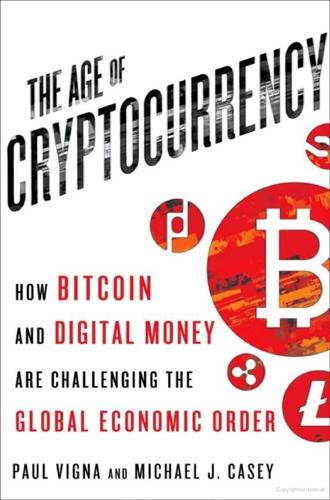
The Age of Cryptocurrency: How Bitcoin and Digital Money Are Challenging the Global Economic Order
by
Paul Vigna
and
Michael J. Casey
Published 27 Jan 2015
The privately owned bank—the BOE was not nationalized until after the Second World War—would lend the Crown £1.2 million, a massive sum for its time, and could then issue banknotes against that debt, effectively relending the money. Then, to give the banknotes value as a de facto currency, the sovereign agreed to accept them in payment of taxes. In one fell swoop, the agreement created a form of paper money effectively endorsed by the sovereign, established fractional-reserve banking—a guiding principle of modern banking that allows regulated banks to relend most of the money they take in as deposits—and conceived the idea of a central bank. The Bank of England had, in effect, been given a license to print money. This was the dawn of modern banking, and it had a profound impact on England’s economy.
…
Underpinning these transactions are the traditional mainstays of the economy and symbols of national power: banknotes and coins. Banks are required by their regulators—the Fed in the United States, the European Central Bank in the euro zone, the Prudential Regulation Authority in the United Kingdom—to carry a minimum ratio of cash reserves to deposits in case depositors demand their funds back in paper form. Fractional reserve banking, which allows banks to relend funds and “create” private, credit-fueled money, means the amount of debt in the economy is actually many times these cash balances. Nonetheless, the law requires that there be a proportional amount of cash held dormant within the financial system to sustain all that debt.
…
But Tradehill lost more than $100,000 due to the complications with Dwolla, and with legal bills mounting, the low trading fees that Tradehill was forced to charge to remain competitive weren’t enough for it to turn a profit. By the summer of 2012 Kenna was unable to meet payroll and knew he had to shut the exchange down. Kenna had to return all the money his customers had entrusted to Tradehill and shut down the exchange. The only other option was to “turn into a fractional-reserve bank,” he said jokingly, referring to the bank model that allows banks to lend out deposits while holding only a fraction of those funds in reserve. “They call it a Ponzi scheme unless you have a banking license.” He’d sunk everything he had into Tradehill. Now, he was broke, so broke that he couldn’t afford rent.

People, Power, and Profits: Progressive Capitalism for an Age of Discontent
by
Joseph E. Stiglitz
Published 22 Apr 2019
Then, a “seed bank” could give seed to a farmer wanting to plant more only if some other farmer had given the bank seed to lend out. But for several hundred years, banks have realized that they can create accounts, knowing that only a fraction of them will be called in at any one time. We evolved into a system of what is called fractional reserve banking, where the amount that banks hold in reserves is just a fraction of what they owe. Today, this system works because we rely on government to ensure that the reserves are sufficient, that what is not in reserves has been prudently managed, and to step in when there is a shortfall. Even if lending was not the most lucrative of the banks’ activities, bankers made a pretty penny lending out money—not only because what they lent out carried a higher interest rate than what they paid to depositors, but also because they could create loans essentially out of thin air.
…
Federal Election Commission, 166, 169–70, 172 class warfare, 6 climate change and attacks on truth, 20 and intergenerational justice, 204–5 markets’ failure to address, xxiii money’s effects on debate, 20 Clinton, Bill, and administration, xiii, 4, 5, 168, 238, 242 Clinton, Hillary, 4, 6 coal companies, 20 Cold War, end of, 28; See also Communism, collapse of collective action, 138–56 balancing with individualism, 139 circumstances requiring, 140–42 government failures, 148–52 increasing need for government action, 152–55 in preamble to Constitution, 138–39 regulation as, 143–48 collective judgments, 262–63n20 college, income inequality and, 200 Comcast, 147 Communications Decency Act, 320n32 Communism, collapse of, 3, 28 comparative advantage, 82–84 competition market concentration, 55–56 market failures, 23 in marketplace of ideas, 75–76 market power, 57–60 power vs., 22 competitive equilibrium model, 47, 280n1 Comprehensive and Progressive Agreement for Trans-Pacific Partnership, 306n25 compulsion, power of, 155 confirmatory bias, 225 conflicts of interest, 70, 72, 124 Congress antitrust laws, 51, 68 and Great Recession, 39, 215 and lobbyists, See lobbyists and money in politics, 171–72 and Obamacare, 213 and regulatory process, 145–46 Supreme Court nominations, 166 and USTR, 100 conservatism, embracing change vs., 226–28 Constitution of the United States collective action reference in preamble, 138–39 economic changes since writing of, 227 “General Welfare” in Preamble, 242 individual liberties vs. collective interest in, 229 and minority rights, 6 as product of reasoning and argumentation, 229 three-fifths clause, 161 consumer demand, See demand consumer surplus, 64 cooperatives, 245 Copenhagen Agreement, 207 copyright extensions, 74 Copyright Term Extension Act (1998), 74 corporate taxes, 108, 206, 269n44 corporate tax rates, globalization and, 84–85 corporate welfare, 107 corporations and labor force participation, 182 and money in politics, 172–73 as people, 169–70 rights as endowed by the State, 172 corruption, 50 cost-benefit analysis, 146, 204–5 Council of Economic Advisers (CEA), xii credit, 102, 145, 186, 220 credit cards, 59–60, 70, 105 credit default swaps, 106 credit unions, 245 culture, economic behavior and, 30 customer targeting, 125–26 cybersecurity, 127–28 cybertheft, 308n35 Daraprim, 296n72 data exclusivity, 288n40 data ownership, 129–30 Deaton, Angus, 41–42 debt, 220; See also credit DeepMind, 315n1 defense contractors, 173 deficits, See budget deficits deglobalization, 92 deindustrialization early days of, xix effect on average citizens, 4, 21 facilitating transition to postindustrial world, 186–88 failure to manage, xxvi in Gary, Indiana, xi globalization and, 4, 79, 87 place-based policies and, 188 deliberation, 228–29 demand automation and, 120 and job creation, 268n41 Keynesian economics and, xv market power’s effect on, 63 demand for labor, technological suppression of, 122 democracy, 159–78 agenda for reducing power of money in politics, 171–74 curbing the influence of wealth on, 176–78 fragility of norms and institutions, 230–36 inequality as threat to, 27–28 maintaining system of checks and balances, 163–67 need for a new movement, 174–76 new technologies’ threat to, 131–35 and power of money, 167–70 as shared value, 228 suppression by minority, xx Trump’s disdain for, xvii voting reforms, 161–63 democratic institutions, fragility of, 230–36 Democratic Party gerrymandering’s effect on, 159 and Great Recession, 152 need for reinvention of, 175 popular support for, 6 renewal of, 242 and voter disenfranchisement, 162 demographics, xx, 181 “deplorables,” 4 deregulation, 25, 105, 143–44, 152, 239; See also supply-side economics derivatives, 80, 88, 106–7, 144 Detroit, Michigan, 188 Dickens, Charles, 12 Digital Millennium Copyright Act, 320–21n32 disadvantage, intergenerational transmission of, 199–201 disclosure laws, 171 discourse, governance and, 11 discrimination, 201–4; See also gender discrimination; racial discrimination by banks, 115 and economics texts, 23 forms of, 202 under GI Bill, 210 and inequality, 40–41, 198–99 and labor force participation, 183 means of addressing, 203–4 and myths about affirmative action, 225 reducing to improve economy, 201–4 diseases of despair, 42–43 disenfranchisement, 27, 161–62 disintermediation, 109 Disney, 65, 74 dispute resolution, 56–57, 309n40 Dodd–Frank Wall Street Reform and Consumer Protection Act, 70, 102, 107 driverless cars, 118 drug overdoses, 42 Durbin Amendment, 70 East Asia, 149 economic justice historical perspectives, 241–42 intergenerational justice, 204–5 racial justice and, 176, 203–4 tax system and, 205–8 economics, assumptions about individuals in, 29–30, 223 economic segregation, 200 economies of scale, 72 economies of scope, 347–48n15 economy and collective action, 153–54 decent jobs with good working conditions, 192–97 deterioration since early 1980s, 32–46 failure’s effect on individuals and society, 29–31 failure since late 1980s, 3–5 government involvement in, 141–42, 150–55 intergenerational transmission of advantage/disadvantage, 199–201 reducing discrimination in, 201–4 restoring fairness to tax system, 205–8 restoring growth and productivity, 181–86 restoring justice across generations, 204–5 restoring opportunity and social justice, 197–201 social protection, 188–91 “sugar high” from Trump’s tax cut, 236–38 transition to postindustrial world, 186–88 education equalizing opportunity of, xxv–xxvi, 219–20 improving access to, 203 returns on government investment in, 232 taxation and, 25 undermining of institutions, 233–34 Eggers, Dave, 128 Eisenhower, Dwight, and administration, 210 elderly, labor force growth and, 181–82 election of 1992, 4 election of 2000, 165–66 election of 2012, 159, 178 election of 2016, xix, 132, 178 elections, campaign spending in, 171–73 elite control of economy by, 5–6 and distrust in government, 151 and 2008 financial crisis, 5 promises of growth from market liberalization, 21–22 rules written by, 230 employers, market power over workers, 64–67 employment, See full employment; jobs; labor force participation End of History, The (Fukuyama), 3 Enlightenment, the, 10–12 attack on ideals of, 14–22 and standard of living, 264n24 environment carbon tax, 194, 206–7 and collective action, 153 economic growth and, 176 economists’ failure to address, 34 markets’ failure to protect, 24 and true economic health, 34 environmental justice, economic justice and, 176 Environmental Protection Agency (EPA), 267n38 epistemology, 10, 234 equality as basis for well-running economy, xxiv–xxv economic agenda for, xxvii as shared value, 228 Equifax, 130 equity value, rents as portion of, 54 ethnic discrimination, 201–4 Europe data regulation, 128–29 globalization, 81 infrastructure investment, 195–96 privacy protections, 135 trade agreements favoring, 80 unity against Trump, 235 European Investment Bank, 195–96 evergreening, 60 excess profits, as rent, 54 exchange rate, 89, 307n28, 307n32 exploitation in current economy, 26 in economics texts, 23 financial sector and, 113 market power and, 47–78 reducing, 197 as source of wealth, 144–45 wealth creation vs., 34 and wealth redistribution, 50 exports, See globalization; trade wars Facebook anticompetitive practices, 70 and Big Data, 123, 124, 127–28 competition for ad revenue, 56 and conflicts of interest, 124 market power in relaxed antitrust environment, 62 as natural monopoly, 134 and preemptive mergers, 60, 73 reducing market power of, 124 regulation of advertising on, 132 fact-checking, 132, 177 “Fading American Dream, The” (Opportunity Insights report), 44–45 “fake news,” 167 family leave, 197 Farhi, Emmanuel, 62 farmers, Great Depression and, 120 fascism, 15–16, 18, 235 Federal Communication Commission (FCC), 147 Federal Reserve Board, 70, 112 Federal Reserve System, 121, 214–15 Federal Trade Commission, 69 fees bank profits from, 105, 110 credit card, 60, 70, 105 for mergers and acquisitions, 108 mortgages and, 107, 218 “originate-to-distribute” banking model, 110 private retirement accounts and, 215 fiduciary standard, 314n21, 347n10 finance (financial sector); See also banks and American crisis, 101–16 contagion of maladies to rest of economy, 112 disintermediation, 109 dysfunctional economy created by, 105–9 gambling by, 106–8 and government guarantees, 110–11 history of dysfunctionality, 109–12 as microcosm of larger economy, 113 mortgage reform opposed by, 216–18 private vs. social interests, 111–12 and public option, 215–16 shortsightedness of, 104–5 stopping societal harm created by, 103–5 and trade agreements, 80 financial crisis (2008), 101; See also Great Recession bank bailout, See bank bailout [2008] China and, 95 deregulation and, 25, 143–44 as failure of capitalism, 3 government response to, 5 housing and, 216 as man-made failure, 153–54 market liberalization and, 4 and moral turpitude of bankers, 7 regulation in response to, 101–2 as symptomatic of larger economic failures, 32–33 and unsustainable growth, 35 financial liberalization, See market liberalization First National Bank, 101 “fiscal paradises,” 85–86 fiscal policy, 121, 194–96 fiscal responsibility, 237 food industry, 182 forced retirement, 181–82 Ford Motor Company, 120 Fox News, 18, 133, 167, 177 fractional reserve banking, 110–11 fraud, 103, 105, 216, 217 freedom, regulation and, 144 free-rider problem, 67, 155–56, 225–26 Friedman, Milton, 68, 314–15n22 FUD (fear, uncertainty, and doubt), 58 Fukuyama, Francis, 3, 259n1 full employment, 83, 193–94, 196–97 Galbraith, John K., 67 gambling, by banks, 106–7, 207 Garland, Merrick, 166–67 Gates, Bill, 5, 117 GDP elites and, 22 as false measure of prosperity, 33, 227 financial sector’s increasing portion of, 109 Geithner, Tim, 102 gender discrimination, 41, 200–204 gene patents, 74–75 general welfare, 242–47 generic medicines, 60, 89 genetically modified food (GMO), 88 genetics, 126–27 George, Henry, 206 Germany, 132, 152 gerrymandering, 6, 159, 162 GI Bill, 210 Gilded Age, 12, 246 Glass-Steagall Act, 315n25, 341n39 globalization, 79–100 budget deficits and trade imbalances, 90 collective action to address, 154–55 effect on average citizens, 4, 21 in era of AI, 135 failure to manage, xxvi false premises about, 97–98 and global cooperation in 21st century, 92–97 and intellectual property, 88–89 and internet legal frameworks, 135 and low-skilled workers, 21, 82, 86, 267n39 and market power, 61 pain of, 82–87 and protectionism, 89–92 and 21st-century trade agreements, 87–89 and tax revenue, 84–86 technology vs., 86–87 and trade wars, 93–94 value systems and, 94–97 GMO (genetically modified food), 88 Goebbels, Joseph, 266n35 Goldman Sachs, 104 Google AlphaGo, 315n1 antipoaching conspiracy, 65 and Big Data, 123, 127, 128 conflicts of interest, 124 European restrictions on data use, 129 gaming of tax laws by, 85 market power, 56, 58, 62, 128 and preemptive mergers, 60 Gordon, Robert, 118–19 Gore, Al, 6 government, 138–56 assumption of mortgage risk, 107 Chicago School’s view of, 68–69 debate over role of, 150–52 and educational system, 220 failure of, 148–52 in finance, 115–16 and fractional reserve banking, 111 and Great Depression, 120 hiring of workers by, 196–97 increasing need for, 152–55 interventions during economic downturns, 23, 120 lack of trust in, 151 lending guarantees, 110–11 managing technological change, 122–23 and need for collective action, 140–42 and political reform, xxvi pre-distribution/redistribution by, xxv in progressive agenda, 243–44 public–private partnerships, 142 regulation and rules, 143–48 restoring growth and social justice, 179–208 social protection by, 231 government bonds, 215 Great Britain, wealth from colonialism, 9 Great Depression, xiii, xxii, 13, 23, 120 “great moderation,” 32 Great Recession, xxvi; See also financial crisis (2008) deregulation and, 25 diseases of despair, 42 elites and, 151 employment recovery after, 193 inadequate fiscal stimulus after, 121 as market failure, 23 pace of recovery from, 39–40 productivity growth after, 37 and retirement incomes, 214–15 weak social safety net and, 190 Greenspan, Alan, 112 Gross Fixed Capital Formation, 271n4 gross investment, 271n4 growth after 2008 financial crisis, 103 in China, 95 decline since 1980, 35–37 economic agenda for, xxvii failure of financial sector to support, 115 and inequality, 19 international living standard comparisons, 35–37 knowledge and, 183–86 labor force, 181–82 market power as inimical to, 62–64 in post-1970s US economy, 32 restoring, 181–86 taxation and, 25 guaranteed jobs, 196–97 Harvard University, 16 Hastert Rule, 333n31 health inequality in, 41–43 and labor force participation, 182 health care and American exceptionalism, 211–12 improving access to services, 203 public option, 210–11 in UK and Europe, 13 universal access to, 212–13 hedonic pricing, 347n13 higher education, 219–20; See also universities Hispanic Americans, 41 hi-tech companies, 54, 56, 60, 73 Hitler, Adolf, 152, 266n35 Hobbes, Thomas, 12 home ownership, 216–18 hours worked per week, US ranking among developed economies, 36–37 House of Representatives, 6, 159 housing, as barrier to finding new jobs, 186 housing bubble, 21 housing finance, 216–18 human capital index (World Bank), 36 Human Development Index, 36 Human Genome Project, 126 hurricanes, 207 IA (intelligence-assisting) innovations, 119 identity, capitalism’s effect on, xxvi ideology, science replaced by, 20 immigrants/immigration, 16, 181, 185 imports, See globalization; trade wars incarceration, 161, 163, 193, 201, 202 incentive payments for teachers, 201 voting reform and, 162–63 income; See also wages average US pretax income (1974-2014), 33t universal basic income, 190–91 income inequality, 37, 177, 200, 206 income of capital, 53 India, guaranteed jobs in, 196–97 individualism, 139, 225–26 individual mandate, 212, 213 industrial policies, 187 industrial revolution, 9, 12, 264–65n24 inequality; See also income inequality; wealth inequality benefits of reducing, xxiv–xxv and current politics, 246 in early years after WWII, xix economists’ failure to address, 33 education system as perpetuator of, 219 and election of 2016, xix–xxi and excess profits, 49 and financial system design, 198 growth of, xii–xiii, 37–45 in health, 41–43 in opportunity, 44–45 in race, ethnicity, and gender, 40–41 and 2017 tax bill, 236–37 technology’s effect on, 122–23 in 19th and early 20th century, 12–13 20th-century attempts to address, 13–14 tolerance of, 19 infrastructure European Investment Bank and, 195–96 fiscal policy and, 195 government employment and, 196–97 public–private partnerships, 142 returns on investment in, 195, 232 taxation and, 25 and 2017 tax bill, 183 inheritance tax, 20 inherited wealth, 43, 278n38 innovation intellectual property rights and, 74–75 market power and, 57–60, 63–64 net neutrality and, 148 regulation and, 134 slowing pace of, 118–19 and unemployment, 120, 121 innovation economy, 153–54 insecurity, social protection to address, 188–91 Instagram, 70, 73, 124 institutions fragility of, 230–36 in progressive agenda, 245 undermining of, 231–33 insurance companies, 125 Intel, 65 intellectual property rights (IPR) China and, 95–96 globalization and, 88–89, 99 and stifling of innovation, 74–75 and technological change, 122 in trade agreements, 80, 89 intelligence-assisting (IA) innovations, 119 interest rates, 83, 110, 215 intergenerational justice, 204–5 intergenerational transmission of advantage/disadvantage, xxv–xxvi, 199–201, 219 intermediation, 105, 106 Internal Revenue Service (IRS), 217 International Monetary Fund, xix internet, 58, 147 Internet Explorer, 58 inversions, 302n10 investment buybacks vs., 109 corporate tax cuts and, 269n44 and intergenerational justice, 204 long-term, 106 weakening by monopoly power, 63 “invisible hand,” 76 iPhone, 139 IPR, See intellectual property rights Ireland, 108 IRS (Internal Revenue Service), 217 Italy, 133 IT sector, 54; See also hi-tech companies Jackson, Andrew, 101, 241 Janus v.
…
Federal Election Commission, 166, 169–70, 172 class warfare, 6 climate change and attacks on truth, 20 and intergenerational justice, 204–5 markets’ failure to address, xxiii money’s effects on debate, 20 Clinton, Bill, and administration, xiii, 4, 5, 168, 238, 242 Clinton, Hillary, 4, 6 coal companies, 20 Cold War, end of, 28; See also Communism, collapse of collective action, 138–56 balancing with individualism, 139 circumstances requiring, 140–42 government failures, 148–52 increasing need for government action, 152–55 in preamble to Constitution, 138–39 regulation as, 143–48 collective judgments, 262–63n20 college, income inequality and, 200 Comcast, 147 Communications Decency Act, 320n32 Communism, collapse of, 3, 28 comparative advantage, 82–84 competition market concentration, 55–56 market failures, 23 in marketplace of ideas, 75–76 market power, 57–60 power vs., 22 competitive equilibrium model, 47, 280n1 Comprehensive and Progressive Agreement for Trans-Pacific Partnership, 306n25 compulsion, power of, 155 confirmatory bias, 225 conflicts of interest, 70, 72, 124 Congress antitrust laws, 51, 68 and Great Recession, 39, 215 and lobbyists, See lobbyists and money in politics, 171–72 and Obamacare, 213 and regulatory process, 145–46 Supreme Court nominations, 166 and USTR, 100 conservatism, embracing change vs., 226–28 Constitution of the United States collective action reference in preamble, 138–39 economic changes since writing of, 227 “General Welfare” in Preamble, 242 individual liberties vs. collective interest in, 229 and minority rights, 6 as product of reasoning and argumentation, 229 three-fifths clause, 161 consumer demand, See demand consumer surplus, 64 cooperatives, 245 Copenhagen Agreement, 207 copyright extensions, 74 Copyright Term Extension Act (1998), 74 corporate taxes, 108, 206, 269n44 corporate tax rates, globalization and, 84–85 corporate welfare, 107 corporations and labor force participation, 182 and money in politics, 172–73 as people, 169–70 rights as endowed by the State, 172 corruption, 50 cost-benefit analysis, 146, 204–5 Council of Economic Advisers (CEA), xii credit, 102, 145, 186, 220 credit cards, 59–60, 70, 105 credit default swaps, 106 credit unions, 245 culture, economic behavior and, 30 customer targeting, 125–26 cybersecurity, 127–28 cybertheft, 308n35 Daraprim, 296n72 data exclusivity, 288n40 data ownership, 129–30 Deaton, Angus, 41–42 debt, 220; See also credit DeepMind, 315n1 defense contractors, 173 deficits, See budget deficits deglobalization, 92 deindustrialization early days of, xix effect on average citizens, 4, 21 facilitating transition to postindustrial world, 186–88 failure to manage, xxvi in Gary, Indiana, xi globalization and, 4, 79, 87 place-based policies and, 188 deliberation, 228–29 demand automation and, 120 and job creation, 268n41 Keynesian economics and, xv market power’s effect on, 63 demand for labor, technological suppression of, 122 democracy, 159–78 agenda for reducing power of money in politics, 171–74 curbing the influence of wealth on, 176–78 fragility of norms and institutions, 230–36 inequality as threat to, 27–28 maintaining system of checks and balances, 163–67 need for a new movement, 174–76 new technologies’ threat to, 131–35 and power of money, 167–70 as shared value, 228 suppression by minority, xx Trump’s disdain for, xvii voting reforms, 161–63 democratic institutions, fragility of, 230–36 Democratic Party gerrymandering’s effect on, 159 and Great Recession, 152 need for reinvention of, 175 popular support for, 6 renewal of, 242 and voter disenfranchisement, 162 demographics, xx, 181 “deplorables,” 4 deregulation, 25, 105, 143–44, 152, 239; See also supply-side economics derivatives, 80, 88, 106–7, 144 Detroit, Michigan, 188 Dickens, Charles, 12 Digital Millennium Copyright Act, 320–21n32 disadvantage, intergenerational transmission of, 199–201 disclosure laws, 171 discourse, governance and, 11 discrimination, 201–4; See also gender discrimination; racial discrimination by banks, 115 and economics texts, 23 forms of, 202 under GI Bill, 210 and inequality, 40–41, 198–99 and labor force participation, 183 means of addressing, 203–4 and myths about affirmative action, 225 reducing to improve economy, 201–4 diseases of despair, 42–43 disenfranchisement, 27, 161–62 disintermediation, 109 Disney, 65, 74 dispute resolution, 56–57, 309n40 Dodd–Frank Wall Street Reform and Consumer Protection Act, 70, 102, 107 driverless cars, 118 drug overdoses, 42 Durbin Amendment, 70 East Asia, 149 economic justice historical perspectives, 241–42 intergenerational justice, 204–5 racial justice and, 176, 203–4 tax system and, 205–8 economics, assumptions about individuals in, 29–30, 223 economic segregation, 200 economies of scale, 72 economies of scope, 347–48n15 economy and collective action, 153–54 decent jobs with good working conditions, 192–97 deterioration since early 1980s, 32–46 failure’s effect on individuals and society, 29–31 failure since late 1980s, 3–5 government involvement in, 141–42, 150–55 intergenerational transmission of advantage/disadvantage, 199–201 reducing discrimination in, 201–4 restoring fairness to tax system, 205–8 restoring growth and productivity, 181–86 restoring justice across generations, 204–5 restoring opportunity and social justice, 197–201 social protection, 188–91 “sugar high” from Trump’s tax cut, 236–38 transition to postindustrial world, 186–88 education equalizing opportunity of, xxv–xxvi, 219–20 improving access to, 203 returns on government investment in, 232 taxation and, 25 undermining of institutions, 233–34 Eggers, Dave, 128 Eisenhower, Dwight, and administration, 210 elderly, labor force growth and, 181–82 election of 1992, 4 election of 2000, 165–66 election of 2012, 159, 178 election of 2016, xix, 132, 178 elections, campaign spending in, 171–73 elite control of economy by, 5–6 and distrust in government, 151 and 2008 financial crisis, 5 promises of growth from market liberalization, 21–22 rules written by, 230 employers, market power over workers, 64–67 employment, See full employment; jobs; labor force participation End of History, The (Fukuyama), 3 Enlightenment, the, 10–12 attack on ideals of, 14–22 and standard of living, 264n24 environment carbon tax, 194, 206–7 and collective action, 153 economic growth and, 176 economists’ failure to address, 34 markets’ failure to protect, 24 and true economic health, 34 environmental justice, economic justice and, 176 Environmental Protection Agency (EPA), 267n38 epistemology, 10, 234 equality as basis for well-running economy, xxiv–xxv economic agenda for, xxvii as shared value, 228 Equifax, 130 equity value, rents as portion of, 54 ethnic discrimination, 201–4 Europe data regulation, 128–29 globalization, 81 infrastructure investment, 195–96 privacy protections, 135 trade agreements favoring, 80 unity against Trump, 235 European Investment Bank, 195–96 evergreening, 60 excess profits, as rent, 54 exchange rate, 89, 307n28, 307n32 exploitation in current economy, 26 in economics texts, 23 financial sector and, 113 market power and, 47–78 reducing, 197 as source of wealth, 144–45 wealth creation vs., 34 and wealth redistribution, 50 exports, See globalization; trade wars Facebook anticompetitive practices, 70 and Big Data, 123, 124, 127–28 competition for ad revenue, 56 and conflicts of interest, 124 market power in relaxed antitrust environment, 62 as natural monopoly, 134 and preemptive mergers, 60, 73 reducing market power of, 124 regulation of advertising on, 132 fact-checking, 132, 177 “Fading American Dream, The” (Opportunity Insights report), 44–45 “fake news,” 167 family leave, 197 Farhi, Emmanuel, 62 farmers, Great Depression and, 120 fascism, 15–16, 18, 235 Federal Communication Commission (FCC), 147 Federal Reserve Board, 70, 112 Federal Reserve System, 121, 214–15 Federal Trade Commission, 69 fees bank profits from, 105, 110 credit card, 60, 70, 105 for mergers and acquisitions, 108 mortgages and, 107, 218 “originate-to-distribute” banking model, 110 private retirement accounts and, 215 fiduciary standard, 314n21, 347n10 finance (financial sector); See also banks and American crisis, 101–16 contagion of maladies to rest of economy, 112 disintermediation, 109 dysfunctional economy created by, 105–9 gambling by, 106–8 and government guarantees, 110–11 history of dysfunctionality, 109–12 as microcosm of larger economy, 113 mortgage reform opposed by, 216–18 private vs. social interests, 111–12 and public option, 215–16 shortsightedness of, 104–5 stopping societal harm created by, 103–5 and trade agreements, 80 financial crisis (2008), 101; See also Great Recession bank bailout, See bank bailout [2008] China and, 95 deregulation and, 25, 143–44 as failure of capitalism, 3 government response to, 5 housing and, 216 as man-made failure, 153–54 market liberalization and, 4 and moral turpitude of bankers, 7 regulation in response to, 101–2 as symptomatic of larger economic failures, 32–33 and unsustainable growth, 35 financial liberalization, See market liberalization First National Bank, 101 “fiscal paradises,” 85–86 fiscal policy, 121, 194–96 fiscal responsibility, 237 food industry, 182 forced retirement, 181–82 Ford Motor Company, 120 Fox News, 18, 133, 167, 177 fractional reserve banking, 110–11 fraud, 103, 105, 216, 217 freedom, regulation and, 144 free-rider problem, 67, 155–56, 225–26 Friedman, Milton, 68, 314–15n22 FUD (fear, uncertainty, and doubt), 58 Fukuyama, Francis, 3, 259n1 full employment, 83, 193–94, 196–97 Galbraith, John K., 67 gambling, by banks, 106–7, 207 Garland, Merrick, 166–67 Gates, Bill, 5, 117 GDP elites and, 22 as false measure of prosperity, 33, 227 financial sector’s increasing portion of, 109 Geithner, Tim, 102 gender discrimination, 41, 200–204 gene patents, 74–75 general welfare, 242–47 generic medicines, 60, 89 genetically modified food (GMO), 88 genetics, 126–27 George, Henry, 206 Germany, 132, 152 gerrymandering, 6, 159, 162 GI Bill, 210 Gilded Age, 12, 246 Glass-Steagall Act, 315n25, 341n39 globalization, 79–100 budget deficits and trade imbalances, 90 collective action to address, 154–55 effect on average citizens, 4, 21 in era of AI, 135 failure to manage, xxvi false premises about, 97–98 and global cooperation in 21st century, 92–97 and intellectual property, 88–89 and internet legal frameworks, 135 and low-skilled workers, 21, 82, 86, 267n39 and market power, 61 pain of, 82–87 and protectionism, 89–92 and 21st-century trade agreements, 87–89 and tax revenue, 84–86 technology vs., 86–87 and trade wars, 93–94 value systems and, 94–97 GMO (genetically modified food), 88 Goebbels, Joseph, 266n35 Goldman Sachs, 104 Google AlphaGo, 315n1 antipoaching conspiracy, 65 and Big Data, 123, 127, 128 conflicts of interest, 124 European restrictions on data use, 129 gaming of tax laws by, 85 market power, 56, 58, 62, 128 and preemptive mergers, 60 Gordon, Robert, 118–19 Gore, Al, 6 government, 138–56 assumption of mortgage risk, 107 Chicago School’s view of, 68–69 debate over role of, 150–52 and educational system, 220 failure of, 148–52 in finance, 115–16 and fractional reserve banking, 111 and Great Depression, 120 hiring of workers by, 196–97 increasing need for, 152–55 interventions during economic downturns, 23, 120 lack of trust in, 151 lending guarantees, 110–11 managing technological change, 122–23 and need for collective action, 140–42 and political reform, xxvi pre-distribution/redistribution by, xxv in progressive agenda, 243–44 public–private partnerships, 142 regulation and rules, 143–48 restoring growth and social justice, 179–208 social protection by, 231 government bonds, 215 Great Britain, wealth from colonialism, 9 Great Depression, xiii, xxii, 13, 23, 120 “great moderation,” 32 Great Recession, xxvi; See also financial crisis (2008) deregulation and, 25 diseases of despair, 42 elites and, 151 employment recovery after, 193 inadequate fiscal stimulus after, 121 as market failure, 23 pace of recovery from, 39–40 productivity growth after, 37 and retirement incomes, 214–15 weak social safety net and, 190 Greenspan, Alan, 112 Gross Fixed Capital Formation, 271n4 gross investment, 271n4 growth after 2008 financial crisis, 103 in China, 95 decline since 1980, 35–37 economic agenda for, xxvii failure of financial sector to support, 115 and inequality, 19 international living standard comparisons, 35–37 knowledge and, 183–86 labor force, 181–82 market power as inimical to, 62–64 in post-1970s US economy, 32 restoring, 181–86 taxation and, 25 guaranteed jobs, 196–97 Harvard University, 16 Hastert Rule, 333n31 health inequality in, 41–43 and labor force participation, 182 health care and American exceptionalism, 211–12 improving access to services, 203 public option, 210–11 in UK and Europe, 13 universal access to, 212–13 hedonic pricing, 347n13 higher education, 219–20; See also universities Hispanic Americans, 41 hi-tech companies, 54, 56, 60, 73 Hitler, Adolf, 152, 266n35 Hobbes, Thomas, 12 home ownership, 216–18 hours worked per week, US ranking among developed economies, 36–37 House of Representatives, 6, 159 housing, as barrier to finding new jobs, 186 housing bubble, 21 housing finance, 216–18 human capital index (World Bank), 36 Human Development Index, 36 Human Genome Project, 126 hurricanes, 207 IA (intelligence-assisting) innovations, 119 identity, capitalism’s effect on, xxvi ideology, science replaced by, 20 immigrants/immigration, 16, 181, 185 imports, See globalization; trade wars incarceration, 161, 163, 193, 201, 202 incentive payments for teachers, 201 voting reform and, 162–63 income; See also wages average US pretax income (1974-2014), 33t universal basic income, 190–91 income inequality, 37, 177, 200, 206 income of capital, 53 India, guaranteed jobs in, 196–97 individualism, 139, 225–26 individual mandate, 212, 213 industrial policies, 187 industrial revolution, 9, 12, 264–65n24 inequality; See also income inequality; wealth inequality benefits of reducing, xxiv–xxv and current politics, 246 in early years after WWII, xix economists’ failure to address, 33 education system as perpetuator of, 219 and election of 2016, xix–xxi and excess profits, 49 and financial system design, 198 growth of, xii–xiii, 37–45 in health, 41–43 in opportunity, 44–45 in race, ethnicity, and gender, 40–41 and 2017 tax bill, 236–37 technology’s effect on, 122–23 in 19th and early 20th century, 12–13 20th-century attempts to address, 13–14 tolerance of, 19 infrastructure European Investment Bank and, 195–96 fiscal policy and, 195 government employment and, 196–97 public–private partnerships, 142 returns on investment in, 195, 232 taxation and, 25 and 2017 tax bill, 183 inheritance tax, 20 inherited wealth, 43, 278n38 innovation intellectual property rights and, 74–75 market power and, 57–60, 63–64 net neutrality and, 148 regulation and, 134 slowing pace of, 118–19 and unemployment, 120, 121 innovation economy, 153–54 insecurity, social protection to address, 188–91 Instagram, 70, 73, 124 institutions fragility of, 230–36 in progressive agenda, 245 undermining of, 231–33 insurance companies, 125 Intel, 65 intellectual property rights (IPR) China and, 95–96 globalization and, 88–89, 99 and stifling of innovation, 74–75 and technological change, 122 in trade agreements, 80, 89 intelligence-assisting (IA) innovations, 119 interest rates, 83, 110, 215 intergenerational justice, 204–5 intergenerational transmission of advantage/disadvantage, xxv–xxvi, 199–201, 219 intermediation, 105, 106 Internal Revenue Service (IRS), 217 International Monetary Fund, xix internet, 58, 147 Internet Explorer, 58 inversions, 302n10 investment buybacks vs., 109 corporate tax cuts and, 269n44 and intergenerational justice, 204 long-term, 106 weakening by monopoly power, 63 “invisible hand,” 76 iPhone, 139 IPR, See intellectual property rights Ireland, 108 IRS (Internal Revenue Service), 217 Italy, 133 IT sector, 54; See also hi-tech companies Jackson, Andrew, 101, 241 Janus v.
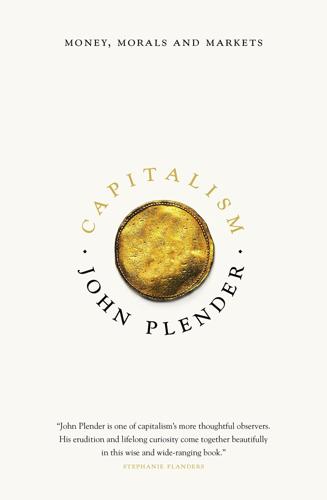
Capitalism: Money, Morals and Markets
by
John Plender
Published 27 Jul 2015
This leads to a curious position where both depositor and borrower are entitled to control over the same funds simultaneously. If depositors lose confidence in the bank and demand their money back all at once, the bank will be unable to meet its obligations. A run on deposits will follow. Such crises of confidence started in northern Italy in the late Middle Ages when this so-called fractional reserve banking became the norm. A vivid description of how bank runs arose comes from a contemporary Venetian account in the sixteenth century: The following year, 1584, I heard of the failure of the Pisani and Tiepolo bank for a very large sum of money. This was caused chiefly by the bankruptcy of one Andrea da l’Osta, a Tuscan, a Pisan, and a very rich merchant, who had lived in our city for many years.
…
Big depositors such as companies, pension funds and other financial institutions simply decide not to renew lending lines or certificates of deposit, so an ailing bank finds that its sources of funds dry up. Notwithstanding that, the British bank Northern Rock actually experienced in 2007 an old-style run in which worried retail depositors queued up outside branches to withdraw their money. Either way, the reality is that all money lenders that operate on the basis of fractional reserve banking are inherently technically bankrupt. Hence the quip generally attributed to Henry Ford: ‘It is well enough that people of the nation do not understand our banking and monetary system, for if they did, I believe there would be a revolution before morning.’ Bankers are well aware of this fundamental flaw in their business model, which is why appearances are so important in banking, as the account of the rise and fall of Andrea da l’Osta emphasised.
…
S. 1, 2 Elizabeth II 1 Engels, Friedrich 1, 2, 3, 4, 5 Enlightenment 1, 2, 3, 4, 5 Enron 1 entrepreneurs 1 environmental damage 1 Epistle to Allen Lord Bathurst (Alexander Pope) 1 Esterházy, Prince Nikolaus 1 European Monetary Union 1 European Union 1, 2, 3, 4 eurozone 1, 2, 3, 4, 5 Faber, Marc 1 Fable of the Bees, The (Bernard Mandeville) 1, 2, 3, 4, 5, 6 Facebook 1 Faerie Queene, The (Spenser) 1 Fama, Eugene 1, 2, 3, 4, 5 Farmers’ State Alliance (US) 1 fatal embrace 1, 2 Faust (Goethe) 1, 2, 3, 4 Federal Reserve (Fed) 1, 2, 3, 4 Federal Reserve Act (US 1913) 1 Ferguson, Niall 1 feudalism 1, 2, 3 fiat currencies 1 Fidelity Magellan fund 1 financial crisis (2007–08) 1, 2, 3, 4, 5, 6, 7, 8 financial intermediation 1 financial services 1 financial weapons of mass destruction 1 Finley, Moses 1 Fitzgerald, F. Scott 1 Ford, Henry 1, 2 Fors Clavigera (John Ruskin) 1 fractional reserve banking 1 France 1, 2, 3 art market 1 taxation 1, 2, 3, 4 François I of France 1, 2, 3 Frankel, Jeff 1, 2 Franklin, Benjamin 1 Frederick the Great of Prussia 1, 2 Freeland, Chrystia 1 French Revolution 1, 2 Frick, Henry Clay 1, 2 Friedman, Milton 1, 2 Fukushima nuclear spill 1 Fuld, Dick 1 fund managers 1, 2, 3 Fürstenberg, Carl 1 Galbraith, J.
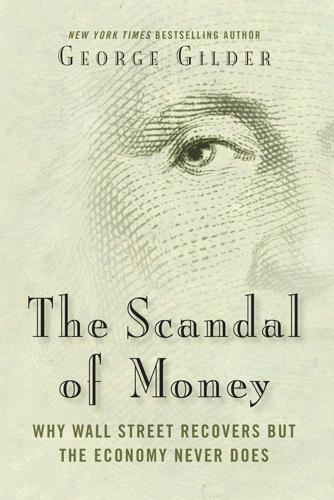
The Scandal of Money
by
George Gilder
Published 23 Feb 2016
A devout believer in the power of money, Turner wants central banks to counteract the existing overhang of private credit with the issuance of new money in any volumes needed to maintain “adequate levels of nominal demand.” Within an overall regime of inflation controls and cautions, Turner believes, government money creation is more favorable to growth than is private money creation through fractional reserve banking. To Turner, money creation is a boundless abundance (“a potentially limitless supply,” to quote Milton Friedman), whether the credit is created by private banks or “printed” by the central bank. Turner prefers central bank money because it can be steered away from real estate and other existing assets into new assets.
…
Nonetheless, Turner correctly warns that real estate by its very nature is scarce. If the private banking system were permitted to generate credit at will, it would flow toward urban land, the price of which would be bid up vertiginously in the overflow of wealth from the new information economy. He shares the skepticism of Austrian economists about fractional reserve banking, whereby financial institutions can multiply deposits into cataracts of money and debt. Thus he prefers high reserve requirements and restrictions on international capital flows. What insight does our new information theory of money give us into these prescriptions? In the new theory, the Turner-Piketty thesis rests on the triad of infinite time, finite space, and infinite information.

Attack of the 50 Foot Blockchain: Bitcoin, Blockchain, Ethereum & Smart Contracts
by
David Gerard
Published 23 Jul 2017
Bitcoin ideology bought into the entire Federal Reserve conspiracy package. The Fed is a plot to use inflation to steal value from the people and hand it to a shadowy cabal of elites who also control the government; the worldwide economy is in danger of collapse at any moment due to central banking and fractional reserve banking; gold – sorry, Bitcoin – has intrinsic value that will protect you from this collapse. Advocates repackage and propagate these ideas almost verbatim, even when they almost certainly don’t know who or where they trace back to. Conventional economics views inflation – a decline in money’s purchasing power – as a phenomenon of consumer prices, consumer confidence, productivity, commodity and asset prices, etc., which a central bank then responds to with monetary policy.
…
Which becomes neoreaction and the alt-right, but Phil Sandifer already wrote that book.24 25 Austrian economics has produced vast quantities of detailed theory to support the claim that a gold standard is the only sensible way to run an economy – rather than the more conventional view that a zero-sum economy quickly seizes up, both in theory and practice26 – and that central banks and fractional reserve banking will inexorably lead to a collapse. Disaster is imminent, and you need to be hoarding gold. Sadly for Bitcoin, most Austrian economists aren’t fans – even as Bitcoiners remain huge fans of Austrian economics.27 You will find Austrian jargon in common use in the cryptocurrency world. Proponents of Austrian economics include the fringe economics blog Zero Hedge, which has confidently predicted two hundred of the last two recessions.
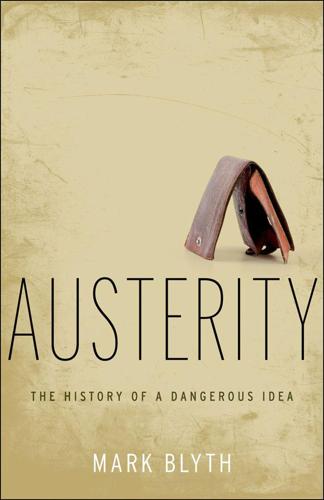
Austerity: The History of a Dangerous Idea
by
Mark Blyth
Published 24 Apr 2013
To fully understand what Smith had to say about debt and parsimony, we need to begin with what he said about banking, and go from there to savings, investment, growth, and, perhaps most surprisingly, the necessity of the state engendered by the problems of inequality and class politics and the problem of how to pay for it.27 Adam Smith’s Productive Parsimony For Smith, banking is all about having confidence in the banker. If customers have confidence in a banker’s promissory notes (his paper money), he will then be able to lend out more in paper than he keeps in reserve in gold to cover his withdrawals.28 Today, we call this “fractional reserve banking.” Yet Smith, like Hume, sees money as being unable to affect real variables in the long run, so simply adding paper money to the economy will not lead to growth.29 But if lots of trusted bankers produce more paper money than the economy can absorb, and crucially, if that paper is seen to be “as good as gold”—to use the phrase in its appropriate context—then the gold backing this paper in the bank vault will lack a role at home.
…
Second, if the only policy on offer is to get the government out of economic affairs completely, then its not clear how one does it short of engaging in a kind of “year zero” purge of the modern economy and polity. Similarly, the notion of relying on “real savings” rather than “artificial credit” would require the abolition of fractional reserve banking—where the bank lends out multiples of its reserves—and therefore an end to, for example, securitization, car loans, education loans, mortgages, and so on. It’s hard to see this as either welfare improving or politically sustainable in any meaningful sense. Third, you don’t have to be a Keynesian to acknowledge that economies do not necessarily self-heal.
…
Tales of Two Small European Countries,” (Giavazzi), 169, 170, 171, 176, 209–210 Canada fiscal adjustment in, 173 Capitalism, Socialism and Democracy, (Schumpeter), 128, 129 Cassel, Gustav, 191 central banks, independence of, 156–158 certificates of deposit (CDs), 234 Chin, Menzie, 11 China, 55 Chowdhury, Anis, 176 Churchill, Winston, 123 and the gold standard, 189 1929 budget speech, 124 Citigroup, 48 Clinton, Bill, 12 Clinton, Hillary, 218 Cochrane, John, 2, 239 Colander, David, 99 collateralized debt obligations, 28, 234 Congressional Research Group, 242 Considine, John, 208 Coolidge, Calvin, 120 Credit Agricole, 87 credit default swaps, 26, 29, 30 Daimler/Mercedes Benz, 132 Darwin’s Dangerous Idea (Dennett), 159 De Grauwe, Paul, 86 debt inflation, 150 default as a way out of financial crises, 183 mortgage, 41, 42, 44, 50 risk, 24 sovereign, 113, 210, 241 See also credit default swaps (CDSs) deflation, 240, 241 demand-side economics, 127 See also supply-side economics Denmark, 207, 209 as a welfare state, 214 austerity in, 17, 169–170, 170–171, 179 expansion, 205, 206, 209 fiscal adjustment in, 173 Dennett, Daniel Darwin’s Dangerous Idea, 159 derivatives, 27–30 credit default swaps, 27–30 special investment vehicles, 29 See also mortgages; real estate Deutsche Bank, 83 devaluation and hyperinflation, 194 as a way out of financial crises, 75, 173, 208, 213 of currency, 76, 77, 147, 169, 171, 188, 191, 197 Diamond, Peter, 243 disintermediation, 23, 49, 232 Dittman, Wilhelm, 195 Dow Jones Industrial Average, 1, 2–3 Duffy, James, 208 Eatwell, John, 42 Economic and Financial Affairs Council of the European Council of Ministers (ECOFIN), 173, 175, 176 economics Adam Smith, 109 Austrian school of, 31, 144 demand-side, 127 Frieburg school of, 135 Germany’s Historical school of, 143 Keynesian, ix, 39, 54 liberal, 99 London School of, 31, 144 macro, 40 neoclassical, 41 neoliberal, 41, 92 public choice, 166 supply-side, 111 zombie, 10, 234 Economics of the Recovery Program, The, (Schumpeter), 128 Economist, The, 69, 166, 216 efficient markets hypothesis, 42 Eichengreen, Barry, 183, 231 Einaudi, Luigi, 165, 167 Eisenhower, Dwight, 243 Englund, Peter, 211 Estonia austerity in, 18, 103, 179, 216–226, 217 fig. 6.1 Eucken, Walter, 135–136 centrally administered economy, 135–136 transaction economy, 135–136 Euro, 74–75, 77 success or failure of, 78–81, 87–93 European banks austerity and, 87 fall of, 84–87 “too big to bail”, 6, 16 European Bond Market, 1 European Central Bank, 54, 55, 84 and austerity, 60, 122 and bailouts, 71–73 and loans to Ireland, 235 and the success of the REBLL states, 216 emergency liquidity assistance program, 4 limitations of, 87–93 long-term refinancing operation, 4, 86 Monthly Bulletin, June 2010, 176 See also Trichet, Jean Claude European Commission, 122 and austerity, 221 and loans to Ireland, 235 and the success of the REBLL states, 216 European Economic Community, 62–64 European Exchange Rate Mechanism, 77 European Union and austerity, 221 and bailouts, 71–73, 208, 221 influence on Europe, 74–75 Eurozone and current economic conditions, 213 current account imbalances, 78 fig. 3.1 ten-year government bond yields, 80 fig. 3.2 exchange-traded funds (ETFs), 234 Fama, Eugene, 55 Fannie Mae, 121 Farrell, Henry, 55 Federal Deposit Insurance Corporation (FDIC), 24 Feldstein, Martin, 55, 78 Ferguson, Niall, 72 Figaro, Le, 201 financial repression, 241 Financial Stability Board, 49 Financial Times, 60 Fisher, Irving, 150 Fitch Ratings, 238 Flandin, Pierre-Étienne, 202 fractional reserve banking, 110 France, 4 and Germany’s nonpayment of Versailles treaty debt, 57 and John Law, 114 and the gold standard, 185, 204 assets of large banks in, 6 austerity in, 17, 126, 178–180 and the global economy in the 1920s and 1930s, 184–189 bond rates in, 6 depression in, 201–202 Eurozone Current Account Imbalances, 78 fig. 3.1 Eurozone Ten-Year Government Bond Yields, 80 fig. 3.2 war debts to the United States, 185 See also Blum, Leon; Flandin, Pierre-Étienne; Laval, Pierre; Poincaré, Raymond Freddie Mac, 121 free option, 29 Freiberg school of economics, 135, 136, 138–139 Frieden, Jeffry, 11 Friedman, Milton, 103, 155, 156, 165, 173 G20 2010 meeting in Toronto, 59–62 Gates, Bill, 7, 8, 13 Gaussian distribution, 33, 34 General Theory (Keynes), 126, 127, 145 Gerber, David, 136 Germany, 2, 16 and repayment war damage in France, 200–201 and the gold standard, 185 and the Treaty of Versailles, 185 as an economic leader, 75–78 austerity in, 17, 25, 57, 59, 101–103, 132–134 and the global economy in the 1920s and 1930s, 178–180, 184–189, 186, 193–197 Bismarkian patriarchal welfare state, 137 Bundesbank, 54, 156, 172, 173 capital drain after World War I, 186 Center Party, 194 Christian Democrats, 137, 139 competition, 137–138 economic ideology of, 56–58, 59–60 entrance into world economy, 134–135 Eurozone Current Account Imbalances, 78 fig. 3.1 Eurozone Ten-Year Government Bond Yields, 80 fig. 3.2 fiscal prudence of, 2, 17, 54 founder’s crisis, 134 German Council of Economic Advisors Report, 169 gold standard and, 196 Historical school of economics, 143 hyperinflation in the 1920s, 56–57, 185, 194, 200, 204 industry in, 132–134 See also BASF, Daimler/Mercedes Benz, Krups, Siemens, ThyssenKrupp ordoliberalism in, 101, 131, 133 origins of, 135–137 order-based policy, 136 National Socialists, 194–195 Nazi period in, 136, 196 Social Democratic Party, 140, 194, 195, 204 social market economy, 139 Stability and Growth Pact, 92, 141 stimulus in, 55–56 See also Freiburg school of economics stop in capital flow from United States in 1929, 190, 194 unemployment in, 196 WTB plan, 195, 196 Giavazzi, Francesco, 179, 205, 206 “Can Severe Fiscal Contractions be Expansionary?
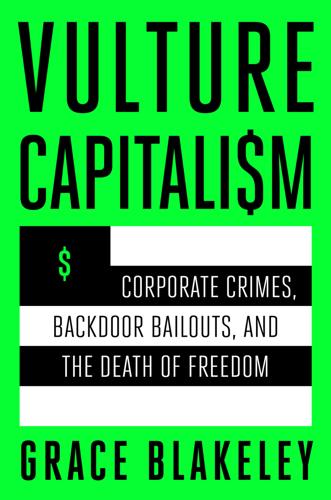
Vulture Capitalism: Corporate Crimes, Backdoor Bailouts, and the Death of Freedom
by
Grace Blakeley
Published 11 Mar 2024
The interest rate (the “price” of money) is said to be determined by the supply and demand for these savings. In this banking model, savers deposit their money in banks, which lend that money to investors in exchange for interest, a portion of which will then be paid to the saver. But the bank can’t lend out all its money—it has to keep some money “in the bank.”35 This system is termed fractional reserve banking, and it gives banks the capacity to create money. If I deposit $100 in the bank and the bank lends another consumer $90 on the basis of my deposit, the total amount of money in the economy has increased from $100 to $190. The idea behind this model—the so-called loanable funds model—is that banks provide households with a safe place to store their savings, and then lend these savings out in such a way as to minimize risk.
…
Klein) and, 38, 193, 198 states of emergency and, 57 Suez Canal and, 61–66 discrimination abuse of migrants, 101–3 antisemitism, 19–20, 43–44, 53 in apartheid South Africa, 202–4 homophobic attacks, 103 land/property seizures from indigenous peoples, 186–90, 228, 251 Doctor Who (television series), 109 Donegal International, 207 Donziger, Steven, 195–96 dot-com bubble (1997–2001), 110–11, 120, 133 Dow Chemical, 90, 124 Driver’s Co-Operative (cooperatively owned app), 254 Ducera, 123–24 DuPont, 23, 90–91, 124 Durand, Frederic, 129 Durkan, Jenny, 79 DXC, 45 Dyal, Gordon, 124 Dyalco, 124 E Earnd (app), 154–55 East India Company (EIC), 22, 103–4, 183 Ebbers, Bernard, 119–20 Ecuador, Chevron’s “Amazon Chernobyl” disaster, 194–96, 205 Eeckhout, Jan, 87–88 Egg Baby, 110 Egypt, Suez Canal and, 61–66 Eisenhower, Dwight, 188–89 electoral systems, 259–61 campaign finance reform, 259 lobbying by corporations, 105–6, 140, 141–42, 151, 159, 259 political donations/contributions and, 43–44, 80, 140, 141, 259 working-class candidates and, 260–61 Elizabeth I (Queen of England), 103 Elizabeth II (Queen of England), 114 El Salvador, gold mining prevention in, 197 Emissions Trading System (European Union), 69 empire planning, 173–211 “banana republics” and, 186–93 China, Belt and Road policy, 171–72, 182–83 comparative advantage (Ricardo) and, 180–81 dependency theories, 184–86 fossil-fuel industry and, 194–97 free trade policies and, 181–82 imperialism and, 173–81, 183–85 international development in, 180–81 investor-state dispute settlement (ISDS), 194–98 nature of empire and, 177–79 shock therapy, 38, 193, 198, 200–201 structural adjustment programs (SAPs), 198–202 US colonialism and, 173–79, 209–10 vulture capitalism, 202–11 employer-employee relationship, 83–85 Engels, Friedrich, 121 Enron, 55, 119 entrepreneurialism, xv–xvi, 33, 41, 85, 92, 116–18, 167 environmental issues, see climate breakdown Estonia, Your Priorities platform, 236 Ethiopian Airlines Flight 302 (2019), 3–4, 219 Ethyl Corp., 197 European Central Bank (ECB), 46, 210 European Commission, 87 European Union (EU) Emissions Trading System (ETS), 69 enforcement of competition law, 87 “green” stimulus packages, 69 labor movement and, 78 United Kingdom membership in, 154 Evergrande Group (China) implosion, 167–69, 171 Everything Store, The (Stone), 80 Export-Import Bank (EXIM), 243 ExxonMobil, 64, 139–41 F Facebook/Meta, vii, 94, 106 Fannie Mae, 50 Fanon, Frantz, 177 Ferreras, Isabelle, 83 feudalism, 12–13, 266, 269–71 Finance Capital (Kautsky), 121–22 financial crisis of 1630s (tulip bubble), 126 financial crisis of 1987 (stock market crash), 126–27 financial crisis of 1997 (Asian crisis), 51, 200 financial crisis of 2008 (subprime bubble), xiv, 126 American International Group (AIG) bailout and, 48–53, 136 bond ratings agencies and, 50 as crisis of regulatory capture, 32 Evergrande (China) implosion, 167–69, 171 Ford Motor Company and, 29–30 globalization of finance and, 50–51, 209–10 Iceland, Better Reykjavik participatory budgeting program, 235–36, 258–59 international finance system and, 207, 209–10, see also international finance system lack of prosecutions following, 38–39, 52, 131–32 McKinsey & Company and, 54–55 mortgage-backed securities and, 41, 48–50, 52, 54, 106, 127, 128–30 Occupy movement, 249–50 origins in the US, 209–10 predictions of, 114–15, 117–18 private debt creation and, 117–18 quantitative easing (QE) and, 127–28, 129, 136 Strike Debt campaign/Rolling Jubilee, 249–50 Troubled Asset Relief Program (TARP, 2008), 29, 49, 53 financial institutions, see central banks; international finance system Fink, Larry, 69, 132–37, 142 First Boston, 133 Flores, Fernando, 244–45 Florida, Pulse nightclub shooting (2016), 103 Floyd, George, 101 Flying Blind (Robison), 6 Foccart, Jacques, 177 food agrochemical and seed industry, 90–91, 123–24 land degradation and, 68 pesticides/herbicides, 68, 90–91, 124 Ford, Henry, 19–22, 26, 28, 75, 160 Ford, Henry, II, 23, 26, 27, 28 Ford Motor Company, 19–30, 75, 86, 87, 96 corporate welfare and, 25, 29–30 Five-Dollar Day, 21, 26 Fordist production approach, 19–24 Fordlândia, 22–23, 186 Ford Motor Credit Company (FMCC), 28–29 labor movements at, 19–22, 26–29, 31, 75 shareholder distributions, 28, 29–30, 31 fossil-fuel industry, 62–64, 66, 69, 139–43, 194–97, 205, 251 Foucault, Michel, 105, 165, 170 four-day workweek proposal, 248, 253 fractional reserve banking, 114–18 France COVID-19 aid to corporations, 46 imperialism of, 177 Franco, Francisco, 229 Freddie Mac, 50 Freedom Farms Cooperative (Mississippi), 237 free-market capitalism, ix, 11–14, 15–17, 30, 36–39, 97–98, 137, 221, 268–70 Friedman, Milton, 34, 150 G G4S (Government 4 Sale), 46, 101–3, 104 Gabon, 177 Galbraith, J.
…
K., 37, 97–98 Gallagher, Kevin, 262 General Electric, 4 General Motors, 27, 29 General Theory of Employment, Interest, and Money, The (Keynes), xi Germany Berlin Wall removal, 200–201 campaign finance by state and, 259 competition policy and, 150 COVID-19 aid to corporations in, 45, 46–47 Ford Motor as supplier to, 23–24 Green Party, 229 labor movement and, 78, 248 Nazi Party/Third Reich, 19, 23–24, 93, 122, 183–84, 226 social market economy (Röpke) and, 203 Vattenfall lawsuit and, 197 Weimar Republic, 121–22 World War II and, 158, 181 GFG Alliance, 153, 156–57 Ghana independence from Britain (1957), 177 Non-Aligned Movement and, 190–91 structural adjustment programs (SAPs) and, 200 gig economy, 92–93, 253, 254 Gindin, Sam, 31, 198, 210 Global Climate Coalition, 139 Global Intangible Low-Tax Income (GILTI), 42 Global North climate breakdown and, 263 exploitation of the Global South by, 190–91, 261, 262 Global South catching up to, 207–8 Global South as challenge to, 182–83, 246 Global South critique of neocolonialism and, 177, 208, 210–11 international debt crisis, 198–202, 262 market power and wage suppression, 93 production by the Global South in, 185 Washington Consensus policies, 200–201, 210 Global South catching up to Global North, 207–8 as challenge to Global North, 182–83, 246 climate breakdown and, 70–71, 263 critique of neocolonialism of the Global North, 177, 208, 210–11 exploitation by the Global North, 190–91, 261, 262 international debt crisis, 198–202, 262 market power and wage suppression by Global North, 93 Non-Aligned Movement and, 190–92, 193 production in the Global North and, 185 solidarity among members of, 184–86, 192 violence of the neoliberal state in, 34 Golding, William, 223–24, 226 Goldman Sachs, 48–49, 53, 54, 60, 123–24, 132–33, 225 Goodrich Corporation, 218 Google (Alphabet), 94, 95, 133 Gould, Matthew, 155 Graeber, David, 35, 125, 224–25, 265–66 Gramsci, Antonio, 20–22, 24, 157–58 Great Depression, 147 Greater London Council (GLC, UK), 219–20, 231 Greater London Enterprise Board (UK), 216–17, 219–20 Great Reversal, The (Philippon), 87–88 Greene, Marjorie Taylor, 43–44 Green New Deal proposal, 69, 248 Green Party (US), 251 Greenpeace, 140 Greensill, Lex, 152–59 Greensill Capital, 153–59 Greenspan, Alan, 127–29 Green Team Landscaping Co-op (Mississippi), 237 Grundrisse (Marx), 264 Guam, US colonialism and, 173, 174 Guatemala, United Fruit Company (UFC, now Chiquita) and, 186–90, 193 Guerra, Antonio, 195 Guevara, Che, 234 Gupta, Rajat, 54 Gupta, Sanjeev, 153, 156 H Haley, Nikki, 8 Halliburton, 178, 193 Hancock, Matt, 154–56 Hancox, Dan, 230 Harding, Dido, 54, 155 Hassan, Maggie, 141 Hawaii, US colonialism and, 173 Hayden, Grant, 254 Hayek, Friedrich A., xvii–xx, 34–36, 89, 100–101, 108, 146–47, 167, 202, 217 critique of centralized planning, x–xii Highway Code, 148–52, 165, 204 Keynes vs., xvi, 268 neoliberalism and, x–xii, xv–xvi The Road to Serfdom, vii, xi, 34, 204 Hearn, Denise, 89 Helleiner, Eric, 51 Higgins, Michael D., 217 Highway Code (Hayek), 148–52, 161, 204 Hilferding, Rudolf, 121–23 Hitler, Adolf, 19, 23 Hobbes, Thomas, 144, 222, 226 homophobic attacks, 103 Hoover, Herbert, 22 housing crisis, viii Cooperation Jackson (Mississippi) affordable housing, 236–37, 247, 251–52, 255 corporate landlords and, 44–45 COVID-19 pandemic and, 43, 44–45 financial crisis of 2008 and, 52 How Europe Underdeveloped Africa (Rodney), 185 H&R Block, 106 HSBC, 124 Huffington, Arianna, 38 Humankind (Bregman), 224 I Iceland, Better Reykjavik participatory budgeting program, 235–36, 258–59 ideological state apparatus (ISA), 164–65 Ifans, Rhys, 239 immigrants labor movements and, 263 UK immigrant policies, 163–64, 263 India Bhopal, gas tragedy (2001), 90 East India Company (EIC), 103–4, 183 Kerala, People’s Planning, 233–34 indigenous peoples Australian green bans and, 228 climate breakdown and, 251 critique of European society, 224–25 in Guatemala, 189–90 land/property seizures from, 186–90, 228, 251 Indonesia Jakarta Method and, 190–92 Non-Aligned Movement and, 190–91, 193 industrial system (Galbraith), 97–98 inflation cost-of-living crisis, 48, 58, 63–66, 129 Ever Given crisis (2021) and, 62–63, 64 oil price spikes and, 62, 63 sellers’ inflation, 64–65 Volcker shock and, 198, 205 wage-price spiral argument and, 63–65 InfluenceMap, 140 interest rates inflation and, 65–66, 198, 205 international finance system and, 115 Volcker shock and, 198, 205 Intergovernmental Panel on Climate Change, 67–68 international finance system, 109–37 Big Three institutional investors, 133, 135, 137 BlackRock, 69, 132–37, 257 capital flight threat and, 93, 96, 204–5, 208, 246, 262 central banks and, see central banks centralization of global capitalism and, 136–37 confidence in, 116–18 democratic planning and, 255–57 developmentalism and, 137, 170–72, 205–8 dynamics of debt and, 114–18, 168–69, 262 economic nationalism vs., 204–5 financial crisis of 2008 and, see financial crisis of 2008 (subprime bubble) financialization in, 121–24, 199 fractional reserve banking, 114–18 fraud and scandals in, 119–24, 220–21 international debt crisis, 198–202, 262 International Monetary Fund (IMF) and, 53, 114, 176, 198–200, 206–8, 262 manias, panics, and crashes, 125–26 mergers and acquisitions, 133 planning power in, 113–14 private law and, 130–32 regulation of, 32, 113, 116, 130, 148, 150 stakeholder capitalism and, 135–36 structural adjustment programs (SAPs), 198–202 taxes and, see taxes and taxation time lords of capitalism and, 109, 113–14 US dollar and, 178, 209–10 Washington Consensus policies, 200–201, 210 WeWork/SoftBank relationship, 109–13, 117 World Bank in, 176–77, 198–99, 206–8 International Labour Organization (ILO, UK), 60 International Monetary Fund (IMF), 53, 114, 176, 199–200, 206–8, 262 International Trade Union Confederation, 75 Intuit, 106 investor-state dispute settlement (ISDS), 194–98 Iraq, 105, 178, 192–93 Israel COVID-19 response, 57 Suez crisis (1956), 61–62 Italy, labor movement and, 78 J Jakarta Method, The (Bevins), 190–92 Jameson, Frederic, xix, 16 Japan developmentalism and steel industry, 172 housing boom, 127 quantitative easing by the Bank of Japan, 127–28 in World War II, 175–76, 190, 191 Jassy, Andrew, 78 Jiayin, Xu, 167–69 Johnson, Boris, 70–71 Johnson, Desmond, 164 Johnson, Lyndon B., 27, 176 Johnson, Trevor, 164 Jones Act (1916, US), 174–75 JPMorgan, 52, 120–21, 123–24 JPMorgan Chase, 119 K Kaleki, Michael, 97 Kao, Martin, 44 Kaplan, Lewis, 195 Kautsky, Karl, 121–23 Keen, Steve, 114–15 Kelly, Mark, 141 Kelly, Petra, 229 Kelly’s Bush (Australia), 227–28 Kennedy, John F., 27, 181 Keynes, John Maynard, xi, xvii, xx, 126, 149, 217, 268, 269 ambivalence toward freedom and autonomy of the masses, xvi centralization of power in capitalism, xvii Hayek vs., xvi, 268 privatized Keynesianism, 117–18 regulated markets and, xvi Keystone XL pipeline, 251 Kicking Away the Ladder (Chang), 146 King, Arthur, 228 Klein, Michael, 124 Klein, Naomi, 38, 193, 198 Kozul-Wright, Richard, 262 KPMG, 193 Kushner, Jared, 33 Kyoto Protocol, 139 L Labor and Monopoly Capital (Braverman), 99–100 labor movements at Amazon, 75, 77–79 in Australia, 227–29 “banana republics” and, 187 conflict with capital, 37, 148, 151, 160 democratic planning and, 247–48, 252–53 electoral systems and, 260–61 employer-employee relationship and, 83–85 at Ford Motor Company, 19–22, 26–29, 31, 75 four-day workweek and, 248, 253 immigrant workers and, 263 Lucas Aerospace Corporation/Lucas Plan and, 216–17 neoliberal resistance to, 15, 31, 33–34, 62, 64–65, 77–78, 148, 160, 216–17, 218, 220, 221, 252–53 in Spain, 78, 229–30 Tripartite Committee, 27–28, 30, 160 UK resistance to, 15, 31, 33–34, 62, 64–65, 77–78, 160, 216–17, 218, 220, 221 at United Fruit Company (UFC, now Chiquita) and, 187 US resistance to, 31, 62 Volcker shock and, 198, 205 wage-price spiral argument and, 63–65 wage suppression, 60, 63, 92–93 worker ownership and, 255 Land Rover, 28 Lansdale, Edward, 175 Lash, Scott, 37 Lazydays Holdings, 42 Lee, Susie, 42 legal issues competition law, 87, 150, 151 corporate crime, 106–7, 119–24, 156–57, 220–21 corporation as legal construct, 105–7 international court system, 178, 194–98, 203–4, 210 investor-state dispute settlement (ISDS), 194–98 private law, 130–32 see also taxes and taxation Le Guin, Ursula K., 267 Lehman Brothers, 38, 48 Lenin, Vladimir, 59, 61, 122, 183 Lewis, John, 237 liberalism “blind” justice in, 149 comparative advantage and, 180–81 incomplete liberal revolutions and, 258 links with imperialism, 179–80 Lion Air Flight 610 (2018), 3–4, 7 Liveris, Andrew, 124 Locke, John, 145–47, 165 London School of Economics, 114 Lord of the Flies, The (Golding), 223–24 Lucas Aerospace Corporation/Lucas Plan, xix, 215–22, 226, 229, 231, 247, 248, 266 Lula da Silva, Luiz Inácio, 251 Lumumba, Chokwe, 236, 247 Lumumba, Chokwe Antar, 236 Luxembourg, as tax haven, 79 Lynn, Barry, 21 M Ma, Jack, 171 Madoff, Bernie, 120–21 managerialism, 34–35, 84, 100, 108, 216 Manchin, Joe, 141 Mann, Geoff, 70 Marcos, Ferdinand, 175–76 Marcos, Imelda, 176 Marcos, Mariano, 175–76 market power access to financing and, 96 of Amazon, 75–77, 79–81, 88, 132–34 COVID-19 pandemic and, 59–60, 65 creative destruction (Schumpeter) and, 86, 95, 96 of Ford Motor Company, 28 free markets vs., 13 monopoly and, see monopoly nature of, 16, 76–80 oligopoly and, 94, 95 over suppliers, 95 political power and, 95–96, 104–8 price markups and, 65, 76, 87, 92 Marshall Plan, 263 Marx, Karl, 52–53, 68, 82, 84, 85, 92, 94, 98, 121–25, 182, 264–65 Capital, vii centralization of power in capitalism, xvii–xviii Communist Manifesto, 152 Grundrisse, 264 means of production in capitalism, 12–13, 247, 264 Mateen, Omar, 103 MCAS (Maneuvering Characteristics Augmentation System), 4, 5–7 McConnell, Mitch, 43 McDonald’s, 81 McDonnell Douglas, 4, 8–9 McKinsey & Company, 53–58, 155 McNamara, Robert, 27, 176 Meagher, Michelle, 88, 107 Meidner Plan (Sweden), 255 Meiksins Wood, Ellen, xviii Mein Kampf (Hitler), 19 mergers and acquisitions in the aerospace industry, 4, 8–9, 218–19 of agrochemical companies, 90–91, 123–24 of Amazon, 80 big tech and, 95 COVID-19 pandemic and, 59–60 of financial institutions, 133 of fossil fuel companies, 194–96 Merrill Lynch Investment Managers, 133 Mesopotamia, 14 Meta/Facebook, vii, 94, 106 Metalclad Corp., 197 Mexico, Metalclad Corp. lawsuit and, 197 Microsoft, 95 middle class, emergence in capitalism, 98 Miliband, Ed, 158 Miliband, Ralph, 158, 159, 247, 260 military-industrial complex (US), 9–10, 23, 25, 191–93, 217–20, 244 Minsky, Hyman, 113, 114 MIO Partners, 54–55 Mirowski, Philip, 36 Mississippi, Cooperation Jackson/Jackson-Kush Plan, 236–37, 247, 251–52, 255 money laundering, 120–21, 156–57 monopoly Amazon and, 75–77, 132–34 limiting investment in, 96–97 market concentration and, 91–92, 95 measuring monopoly power, 87–88 monopoly capitalism, 99–100 prices and, 92, 94–95 problems of monopoly power, 88–89 temporary monopoly power (Schumpeter), 85–88, 96 monopsony, 93, 97 Monsanto, 90, 91, 106, 123–24 Moon, Cary, 79 Morgan Stanley, 123–24, 153 Mottley, Mia, 70–71 Mubenga, Jimmy, 101–2 Muilenburg, Dennis, 7 Mulally, Alan, 29–30 Mundey, Jack, 227–29 Mussolini, Benito, 20, 187 N Nalundasan, Julio, 175 Napoleon Bonaparte, 187 Nasser, Gamal, 61 National Association of Realtors, 106 National Labor Relations Board (NLRB), 78 Navatek LLC, 44 neoliberalism bureaucratization and, 34–35, 147 challenge of capitalist state and, 165–66 Chicago school of, 150–51, 199 consumer freedom of choice and, xiv, xv–xvi, 166–67 corporate welfare programs and, 7–8, 25, 29–33, 140–42, see also taxes and taxation crisis of governability and, 30–31 deregulation and, xv–xvi, 7, 31, 32, 51, 170, 206 distinction between capital and labor, 30–39 “double truths” of (Hayek), 36, 152 efficient markets as lie at heart of, 36–39, 146–47, 268 “encasing” democracy around the world, 203 Hayek and, see Hayek, Friedrich A.
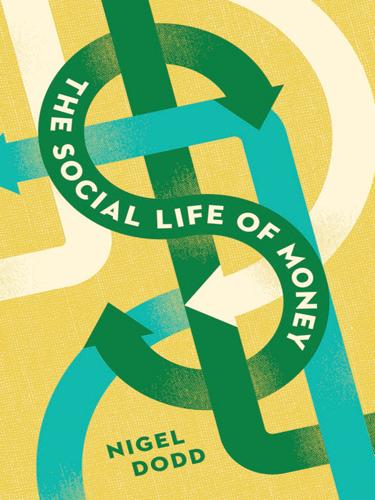
The Social Life of Money
by
Nigel Dodd
Published 14 May 2014
The range of institutions involved in banking has broadened far beyond the fractional reserve system (the Bank of England now uses the phrase “complex financial institution,” not bank), and the financial instruments banks use, such as derivatives and collateralized securities, are formidably complex and varied. Moreover, financial markets now perform many of the services previously performed by banks as financial intermediaries. But even today, fractional reserve banking features prominently in popular criticism of banking, as if this were the essence of what banks do. Fractional reserve banking is often presented not only as fraudulent, but also as inherently destabilizing. An example of the genre is the work of Paul Grignon, a Canadian artist and filmmaker, who made two films under the generic title, Money as Debt, in 2006 and 2009 (Grignon 2006, 2009).30 Grignon argues that the system incentivizes banks to ensure that debts are not only perpetually renewed but also increased.31 Another version of the argument is that because of their need to lend against collateral, the system gives private banks an incentive to allocate credit to property speculation rather than production and divests governments of control over the allocation of credit.
…
An example of the genre is the work of Paul Grignon, a Canadian artist and filmmaker, who made two films under the generic title, Money as Debt, in 2006 and 2009 (Grignon 2006, 2009).30 Grignon argues that the system incentivizes banks to ensure that debts are not only perpetually renewed but also increased.31 Another version of the argument is that because of their need to lend against collateral, the system gives private banks an incentive to allocate credit to property speculation rather than production and divests governments of control over the allocation of credit. According to this view, it is mistaken even to refer to the practice as fractional reserve banking because the link between banks’ lending and reserves is extremely tenuous (Zazzaro 2002; Arena, Graziani, et al. 2004; Graziani 2009; Ponsot and Rossi 2009). A third version, as proposed by the American Monetary Institute—a monetary reform pressure group established in 1996—argues that the power of money creation should be placed in the hands of government, not private banks.32 The argument hinges on making a clean separation between the business of banking on one side and money creation on the other (Ryan-Collins, Greenham, et al. 2012).
…
This is where we are today: undecidability, the era of floating theories, as much as floating money” (Baudrillard 1993: 44 n. 3; see also Baudrillard 2001: 53). 23 The terrorist model brings about “an excess of reality” (Baudrillard 2003: 18). 24 In his later analysis, Baudrillard makes the additional point that the towers were an “architectural graphism” embodying capitalism in its digital phase, “a system that is no longer competitive, but digital and countable, and from which competition has disappeared in favour of networks and monopoly” (Baudrillard 2003: 38–39). 25 “The Bernard Madoff story tells us a lot about the nation’s financial mess,” Seattle Times, December 19, 2008. 26 Michael Rowbotham takes a similar line, but in much narrower terms, describing fractional reserve banking per se as a form of legalized counterfeiting (Rowbotham 1998). 27 “Stucco is the triumphant democracy of all artificial signs,” he writes (Baudrillard 1993: 51). 28 As we see in Chapter 8, the idea behind Bitcoin is that no such copies are possible: each Bitcoin is unique. 29 Circulating at speed, speculative currencies are the epitome of an uncontrollable drifting of signs: “a simple play of flotation can ruin any national economy” (Baudrillard 1993: 23).
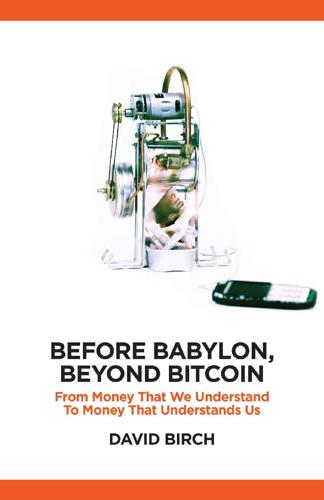
Before Babylon, Beyond Bitcoin: From Money That We Understand to Money That Understands Us (Perspectives)
by
David Birch
Published 14 Jun 2017
This is one of the reasons that I remain sceptical about the new virtual currency Bitcoin (this is, again, something that we will return to in Part III of the book). If the colony analogy holds, we would expect just such a development and the emergence of not only new forms of money but a whole new virtual finance industry, as different from our existing finance industry as fractional reserve banking was from the striking of electrum coins in Lydia. Who would bet against a new standard emerging – an energy standard, as for example envisaged by the artist Austin Houldsworth in chapter 15 – that is not related to first- or second-wave commodities but to claims against the future production of goods or the delivery of services?
…
— Adam Smith (1723–90) in An Inquiry into the Nature and Causes of the Wealth of Nations (Volume I, Book II, Chapter II) During Victorian times the combination of technology and regulation brought us to a vision of money and markets that we recognize. This vision is one of a central bank in control of nation state currency, money creation by fractional reserve banks and paper circulating in the place of commodities. (It is true that America did not yet have a central bank, but the die was cast.) We had banknotes and bank accounts, futures and options, savings and loans. For the purposes of this discussion, then, we mark the present – the Money 2.0 era, the era of electronic money, the technological era of bits about atoms – as beginning in 1871 with the launch of Western Union’s electronic funds transfer service.
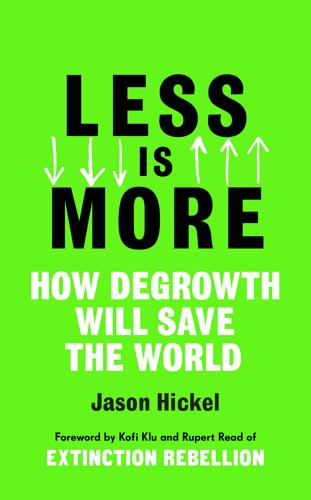
Less Is More: How Degrowth Will Save the World
by
Jason Hickel
Published 12 Aug 2020
It’s what is driving the pharmaceutical companies behind the opioid crisis in the United States; the beef companies that are burning down the Amazon; the arms companies that lobby against gun control; the oil companies that bankroll climate denialism; and the retail firms that are invading our lives with ever-more sophisticated advertising techniques to get us to buy things we don’t actually want. These are not ‘bad apples’ – they are obeying the iron law of capital. Over the past 500 years, an entire infrastructure has been created to facilitate the expansion of capital: limited liability, corporate personhood, stock markets, shareholder value rules, fractional reserve banking, credit ratings – we live in a world that’s increasingly organised around the imperatives of accumulation. From private imperative to public obsession But understanding the inner dynamics of capital only partly explains the growth imperative. To really grasp the pressures that are at play, we also have to pay attention to what governments are doing.
…
When you walk into a bank to take out a loan, you might assume that the bank is lending you money it has in its reserve, collected from other people’s deposits and stored in a basement vault somewhere. But that’s not how it works. Banks are only required to hold reserves worth about 10% of the money they lend out, or even less. This is known as ‘fractional reserve banking’. In other words, banks lend out about ten times more money than they actually have. So where does that extra money come from, if it doesn’t actually exist? Banks create it out of thin air when they credit your account. They literally loan it into existence. More than 90% of the money that’s presently circulating in our economy is created in this manner.
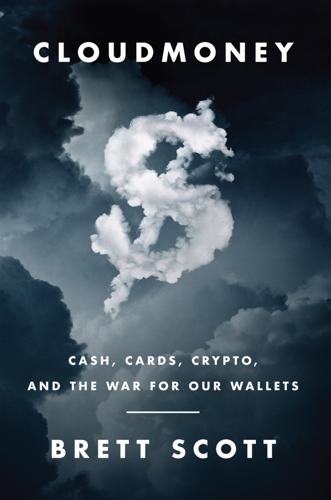
Cloudmoney: Cash, Cards, Crypto, and the War for Our Wallets
by
Brett Scott
Published 4 Jul 2022
Banks, by contrast, are able to issue chips far in excess of the state money they hold. In other words, banks can issue a lot more promises for state money than they have in state money reserves (or they can issue these promises and fill in the reserves later). People sometimes call this ‘fractional reserve banking’, but the more accurate term for it is credit creation of bank-money. It is a mind-bending topic for many, and perhaps for that reason is widely misrepresented. But let us try to understand it, because it will help in our understanding of financial politics going forward, and it also provides inoculation from some of the more hysterical condemnations of banking.
…
, 49, 72 ‘Cashfree and Proud’, 40 Cashless Catalyst, 127–8 Cashless Challenge, 40 cashless society, 2, 5, 10, 15, 38, 64, 81, 83, 84, 251 inevitability, 10–12, 121–33, 260–61 Cashless Way, 37 casinos, 66–9, 70–71, 83, 236 categorisation, 109, 113–14, 162, 167 Catholicism, 131, 212 Cayman Islands, 111 censorship, 33, 116–18, 250 central banks, 36, 42–5, 51, 84, 254 data surveillance, 115 digital currencies (CBDC), 242–5, 254, 255 international transfers, 79 transfers, 73–4 centralisation of power, 15, 180–83 centralised–decentralised model, 136 Chama, 130 charging up, 22–5 chatbots, 146–8 Chaum, David, 106–7, 117, 183 cheques, 89 Chicago Mercantile Exchange, 158 China, 2, 7, 18, 33, 74–5, 79, 114–15, 254 CBDC plans, 245, 254–5 facial recognition in, 150 leviathan complex, 178 People’s Bank of China, 79, 242 Social Credit System, 115, 245 choice, 124–6, 251 Christianity, 154, 175–6, 212 Christl, Wolfie, 109 cigarettes, 181 Circles, 260 Citigroup, 1, 37, 109, 132, 150, 227 City of London, 6, 135 class, see social class Cleo, 146 climate change, 226 cloakrooms, 66–9, 70–71 cloud, 30 cloudmoney, 82 Coca-Cola, 31, 131 cocaine, 98 code is law, 223, 224 Coinbase, 233 collateralised debt obligations, 26 colonialism, 55, 97, 175–6, 178, 239 Commerzbank Tower, Frankfurt, 18–20, 143, 156 computer boys, 158 conductivity, 179, 249 ConsenSys, 229 conservatism, 7, 131, 155, 184, 192–3, 211 see also right-wing politics consortium blockchains, 231, 233 conspiracy theories, 261–2 constitutional monarchies, 56 consumers, 25 contactless payments, 13, 31, 37–8, 91, 125, 127 core, 28 corporate personhood, 147 Corruption Perceptions Index, 43 counterfeiting, 60–61 countertradability, 209–10, 213, 256–7 Covid-19 pandemic, 2, 10, 16, 34, 36, 181, 249, 254 ATM use, 36 cash and, 2, 34, 40–41, 249, 261 conspiracy theories, 261 Cracked Labs, 109 credit cards, 39, 91, 109 credit creation of bank-money, 70, 72 credit default swap market, 232 credit expansion, 168–9 credit ratings, 17, 114, 160, 162–3, 167, 168, 170 crime cash and, 36, 42–3, 45, 81, 112 cybercrime, 32 financial crime, 111–12 marijuana industry, 102 trust and, 93 Crypto Sex Toys, 13 crypto-anarchists, 183 Cryptocannabis Salon, 101–2 cryptocurrencies, 13–15, 16, 101–2, 103, 184–5, 187–246, 254–60 alt-coins, 217–18 as commodity, 206–10, 213–14, 217, 246, 256 countertradability, 209–10, 213, 256–7 decentralisation and, 14, 15, 189–94, 196, 230, 234, 255, 258 forks, 214, 217 millenarianism and, 212, 213 mutual credit systems and, 260 oligopolies and, 229–33, 246 politics and, 191–3, 211–12, 215–17, 225–6 smart contracts, 220–24, 258 stablecoins, 233–41, 245–6, 255 Currency Conference (2017), 60 Curse of Cash, The (Rogoff), 93 Cyber Monday, 86 cyberattacks, 32, 48 cybercrime, 34 cyberpunk genre, 10 cypherpunk movement, 106, 183–5, 216–17 Dahabshiil, 116 DAI, 235 dark market, 216–17, 259 Dark Wallet, 216 data, 2, 8, 10, 33, 39, 104–19, 156–72 AI analysis, 108, 153–72 banking sector and, 108–9 Big Brother and, 113–15 categorisation, 109, 113–14, 162 panopticon effect and, 118–19, 172 payments censorship and, 116–18 predictive systems and, 105 states and, 110–12, 114–15 Data Bank Society, The (Warner), 106 data centres, 3, 4, 5, 30, 32, 34, 35, 47, 73, 76–7, 149 Davos, Switzerland, 11 debit cards, 39 Decathlon, 40–41 decentralisation, 14, 15, 189–94, 196, 230, 234, 255, 258–60 decentralised autonomous organisations (DAOs), 221–4, 258 DECODE, 236 DeepMind, 8 DeFi (decentralised finance), 258 Delft University of Technology, 31 demand, 29 demonetisations, 43, 44, 93 deposits, 66–7, 69 derivatives, 6, 18, 21, 26, 27, 160 Desparte, Dante, 238 Diamond, Robert ‘Bob’, 38 Diem, 241, 244 DigiCash, 106, 183 digital footprint, 169 disruption, 8, 9, 14, 32, 140–43 distributed ledger technology (DLT), 229–46, 258 Dogecoin, 13, 218 dollar system, 80, 182, 210, 233–6, 239, 240 double spending, 182, 194 doublethink, 143 Dow Chemical, 24 Drakensberg Mountains, 3–4 Dridex, 32 drones, 11 drug dealers, 96 Dubai, United Arab Emirates, 248 Dylan, Robert ‘Bob’, 90 e-commerce, 40, 77 East India Company, 178 eBay, 109, 113 ecological activism, 7 economic syncretism, 175–6 Ecuador, 240 Egypt, 116 El Salvador, 98, 208 elderly people, 126 electricity, 247 Elwartowski, Chad, 216 Emili, Geronimo, 37 employees, 25 enclosure, 86 Enlightenment (c. 1637–1789), 252 enterprise blockchains, 231 Enterprise Ethereum Alliance, 233 entrepreneurs, 1, 15, 129, 155 equivocation fallacies, 85 Erica, 147 Ethereum, 219–24, 257–8 Ethereum Classic, 224 European Union, 14, 37, 42, 254 Central Bank, 51, 74, 79, 242 DECODE project, 236 Eurozone, 51, 74, 79 Evans, Mel, 144 exiting, 39, 48, 61, 63, 68, 83 Experian, 163 F-16 fighter jets, 153 Facebook, 7, 38, 105, 150, 166, 198, 255, 262 Libra, 236–41, 245 Messenger, 237 facial recognition, 10, 138, 150, 181, 245 far-left politics, 7, 215 far-right politics, 7, 14, 215, 225–6, 261–2 fascism, 7, 14, 226 Federal Bureau of Investigation (FBI), 111 Federal Reserve, 32, 35, 36, 234, 242 federated frontline, 136–8, 147 fees, 39, 57, 91, 94 feminism, 226 fiat money, 51–2, 56, 192, 193 Fidor, 142 Financial Crimes Enforcement Network, 111 financial crisis (2008), 6, 8, 17–18, 26–7, 96, 184, 232, 248 financial inclusion, 37, 39, 93–9, 130–32, 167, 238, 262 fingerprints, 150 Fink, Stanley, 38 fintech, 8, 41–2, 140–43 first-world problems, 154 fitness centres, 17 fixed money supplies, 191–3 Floored (2009 film), 158 Florentine Republic (1115–1569), 135, 159 Follow the Money, 112 Fourth Industrial Revolution, 11 fractional reserve banking, 70 France cashless payments strategy, 43 Frankfurt, Germany, 18–20, 143, 156, 248 frogs, slow-boiling, 104 futurism, 1, 12, 86, 122–3, 250, 252 gambling, 105 game theory, 220 Gap, 131 Gates, William ‘Bill’, 44–5, 261–2 GCHQ, 112 Generation Z, 86, 140 gentrification, 128–33 Germany, 7, 18 Bundesbank, 35, 47 cash thresholds, 42–3 Corruption Perceptions Index, 43 Frankfurt, 18–20, 143, 156 honesty boxes in, 91 get-rich-quick investments, 26 Getty Images, 80 giant parable, 52–6, 63–4, 188 global matrix, 12 Gmail, 203 gold, 192–3, 207, 214 Goldman Sachs, 38, 150, 157, 158, 230 Golumbia, David, 225 Google, 2, 5, 7, 262 Cashe, 150 data, 105, 108 DeepMind, 8 Gmail, 203 Maps, 4 Mastercard deal, 109 Pay, 1, 78, 125 Singularity University, 153–6, 252–3 Trends, 84 USAID and, 128, 178 Grassroots Economics, 260 Greece, 42, 43, 62, 131 Green Dot, 150 Greenpeace, 116 growth, 123, 126–7, 249 hackers, 6–7, 101, 184 Hacktivist Village, 101 Halkbank, 131 Handmaid’s Tale, The (Atwood), 117 Hansen, Tyler, 101–2 Harvard University, 47, 93 hawala systems, 179 ‘Here Today.
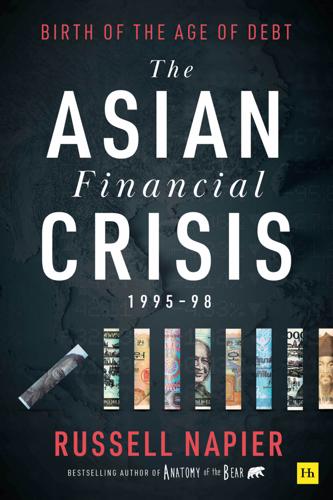
The Asian Financial Crisis 1995–98: Birth of the Age of Debt
by
Russell Napier
Published 19 Jul 2021
The money the central banks credited to the sellers of the foreign currency, in their exchange rate intervention, was in the form of newly created local currency commercial bank reserves. Asian commercial banks, flush with surging reserves, reacted by increasing the size of their loan books. In so expanding their loan books, the fractional reserve banking system created money in that act of alchemy that has been with us since the 17th century. The capital inflows to Asia, combined with the Asian central banks’ intervention to prevent undue exchange rate appreciation, was thus feeding both a credit boom and a money boom. In effect, the accumulated savings of generations of the developed world, now being assigned for investment in Asia, were being turned into money in Asia as this was the only way in which the local authorities could prevent their exchange rates from appreciating.
…
Valuing a bank’s book is fraught with accounting difficulties that increase the uncertainty as to actual values. One’s assessment of the real value of these assets is thus highly subjective. The investor places a mental overlay of macroeconomic conditions on the accountant’s assessment of book when they attempt to value the bank’s assets. Given the amount of gearing inherent in the fractional reserve banking system, such alterations in asset values have a gross impact on shareholders’ equity. The varying mental condition of the investor has a double whammy by impacting asset prices and also the price that should be paid for the equity itself. While such assessments occur for other companies’ assets, the gearing in banking and the intangible nature of the assets mean that the contending mental conditions play an amplified role in determining the value of bank assets.
…
As the economic crisis that began in 1929 got worse, the central bankers did nothing to offset the destruction of money that resulted from the distress in their commercial banking systems. The initial economic contraction created a contraction in commercial bank lending which, due to the nature of the fractional reserve banking system, destroyed money. Even worse, many banks were forced to close and with bank deposit guarantee schemes not then in operation, even more money was destroyed. That the major contraction in the amount of money in the economy turned a recession into a depression is not widely contested.

The Color of Money: Black Banks and the Racial Wealth Gap
by
Mehrsa Baradaran
Published 14 Sep 2017
Banks, therefore, fund their business through liabilities that can best be described as short-term, unpredictable loans. Commercial banks rely on the probability that not all of their customers will demand their money at one time, and therefore they do not hold these deposits at the bank—they only hold a fraction at any one time. This is called “fractional reserve banking,” which means banks hold a small amount at the bank called “reserves” and lend out the rest. Banks make money on the spread between what they pay to their depositors and how much they charge on their loans. Bank profits are made by taking these deposits and turning them into loans— called maturity transformation.
…
If bank customers suddenly demand more money than the bank has in reserve, there is trouble for the bank— especially before the creation of federal deposit insurance. Customers knew that that the bank could not pay all depositors at once, so they would “run” the bank—sometimes literally running to the bank—to demand their deposits before there was nothing left to claim. Fractional reserve banking meant that there were only enough reserves to pay out a fraction of the depositors—the “runners” needed to make sure they got to the bank first. A run usually meant certain failure unless the bank could find enough liquidity (cash) to satisfy enough depositors so that they would leave their deposits in the bank.
…
C., 65 Ferguson, Missouri, 248-249 Field order 15 (1865), 16 Fifteenth Amendment, 22 Financial Crisis Inquiry Commission, 255-256 Financial Institutions Reform, Recovery, and Enforcement Act (FIRREA, 1989), 224-226, 244, 264-265, 338n53 First Atlanta Bank, 282 First National Bank, 26, 29, 45 Fitzhugh, F. Naylor, 171 Florence, Franklin, 175 Foner, Eric, 17 Foohey, Pamela, 274 Ford, Gerald, 219, 220 Forman, James, 160, 172, 355n8 Foster, Mike, 224 Fractional reserve banking, 88, 94 Franklin, John Hope, 192-193 Fraternal societies, 12, 15-16, 40-44, 297n14 Frazier, E. Franklin: on Freedmen’s Bank and black progress, 32; on black churches and business, 53; on black debt, 112; on black enterprise and civil rights, 121-122; on integration following emancipation, 290n49; on rise of black banks, 294n140; on black crime, 296n180; on Washington, 299n37; on black racial inferiority, 316-317n90 Frazier, Garrison, 15 Freddie Mac, 235 Freedmen’s Bureau, 3-4, 16, 17, 22, 291n72 Freedmen’s Bureau Act (1865), 16, 17-18 Freedmen’s Bureau ring, 28-29 Freedmen’s Savings and Trust Company (Freedmen’s Savings Bank), 22-32, 267, 292n89, 293nn98-100,110, 294n120 Freedom National Bank (FNB), 196-199, 241-243, 342-343n123 Free Labor Bank, 23 Free-market economy, 16-22, 66, 206-214, 222, 239-240.
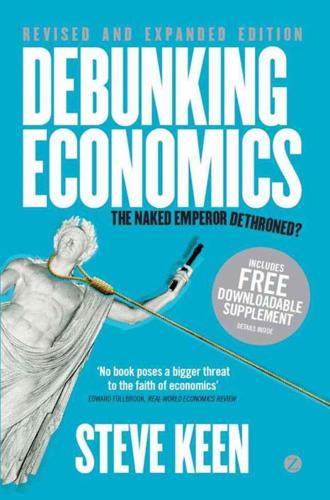
Debunking Economics - Revised, Expanded and Integrated Edition: The Naked Emperor Dethroned?
by
Steve Keen
Published 21 Sep 2011
TABLE 12.1 The alleged Money Multiplier process ($) In this simple illustration, all the notes remain in the banks’ vaults, while all commerce is undertaken by people electronically transferring the sums in their deposit accounts. Of course, we all keep some notes in our pockets as well for small transactions, so there’s less credit created than the example implies, but the model can be modified to take account of this. This process is also known as ‘Fractional Reserve Banking,’ and it’s the process that Obama, on the advice of his economists, relied upon to rapidly bring the Great Recession to an end. Its failure to work was superficially due to some issues that Bernanke was well aware of,8 but the fundamental reason why it failed is that, as a model of how money is actually created, it is ‘neat, plausible, and wrong.’
…
(Keynes 1936: xxii–xxiii; emphases added) It is therefore difficult to attack neoclassical ‘supply and demand’-oriented models of money as misrepresentations of Keynes. Nonetheless, the post-Keynesian school of thought has made the fundamental importance of money a byword of its analysis. An essential aspect of this has been the empirically based analysis of how money is created (detailed in the previous chapter), which contradicts the conventional fractional reserve banking, ‘Money Multiplier’ model of money formation. Having empirically eliminated one model of money creation, another was needed – but the initial attempts to create one were clumsy. Rather than the ‘vertical money supply curve’ of Hicks’s IS-LM model, some post-Keynesian economists proposed a ‘horizontal money supply curve’ in which banks simply passively supplied whatever quantity of credit money firms wanted, at the prevailing interest rate.
…
_Mencken. 8 The minimum fraction that banks can hold is mandated by law, but banks can hold more than this, weakening the multiplier; and the public can decide to hang on to its cash during a financial crisis, which further weakens it. Bernanke considered both these factors in his analysis of why the Great Depression was so prolonged: ‘In fractional-reserve banking systems, the quantity of inside money (M1) is a multiple of the quantity of outside money (the monetary base) […] the money multiplier depends on the public’s preferred ratio of currency to deposits and the ratio of bank reserves to deposits […] sharp variations in the money multiplier […] were typically associated with banking panics, or at least problems in the banking system, during the Depression era.

Life After Google: The Fall of Big Data and the Rise of the Blockchain Economy
by
George Gilder
Published 16 Jul 2018
You use big data statistics and Markov probability models when you don’t know what is really happening. Markov models are idiot savants that can predict either a random pattern or a planned process without the slightest understanding of either. For its future, the industry must move beyond them. At one point during my interview, Mercer challenged the prevailing regime of fractional-reserve banking. Citing the libertarian economist Murray Rothbard, he suggested that in an ideal system, the maturities of assets and liabilities would match. This is the view of an outside trader, governed by the Markovian present. The maturities do not match in almost any banking system because of the divergence between the motivations of savers and the sources of the value of savings.
…
But as he probed, he found a fundamental flaw: the belief that the money supply can and should be determined by the supply of bitcoin or gold—in other words, that gold (or bitcoin mimicking gold) should serve not only as a measuring stick or unit of account but as the actual medium for all exchanges. Such monolithic money was also the error of Murray Rothbard, an idiosyncratic exponent of Austrian theory who believed that any authentic gold standard must have 100 percent gold backing. He did not even believe in fractional reserve banking, intrinsic to the role of banks, which necessarily mediates between savers seeking safety and liquidity and entrepreneurs destroying it through long-term investments. The value of liquid savings is necessarily dependent on the achievements of illiquid and long-term enterprise. There is no way to avoid the maturity mismatch between savings and investments except by abolishing capitalism.
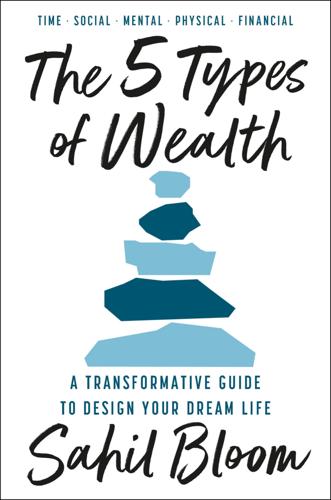
The 5 Types of Wealth: A Transformative Guide to Design Your Dream Life
by
Sahil Bloom
Published 4 Feb 2025
These paper banknotes, which could, in theory, be redeemed for actual gold in the vaults at the bank, became an effective currency. Clever governments and bankers realized that they could stimulate commerce and growth by issuing these paper assets above and beyond the actual gold or silver that was held in the vaults, a system known as fractional-reserve banking that became the standard operating procedure of banks around the world (and remains in place today). This system generally functions well unless all the depositors come and ask for their gold at once, in which case you have the makings of a classic bank run, where a seemingly healthy bank quickly becomes insolvent (a phenomenon we’ve seen as recently as 2023 with the rapid collapse of the well-respected Silicon Valley Bank).
…
(Catmull), 187 credit card debt, 341, 350 criticism, 171 CrossFit, 273 Cuddy, Amy, 194 curiosity, 206–8, 227 D Dahlstrom, Kevin, 263–64 danger, zone of, 237–39 Dark Ages, 269 Darwin, Charles, 272 data science, as meta-skill, 349 David (Michelangelo), 269 Davidson, Richard, 224 Dawkins, Richard, 214 De architectura (Pollio), 268 De arte gymnastica (The Art of Exercise) (Mercuriale), 272 Debt: The First 5,000 Years (Graeber), 322 deep work, 106–8 Deep Work (Newport), 106 defensiveness, 171–72 delete tasks, 97 demeaning relationships, 164–67, 200 depth, as pillar of Social Wealth, 150–52, 164–77, 199–200 design, as meta-skill, 348–49 dharma, 210–11, 340 DiCaprio, Leonardo, 367 Diderot, Denis, 196, 198 diet (see nutrition) Dillard, Annie, 234 dimmer switch concept, 48, 50 direct delegation, 110–11 distinctiveness, 214–15, 218 divorce, 170–71 Dodson, John, 304 doorknob question, 178–80 Drucker, Peter, 10 Duke University, 112 Dunbar, Robin, 135–36, 153 Dunbar’s number, 135 Duncan, Graham, 78–79 Dweck, Carol, 221–22 E earned status, as pillar of Social Wealth, 150, 154–57, 190–99 earned-status test, 197–98 East Rock Capital, 78 Ebbinghaus, Hermann, 243 Ebbinghaus Forgetting Curve (EFC), 243–44 Economist, The, 100 effective delegation, principles of, 109–11 Egypt (ancient), 68–69, 322 80/20 rule, 274 Einstein, Albert, 69, 75, 334 Eisenhower, Dwight D., 95 Eisenhower Matrix, 95–98, 109 Elli, 68 emergency funds, 341, 350 Energy Calendar, 86, 89–90, 122, 125 energy-creating pursuits, 235 energy-draining pursuits, 235, 238 engaging questions, 183–84 “Enjoy Yourself (It’s Later Than You Think)” (Lombardo), 59, 65 enough, 313, 315–16 Enough Life, 316–18, 338–40 episodic future thinking (EFT), 264 eudaemonia, 211 Evolution, Medicine, and Public Health journal, 155 exercise (see movement) expectation inflation, 329–30, 351 expense management, 312, 328–29, 335–36, 350–51, 363–65 eye contact, conversation and, 180 F facial expressions, conversation and, 180 family, time spent with, 61, 64–65, 76–77, 132, 141–42, 145–46, 150, 163, 368 farmland, 355 fats, 283, 291, 300 sources of, 299 fears, 52 feedback loops, infinite, 110 Feld, Brad, 174 Feldman, Jack, 305 Fernández, Enzo, 46 Feynman, Richard, 240 Feynman technique, 228, 240–42 Financial Wealth, 24, 72, 123, 368 core pillars of, 328–29, 335, 337–62, 363 defined, 27 five levels of, 334, 336 life arc example and, 49–50 Wealth Score quiz and, 32–33 Financial Wealth Guide, 336–65 best investment assets, 338, 352–57 career advice, 338, 345–47 Hacks I Know at Forty-Two I Wish I Knew at Twenty-Two, 338, 341–44 how to define Enough Life, 338–40 investments in yourself, 338, 361–62 meta-skills for high-income future, 338, 348–49 return-on-hassle spectrum, 338, 358–60 fittest, survival of the, 272 Five Love Languages, The: How to Express Heartfelt Commitment to Your Mate (Chapman), 169 5 Types of Wealth (see Financial Wealth; Mental Wealth; Physical Wealth; Social Wealth; Time Wealth) fixed mindset, 222–23 flexibility training, 281 Flint, Mike, 91 follow-ups, creative, 185–86 Fontaine, Jean de la, 7 Forbes magazine, 315 Fortune magazine, 140 4-7-8 method, 305 fractional-reserve banking, 324 Frankl, Viktor, 224 Franklin, Benjamin, 115–16, 221, 332 free time, happiness and, 83 friends, time spent with, 62–65, 139–40, 150–53, 161–63 Friends: Understanding the Power of Our Most Important Relationships (Dunbar), 153 friendship recession, 139 From Strength to Strength (Brooks), 161 Front-Row People, 131, 133, 151 frugality, 341–42 Fugger, Jakob, 319–21, 325 future time, 208 futures thinking, 264 G Galpin, Andy, 281 Gandhi, Mahatma, 223 Gates, Bill, 221, 248, 315 genetics, 137 Genghis Khan, 323 genius, zone of, 237–39 Georgia State University, 327 gestures, in public speaking, 194–95 gifts, 169 “Girl on Fire” (Keys), 193 Global Wellness Institute, 273 Glueck, Eleanor, 136–37 Glueck, Sheldon, 136–37 Go, Dan, 261–63 goals, 44–46, 48–51, 96, 125, 200, 257, 308, 364 Good Life, The (Schulz and Waldinger), 150, 164 Gottman, John, 170–71 Graeber, David, 322 Graham, Benjamin, 332 Grant, Adam, 165 Grant, W.
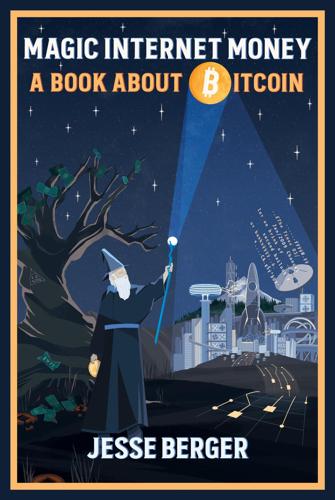
Magic Internet Money: A Book About Bitcoin
by
Jesse Berger
Published 14 Sep 2020
Central banks retain the sole, discretionary ability to create currency by making new entries into their own private, unaudited ledger, and also to set the baseline interest rate for lending throughout their subservient banking system. Once created, central banks deposit new currency with commercial banks, which distribute it through a process called “fractional-reserve banking.” This system grants commercial banks a license to create additional money that they do not possess, merely by issuing loans – credits – against existing deposits – debits – without actually withdrawing funds from those deposits. In other words, loans made by banks are not pre-existing funds lent from one account to another, properly balancing credits and debits.
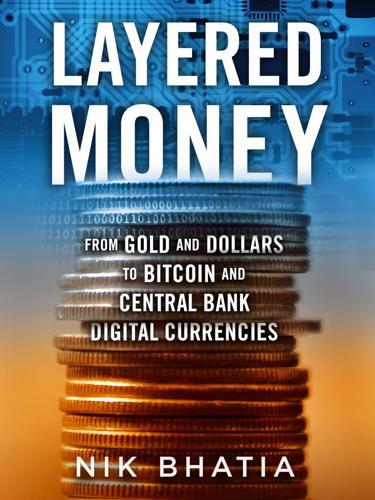
Layered Money: From Gold and Dollars to Bitcoin and Central Bank Digital Currencies
by
Nik Bhatia
Published 18 Jan 2021
He gets greedy and decides to capitalize on his newfound trustworthiness. He issues gold deposits to himself without properly reserving the corresponding gold in his vault and spends these deposits as cash into circulation. The goldsmith will then default if ever faced with a full redemption request. This type of activity is called fractional reserve banking, as opposed to full reserve banking when all deposits have corresponding gold in a vault. Gold exists as the goldsmith’s disciplinary constraint, serving as motivation not to abuse the power of money creation that comes with the public’s confidence in his deposits as a form of cash. Second-layer money is therefore inherently unstable, as the power to create it will always be subject to human abuse, similar to our example of the English goldsmith who abused the public’s confidence in his creditworthiness.
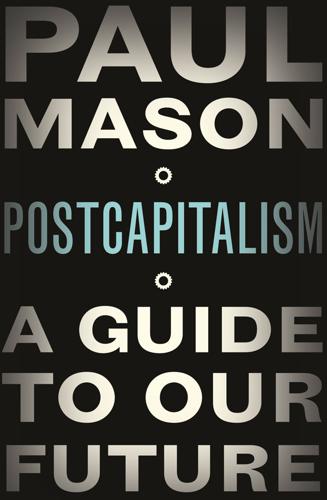
Postcapitalism: A Guide to Our Future
by
Paul Mason
Published 29 Jul 2015
The Cambridge economist Andrew Glyn believed the extraordinary success of the post-war boom could only be explained by ‘a unique economic regime’.22 He described this regime as a mixture of economic, social and geopolitical factors, which operated benignly throughout the upswing until they began to clash and grind in the late 1960s. State direction produced a culture of science-led innovation. Innovation stimulated high productivity. Productivity allowed high wages, so consumption kept pace with production for twenty-five years. An explicit global rules system amplified the upside. Fractional reserve banking stimulated a ‘benign’ inflation which, combined with financial repression, forced capital into productive sectors and kept speculative finance marginal. The use of fertilizers and mechanization in the developed world boosted land productivity, keeping the cost of inputs cheap. Energy inputs were, at the time, also cheap.
…
After a suitable amnesty offer, they would be tracked down and suppressed. These short-term, strategic measures could dismantle the ticking timebomb of global finance, but they do not yet constitute a design for a true postcapitalist finance system. A postcapitalist project would not seek – as the money fundamentalists do – the end to fractional reserve banking. In the first place, if it was attempted as a short-term remedy to financialization, it would cause demand to slump. Also, we need credit creation and an expanded money supply to wear down the debt pile that is strangling growth. The most immediate objective is to save globalization by killing neoliberalism.

Rise of the Robots: Technology and the Threat of a Jobless Future
by
Martin Ford
Published 4 May 2015
* When a central bank like the Federal Reserve “prints money,” it normally purchases government bonds. When it settles the transaction, it deposits money into the bank account of whomever it bought the bonds from. This is newly created money: it just appears out of nowhere. Once this new money is in the banking system, the idea is that banks can then loan it out. This is what’s known as fractional reserve banking. Banks have to keep a small percentage of the new money on hand, but they’re allowed to loan out most of it. The way things are supposed to work is that the banks loan the new money to businesses that can then expand and hire more people. Or the banks might loan to consumers who spend the money, thereby creating new demand.
…
See Earned Income Tax Credit (EITC) Elance, 95 El Camino Hospital (Mountain View, CA), 154 elder-care robots, 155–158 electricity, information technology compared to, 72–73 electronic offshoring, 59, 116 Elysium (film), 219–220, 220n email response program, 93–94 Emanuel, Ezekiel, 164 emerging economies, consumer demand in, 223–227 employment autonomous cars and, 176, 181–191 nanotechnology and, 246 offshoring and, 119–121 relationship between technology and, 175–176 3D printing and, 176, 177–181 See also unemployment Employment Policies Institute, 14 Engines of Creation (Drexler), 242, 244 ENIAC (Electronic Numerical Integrator and Computer), 32n environmental degradation, economic insecurity and, 283–284 equity endowments, 273–275 ESPN, 201 essays, machine grading of, 129–131 eugenics, 236n “Eureqa,” 108–109 Europe, college graduates overqualified for occupations in, 251 European Union, job polarization and, 50 Fabricated: The New World of 3D Printing (Lipson), 180 Facebook, xvi, 89, 92, 106, 114, 137, 152, 175, 231, 236 factory reshoring, 8–12 Fallows, James, 71 Fantastic Voyage (Kurzweil & Grossman), 235 fast food industry, 12–16, 209, 210 Fast Food Nation (Schlosser), 210 Fazzari, Steven, 199, 200, 214 Federal Drug Administration (FDA), 150n, 152, 171, 172 Federal Reserve, 218n Federal Reserve Bank of Cleveland, 44–45 Federal Reserve Bank of San Francisco, 54 feedback effects, 206, 208 Fernald, John G., 265, 266 Ferrucci, David, 99–100, 102n, 115 Feynman, Richard, 241, 243 Final Jeopardy (Baker), 96n, 102n financial crisis, debt and, 200, 214, 218–219 financial derivatives, 219 financial elite, political influence wielded by, 47–48, 59–60 financialization, 55–57 financial sector, 55–57, 103 Fluid, Inc., 103 food fabricators, 180, 246 food stamps, 201–202 Forbes (magazine), 84 “For Big Companies, Life Is Good” (Wall Street Journal), 39 Ford, Henry, 80 Ford, Henry, II, 193 Ford Motor Company, 76, 193 401k retirement plans, 222, 274 Foxconn, 10, 11, 14 fractional reserve banking, 218n France, 24, 41 Freeland, Chrystia, 51 freestyle chess, 122, 123 “freeters,” 221 “Free Trade’s Great, but Offshoring Rattles Me” (Blinder), 118 Frey, Carl Benedikt, 59, 223 Friedman, Milton, ix, 210–211 Friedman, Thomas, 133 The Gap, 17 Gates, Bill, 236 GDP (gross domestic product) consumer spending and, 199 corporate profits as share of, 40, 202, 203 finance-related activity as percentage of, 55 GDP (gross domestic product) deflator, 38n Genentech, 234 General Electric, 154, 179 General Motors, 76 The General Theory of Employment, Interest and Money (Keynes), 206 genetic programming, 108–109, 110 Georgia Institute of Technology (Georgia Tech), MOOCs and, 134–135, 142 Geraci, Robert, 235 Germany, 41 Ghayad, Rand, 45–46 globalization, 53–55, 116 glucose monitoring, 159 “Goggles” feature, 22 Gold, Jenny, 164 Goldman Sachs, 56 Good Data, 107 Google, xvi, 121, 236 Android system, 6, 21, 79, 121 artificial intelligence and, 231 autonomous cars and, xiii, 94, 182–183, 184, 186, 188, 189 big data and, 86 cloud computing and, 104, 106 cloud robotics and, 21 glucose monitor, 159 “Goggles” feature, 22 keyword-based search algorithm, 98–99 online language translation tool, 89–90, 130 personalized email and social response program, 93–94 profit and employee numbers, 76 revenue generation and, 76 robotics startup companies, acquisition of, 21n Singularity University and, 234 Thrun and Norvig and, 132 Udacity, 134 YouTube acquisition, 175 Gordon, Robert J., 65 government funding, of nanotechnology research, 242–243 government regulation of markets, 265 GPS (Global Positioning System), 209n Grabit Inc., 7–8 graphene nanotubes, 70n “gray goo” scenario, 244, 247 graying workforce, 220–223, 224 Great Recession corporate profits vs. retail sales during recovery from, 39–40, 202, 203 debt and, 200 increase in part-time jobs and, 49 jobless recovery and, 44–45, 280 productivity and, 207–208 “The Great Reversal in the Demand for Skill and Cognitive Tasks” (Beaudry, Green & Sand), 127 The Great Stagnation (Cowen), 65 Green, David A., 127 Grossman, Lev, 111 Grossman, Terry, 235 Grötschel, Martin, 71 guaranteed income.
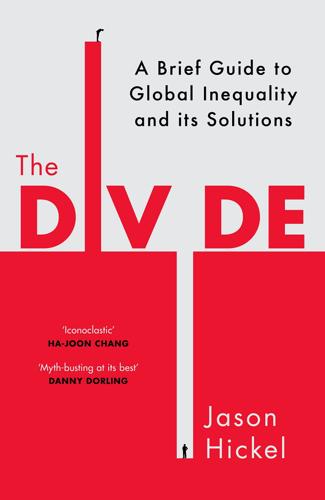
The Divide: A Brief Guide to Global Inequality and Its Solutions
by
Jason Hickel
Published 3 May 2017
When you walk into a bank to take out a loan, you assume that the bank is lending you money it has in its reserve – real money that it stores in a basement vault, for example, collected from other people’s deposits. But that’s not how it works. Banks are only required to hold reserves worth about 10 per cent of the money they lend out. This is known as ‘fractional reserve banking’. In other words, banks lend out about ten times more money than they actually have. So where does that extra money come from, if it doesn’t actually exist? The banks create it out of thin air. They loan it into existence. About 90 per cent of the money that is presently circulating in our economy is created in this manner.
…
In other words, almost every single dollar that passes through your hands represents somebody’s debt. And every dollar of debt has to be paid back with interest – with more work, more production or more extraction. The fact that our economy runs on debt-based currency is one big reason that it needs constant growth. Restricting the fractional reserve banking system would go a long way to diminishing the amount of debt sloshing around in our economies, and therefore to diminishing the pressure for growth. One easy way to do this would be to require banks to keep a bigger fraction of reserves behind the loans they make. But there’s an even more interesting approach we might try: we could abolish debt-based currency altogether.

Adaptive Markets: Financial Evolution at the Speed of Thought
by
Andrew W. Lo
Published 3 Apr 2017
And it’s sustainable, unless everybody wants out all at once, in which case it unravels. Is this another Ponzi scheme? No, it’s fractional reserve banking, the standard operating procedure of banks around the world. A bank usually keeps very little of its deposits on hand. The rest is used to invest—traditionally, by making loans to other bank customers. Is there potential for abuse here? Certainly. The early history of the United States is filled with stories about “wildcat banking,” banks that operated even less responsibly than the Madoff wealth management fund. But we’ve changed the institution of fractional reserve banking over time—once again, evolution at the speed of thought—so that it’s better adapted to our financial environment: the reserve requirements of Regulation D, the deposit insurance provided by the FDIC, and the lender-of-last-resort policies of the Federal Reserve system.
…
See also “Quant Meltdown” (August 2007) financial engineering, 212, 415 financial sector, 330–332 finches, 226–227, 240, 244 FINRA (Financial Industry Regulatory Authority), 360 financial technology, 248, 361, 399, 405 first-order false belief, 111 Fisher, Larry, 23 Fisher, Ronald Aylmer, 216–217 fixed-income arbitrage, 243, 293 fixed-rate commissions, 281 flash crashes, 358–359, 360 Food and Drug Administration (FDA), 404 food production, 8–9 footbridge dilemma, 339 foreign exchange, 12–16, 24, 38 Foundations of Economic Analysis (Samuelson), 177, 210, 212–213 Fouse, William L., 263 FOXP2 gene, 173–174 fractional reserve banking, 344 framing effects, 58–59, 388 France, 242 fraternal twins, 159, 161 Freddie Mac, 298, 379 Friedman, Milton, 25, 34 Fuld, Dick, 318 functional magnetic resonance imaging, (fMRI), 77–78, 86, 88–89, 90, 101, 102, 186, 337, 338 funds of hedge funds, 293 futures contracts, 20, 34, 243, 268, 273, 276, 356 future value, 98 Galapagos Islands, 225–227 gambling, 17, 59–60, 67, 88–89, 91–92, 186 game theory, 170, 179, 212, 217, 336 Gaucher disease, 418, 419 Gaussian distribution (bell curve), 22, 273 Gazzaniga, Michael, 113, 115–117, 123, 313 Gekko effect, 348, 391 Gekko, Gordon (fictional character), 345, 346, 349, 387, 417 GenBank, 402–403 general equilibrium theory, 212, 213 genome sequencing, 401, 402 Genzyme, 419 geo-engineering, 416 Germany, 242 Gerrold, David, 190 Getmansky, Mila, 317, 376 Gibbs, Josiah Willard, 20, 210 Gibson, Rajna, 353 Gift of Fear, The (de Becker), 1 Gigerenzer, Gerd, 216 Gilovitch, Thomas, 68–69 Gimein, Mark, 317 Glimcher, Paul, 99 glucocerebrosidase, 419 Goldman Sachs, 242, 287, 295, 307, 308, 324 Goldfield, Jacob, 311 Good Night, Gorilla (Rathmann), 135 Google, 405 gorilla, 150 Gould, Stephen Jay, 171, 172 Government Accountability Office (GAO), 308, 311, 351–352 government bonds, 249, 292; U.S.
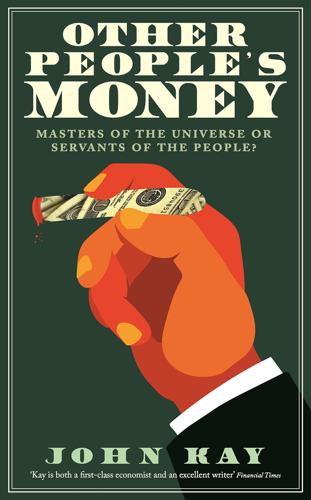
Other People's Money: Masters of the Universe or Servants of the People?
by
John Kay
Published 2 Sep 2015
Bankers discovered that they need keep only a fraction of the deposits placed with them in ready cash. Depositors would believe that they could access their money whenever they liked, although if they all did so at the same time, they could not. The liquidity illusion in finance has a variety of forms and different names – maturity transformation, fractional reserve banking, and even ‘money creation’. These esoteric terms contribute to the widespread notion that there is something mysterious and different about money, banking and finance. Yet there is nothing special about the idea of a service available on demand if, and only if, not many people take advantage of that availability.
…
Gerald 242 Countrywide Financial 150, 152, 293 Craig, James 26 credit cards companies 27, 210 debt 54 origin of 185–6 profitability 113 credit default swaps 41, 60, 61, 64, 73, 100, 101, 119, 120, 121, 139, 152, 153, 223 credit expansion 54, 98 Crédit Lyonnais 33 credit ratings 21, 101, 248 credit risk 42, 75, 177, 192 Crédit Suisse First Boston 167, 292 credit-scoring 84, 87, 290, 291 Crosby, James 125 crowd-funding 81 D Dad’s Army (television series) 12 Dahinden, Vincent 124 Daschle, Tom 230 debit cards 186 debt reduction 241 debt securities 101, 107 debt-to-value ratio 149 democracy 4, 52, 308 deposit channel 25–6, 147–8, 173–94 activities of 188–94, 189, 192 directed by retail banks 291 household wealth 173–80, 175, 179 the payment system 181–8 ring-fencing 194, 287 simplification needed 213 deposit insurance 25, 121 deposit protection schemes 135 Derbyshire Building Society 90 deregulation 13, 28, 31, 149–50, 151, 246–7, 292 derivative contracts 191, 192, 323n11 derivatives market 2, 19, 35, 38, 110 portfolios 98 regulation 57, 234 securities 2, 15, 17, 41, 71, 131 Detroit, Michigan 254 Deutsche Bank 33, 104, 136–8, 166, 169, 191–2, 192, 193, 200, 219, 222, 266, 282, 286, 303, 323n11 Diamond, Bob 34, 35, 261, 267, 295, 300 Dickens, Charles: Martin Chuzzlewit 201 Dimon, Jamie 14–15, 35, 231 Dirks, Ray 228 Disney, Walt 70, 71 diversification 21, 27, 28, 29, 32, 33, 45, 95–9, 153 ‘alternative assets’ 98 building societies 151 buying all available stocks 99 coin-tossing game 96 correlation 96, 97–8 Exchange Traded Funds 99 hedge funds 98–9 passive funds 99 diversification divorce 74 DLJ 313n15 Dodd-Frank regulatory regime 236–7, 271 Doerr, John 167 dollar devaluation (1971) 14, 36 Donoghue, Mrs 283 dot.com boom 40 Draghi, Mario 42, 139 Dreamworks 21 Drexel Burnham Lambert 46 drug use 22 ‘Dutch book’ 68, 116 E eBay 187 economic policy 240–69 the British dilemma 262–9 consumer protection 259–62 financial markets and economic policy 248–52 Maestro 240–48 pensions and inter-generational equity 252–9 Economist, The 115 ‘Edge, the’ 114–18, 288 Edinburgh Britain’s second financial centre 11, 263 investment trusts in 26 Edison, Thomas 196 education 253, 259 efficient market hypothesis (EMH) 69–70, 99 Einstein, Albert 129 El Paso oil business 117–18, 232 electricity 245–6, 278 eligible counterparty 282–3 Elizabeth II, Queen 161 Emanuel, Rahm 301 embezzlement 127 emerging markets 39, 42 Emerson, Ralph Waldo: The Conduct of Life 181 emperor’s guard’s new clothes, the 309–10 empire, decline of 13 Enron 123, 124, 126, 127, 158, 176–7, 197, 246, 317n5 Equitas 107 Equity Funding 228 equity markets 23, 85, 168–9, 249, 288 Ericsson 108 Espirito Santo 271 Eurodollar market 13, 20, 120, 121 European Central Bank 42, 98, 138, 139, 183, 243, 244 European Commission 184, 289 European Monetary System 184 European Parliament 184, 328n6 European Union (EU) 194, 220, 226, 228, 273, 287 Eurostat 250 Eurozone 158, 183, 243, 250 creation of 129 crisis 41–2, 139, 301 indebtedness in 184 exchange rates fixed 18 flexible 18 forward 73 Exchange Traded Funds (ETFs) 99 synthetic 99 exchange-traded funds 280 Exchequer Partnerships 158, 159 extended family 78 Exxon Mobil 96, 101, 120, 134, 161, 163, 164, 189, 196 F Facebook 81, 162–3, 166, 167, 185, 196 ‘fair value’ 125–6, 191 fallacy of composition 89 Fama, Eugene 69 family support 79 Fannie Mae 75, 91, 135, 152, 230, 317–18n5 Farkas, Lee 152, 293 FBI 131 febezzle (‘functionally equivalent bezzle’) 127, 128, 132, 136, 176, 177, 190 Federal Deposit Insurance Corporation (FDIC) 25, 135, 247 Federal Reserve Bank of Kansas City symposium (Jackson Hole, Wyoming, 2005) 56–7, 58, 73, 79, 102, 181, 236, 256, 280 Federal Reserve Bank of New York 57, 183, 232, 242, 243 Federal Reserve Board 5, 41, 56, 57, 58, 134, 183, 231, 240, 243, 245, 247 Federal Reserve System 13, 40, 90, 98, 150, 183, 245 Federated Department Stores 204 fee structures 204 Ferguson, Charles 236 Feynman, Richard P. 276, 327n3 Fidelity 109, 199, 200, 213 finance sector a bias to action 203–8 control of risk 6, 7 economic significance 6 excess in the industry 6 export contribution 265 greedy individualism 24 growth of 1–2, 33 heavy criticism of 233 as just another business 5 labour force 263 lack of sanction application 7 lobbying 230, 302, 306 major role in politics 4 management of household financial affairs 6 matching of borrowers and lenders 6, 7 past and current attitudes in 23–4 payments system 6, 7, 25, 281 profitability 132–40, 134 qualitative assessment 265 recurrent crises 35, 307 regarded as having unique status 4–5 remuneration 54, 112 role of 143 search 144 sense of personal entitlement 24, 300 share in GDP 264–5 skills 15 stewardship 144 structural reform 7 taxation 266–7 work incentives 7 workers in finance 6–7, 125 finance theory 5 Finance Watch 328n6 financial advisers 197, 199, 291 Financial Conduct Authority 230, 237, 261 Financial Products Group 293 financial sector, regulation of see regulation Financial Services Authority 243, 247, 303 Financial Services Compensation Scheme 260 Financial Times 68, 115 financialisation 4–7, 36, 45, 72, 163, 165, 172, 259 and complexity 276, 278 conflation of roles of agent and trader 198 and the conglomeration 133 direct impact of 176 effect on corporate behaviour 78 and emergence of large asset management companies 200 emphasis on monetary policy 241 in Germany 169 and hedge funds 289 and housing 149 national and international 39 and risk 55 and secondary markets 170 and social security 255 Summers supports 57 transition from agency to trading 84 two main componenents of 16 Fink, Larry 200 First Boston 200 First Data Corporation 186 First World War 221 fiscal arbitrage 122, 123, 223 FISIM (financial services indirectly measured) 264 Fitch rating agency 313n6 Fitzgerald, Scott: The Great Gatsby 17, 297 FitzPatrick, Sean 156, 293–4 Five Star Movement 306 fixed commissions 29 fixed interest, currency and commodities (FICC) 22, 107, 110, 111, 118, 125, 160, 191, 194, 288 fixed-interest securities 190, 193 Flaubert, Gustave: Sentimental Education 80 Florida land boom (1920s) 201 Forbes magazine 204, 231 Ford, Henry 45, 70, 71 foreign exchange transactions speculators in 18–19 value of 2 Fortune magazine 23 ‘four horsemen’ 167, 168 Fox, Justin 70 fractional reserve banking 88 France corporatism 303–4 defeat of Sarkozy 248, 249 downgraded bonds 248, 249, 250 housing 149, 174 ‘trente glorieuses’ 36 Frankfurt financial centre 26 Freddie Mac 75, 135 free market 18, 59, 238, 247, 302 Frick, Henry Clay 44 Friedman, Milton 60, 63 Free to Choose 56 front running 28 FrontNational 306 Frost, Robert: ‘Provide, Provide’ 252 FT Alphaville 16 Fuld, Dick 24, 32, 72–3, 75, 231, 293 full employment 241 fund managers 66, 86, 108, 115, 206, 209, 212 future of finance 297–308 futures 19 G G8 and G20 economic summits 220 Galbraith, J.K. 127, 201 Galton, Francis xi gambling 130–31, 289 close regulation of 71, 72 Lloyd’s coffee house 71–2 lottery 65, 66, 68, 72 Gates, Bill 174, 268 Gaussian copula 22 GEC 48, 51 GEICO 107 Geithner, Timothy 57–8, 73, 75–6, 92, 104, 183, 230, 232, 239, 276, 306, 307 Geithner doctrine 271 Gemeinschaft 17, 61, 255 General Electric 46, 196 General Motors 45, 49 general share price indexes 98 Generali 27 Generally Accepted Accounting Principles (GAAP) 193 Gensler, Gary 288 Germany corporatism 303, 304 ‘economic miracle’ 36 housing 149, 174 indebtedness to 183–4 Landesbanken 169 Mittelstand 52, 168, 169, 170, 171, 172 role of Bundesbank 243 social market economy 219 state pensions 253 Gesellschaft 17, 61, 255 Gingrich, Newt 230 Glass-Steagall Act (1933) 25, 28, 33 Glaxo 96 global financial crisis (2007–9) and bank assets 91 bankers’ cognitive dissonance 102 begins in the USA 41 causes of 194, 220, 271 collapse of asset-backed securities market 21 collapse of sub-prime mortgages 109 costs of 285 and derivative contracts 192 and diversification 32 emergency measures 285–6 Gaussian copula 22 and liquidity 188, 278, 286 misallocation of housing finance 148 most culpable figures 293 unprecedented public intervention 41 the worst financial crisis since the Great Depression 15 globalisation 13 of capital flows 176, 180 of financial markets 17 and income inequality 53–4 pressure on regulatory structures 14 ‘gnomes of Zurich’ 18 gold standard 13, 18, 36, 181, 241 Golden Dawn 306 Goldman Sachs 1, 14, 31, 55, 57, 59, 63, 104–5, 114, 115, 117, 118, 120, 135, 143, 158, 160, 164, 232, 233, 250, 258, 266, 282, 283, 284, 288, 294, 300, 306 Code of Business and Ethics 118 Goldsmith, Oliver: The Deserted Village 49 goodwill 31, 258–9 Goodwin, Fred 14, 34, 149, 156, 169, 231, 293 Google 80, 83, 162, 167, 196 Gould, Jay 44 government assets and liabilities 000 government bonds 17, 42, 86, 155, 178, 208, 222, 290 government debt 128, 178, 190, 203, 245, 250, 251 government spending 253 Graham, Ben 176 Grasso, Dick 49 Great Depression 12, 15, 25, 36, 57, 218, 221, 225, 258, 308 ‘Great Moderation, the’ 40, 57, 104 Greece accounting manipulation 158, 250 adoption of a common currency 41 government debt 42, 128 refinancing of Greek credit 42 Greenspan, Alan 57, 63, 104, 119, 181, 245, 276 and Ayn Rand 79, 240 and ‘Black Monday’ 242 chairman of the Federal Reserve Board 56, 58, 181, 240–41, 242 and Fed priorities 247–8 and the Markowitz model 68–9 and mortgage defaults 97 and risk 73 testimony to Congress 67–8, 240 ‘Greenspan doctrine’ 56, 60, 67, 68, 71, 87, 101, 249 ‘Greenspan put, the’ 242, 249 Grillo, Bepep 306 Grimaldis of Monaco 123 gross domestic product (GDP) 251, 256, 264–5, 265, 266 gross national income (GNI) 265–6 gross value added (GVA) 265 group insurance 76–7 Grubman, Jack 293 H Haldane, Andrew 139, 264 Halifax Building Society 31, 32, 140, 164, 258–9 becomes a public company 124 competition for the ‘talent’ 193–4 ‘the Edge’ established in wholesale financial markets 114 and fixed-interest securities 190, 193 Group Treasury 106, 107, 111, 129 origins 106 rescued by the British government 124 response to changing times (1990s) 129 takes over the Bank of Scotland 124, 125 the world’s largest mortgage lender 106 worthless windfall shares 127–8 Hamamatsu Photonics 168 Hambrecht & Quist 167 Hambros Bank 158 Hanson 45, 46–7 ‘hard’ commodities 17 Harding, David 111–12, 124 Hartlepool nuclear power station, northeast England 158 Harvard University 5, 14–15 Harvey-Jones, Sir John 51 Hawkins, Sir Henry 61, 64, 116 Hayek, Friedrich 225 HBoS 32, 91, 124, 125, 135 healthcare 77, 78, 79, 253, 257–8 hedge fund managers 23, 99, 109, 282 Hedge Fund Research 323n9 hedge funds 27, 98–9, 110, 191, 194, 284, 289, 323n9 hedge fund centre, Mayfair, London 263 Helyar, John 46, 164 Henderson, David 58 ‘hidden champions’ 168 high-frequency trading 2, 111, 280, 305 Hill, Lord 322n14 Hope, Bob 160 Hornby, Andy 14 horse-racing 72, 116 House of Commons library 115 House of Lords 283 House of Morgan 25, 35 Household International 34–5 housing 148–54, 290 causes of crisis in housing finance 153 collapse of thrifts 150 equity release 54 house prices (US) 41, 43, 174, 259 houses as physical assets 146–7 low-cost 79 mortgage defaults 97 owner-occupied housing stock 53, 149, 151 specialist lenders 150 HSBC 1, 24, 34–5, 286, 328n22 Hubler, ‘Howie’ 130 Hurricane Katrina (2005) 79, 256 I Ibsen, Henrik: An Enemy of the People 285 Iceland: bank and compensation scheme collapse 260 ICI 45, 46–8, 51, 78 Iksil, Bruno 35, 130 ‘I’ll be gone, you’ll be gone’ culture 125, 128, 129, 131, 133, 152, 156, 204, 273 imperialism 13, 218 income distribution 52–4, 53 Independent Commission on Banking 139, 287 India, economic growth in 53 inflation 36, 54, 178, 241–2, 258 information asymmetry 60, 74, 76, 251, 317n2 information technology 18, 19–20, 31, 168, 185 infrastructure, property and 154–60 initial public offering (IPO) 113 Inside Job (film) 236 insurance companies 16, 27, 29, 120, 197, 199, 208, 213, 264 Intel 29, 167 interest rates and inflation 241, 242 long-term 251 intergenerational accounting 258 intermediation 80–105 bad intermediaries 81–2 competition 271 direct/indirect 82, 83 and diversification 96 facilitating 7 and the internet 81 leverage 100–105 managed 83, 201, 212–13 the role of the middleman 80–99 total costs of 207 transparent 83, 84, 201–2, 203 International Financial Reporting Standards (IFRS) 193 International Labour Organization (ILO) 263 International Monetary Fund (IMF) 13–14, 38, 39, 56, 58, 139, 220, 302 international reply coupons 131 International Swaps and Derivatives Association (ISDA) 61, 119, 193 internet 182, 183, 185 connectedness 81, 83 and intermediation 81 Interstate Commerce Commission 233, 237 investment banking FICC trading 107 global expansion of American banks 33 investment trusts 26, 27 relationships 16 within commercial banks 22 investment banks boutique 205 ‘dark pools’ 29 economists in 248–9 legal partnerships 30 modern objectives 197 and rating agencies 249 and search 197 investment channel 26, 148, 174, 175, 195–213 a bias to action 203–8 fails to meet the needs of businesses and households 213 investable assets 202–3, 203 the role of the asset manager 208–13 simplification needed 213 and sovereign wealth funds 253 stewardship 195–203, 203 investment companies 26, 27, 96, 177, 197, 199, 200, 201, 202 investment funds closed-end (managed) 212 open-ended (transparent) 212 Investor B 108 investors allocation of risk 57, 60, 73 and credit ratings 21 foreign 39 institutional 23, 28, 46 large 98 and leverage 101 long-term 94 losses of 43 private 28 property 99 retail 66 small 30, 99 sophisticated 23 Ireland bank workers’ strike (1970) 182 collapse of banking system (2008) 42, 138, 182 Isaacson, Walter 71 Ishmael, Stacy-Marie 16 Israel defence forces 171 high-technology start-up sector 117 It’s a Wonderful Life (film) 12–13 ITT 45 J Japan credit expansion 98 economic growth 36, 39 imagined competitive threat from 221 and quantitative easing 245 speculative bubble (late 1980s) 38–9, 280 jobbers 25, 28, 29–30 Jobs, Steve 70, 71, 162, 196 Johnson, Simon 302 Jordan Marsh department store 46, 90 J.P.
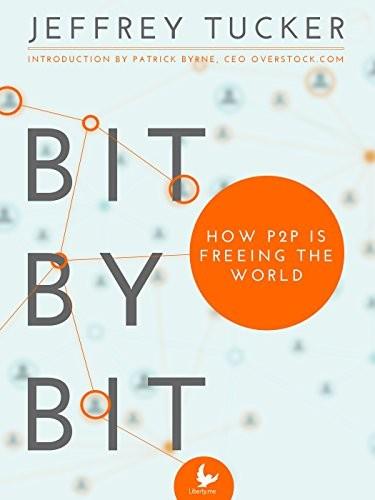
Bit by Bit: How P2P Is Freeing the World
by
Jeffrey Tucker
Published 7 Jan 2015
There have been instances of double spending in the slice of time after transfer and before confirmation but systems are protecting against that unlikely scenario ever more regularly and efficiently. Dollars, on the other hand, depend fundamentally on double spending. That’s the essence of fractional reserve banking as subsidized by the central bank’s power to inflate. Question: What about the size of the blockchain? Could that be a problem? Answer: The blockchain is growing in size, and, yes, that is a problem. But developers are always at work on fixes to improve the efficiency and scalability of the ledger, which will grow until the end of time.

More: The 10,000-Year Rise of the World Economy
by
Philip Coggan
Published 6 Feb 2020
Since notes (and other forms of paper money like letters of credit) were so convenient, banks quickly found that most of the gold and silver they held stayed in the vaults. Only a small proportion was withdrawn each day. They could lend out this “spare” money and earn a profit. This is the essence of “fractional reserve” banking and thus the modern banking system. Central banks could operate with a similar leeway. For much of the period from the early 18th century to 1914, Britain operated under the gold standard. Customers could exchange their notes for gold coins if they wished. Other countries joined the standard in the course of the 19th century.
…
The result was that long-run inflation was absent in the 19th century; the cost of a taxi ride was the same at the end of the century as it had been when the Bank of England was founded.4 But the gold standard raised tricky questions when the economy suffered a shock. One obvious example of a shock was the failure of a commercial bank. Fractional reserve banking is prone to crises. Banks have a natural mismatch. They owe money to depositors who can withdraw it at any time, while on the other side of their balance sheets they lend money to individuals and businesses for long periods. If enough depositors want to withdraw their money at once, even a well-run bank will get into trouble.
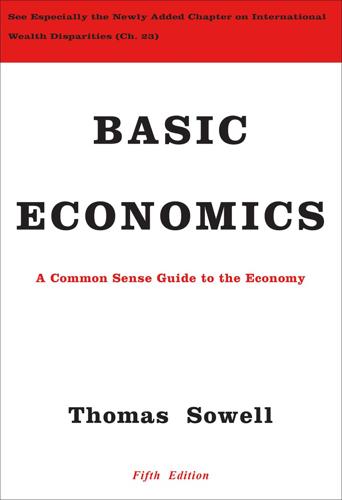
Basic Economics
by
Thomas Sowell
Published 1 Jan 2000
But what the banking system does, over and beyond what other financial intermediaries do, is affect the total demand in the economy as a whole. The banking system creates credits which, in effect, add to the money supply through what is called “fractional reserve banking.” A brief history of how this practice arose may make this process clearer. Fractional Reserve Banking Goldsmiths have for centuries had to have some safe place to store the precious metal that they use to make jewelry and other items. Once they had established a vault or other secure storage place, other people often stored their own gold with the goldsmith, rather than take on the cost of creating their own secure storage facilities.
…
Both banks could keep just a fraction of their deposits in cash because all the checks written on all the banks require just a fraction of the total amounts on those checks to settle the differences between banks. Since all depositors would not want their money in cash at the same time, a relatively small amount of hard cash would permit a much larger amount of credits created by the banking system to function as money in the economy. This system, called “fractional reserve banking,” worked fine in normal times. But it was very vulnerable when many depositors wanted hard cash at the same time. While most depositors are not going to ask for their money at the same time under normal conditions, there are special situations where more depositors will ask for their money than the bank can supply from the cash it has kept on hand as reserves.
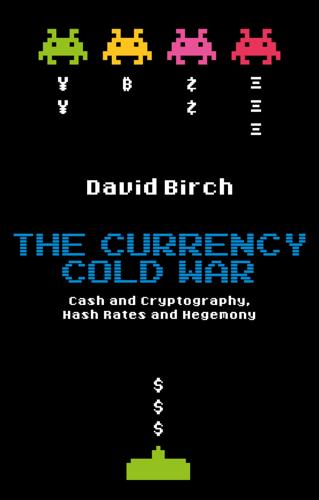
The Currency Cold War: Cash and Cryptography, Hash Rates and Hegemony
by
David G. W. Birch
Published 14 Apr 2020
This takes us into the world of decentralized finance discussed earlier, which I am not framing as either good or bad here, because it is neither. In a European Parliament report, Fiedler et al. (2018) noted the implications of market participants shifting liquidity away from bank deposits to digital currencies, saying that the ‘current fractional reserve banking system would be challenged at its core’. Their report points out that commercial banks would need to come up with funding sources other than deposits, but ‘as the fractional reserve character of the current banking system can be a major source of instability’, this might not be a bad thing: quite the contrary, in fact.
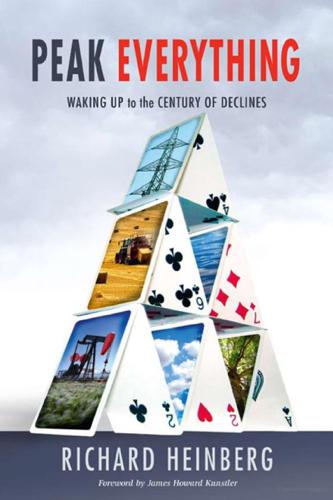
Peak Everything: Waking Up to the Century of Declines
by
Richard Heinberg
and
James Howard (frw) Kunstler
Published 1 Sep 2007
Once the fuel revolution began, with vastly more energy available per capita, economic activity achieved seemingly perpetual exponential growth, and economic theories emerged not only to explain this growth in terms of “markets,” but to affirm that now, because of markets, growth was necessary, inevitable, and unending. World without end, amen. Fractional-reserve banking, based on the wonder of compound interest, served as the fiscal embodiment of these new expectations. In effect, within the minds of society’s managers and policy makers, faith in technology and markets supplanted previous religious faith in the hallucinatory agricultural and herding deities that had presided over Western civilization for the previous couple of millennia.
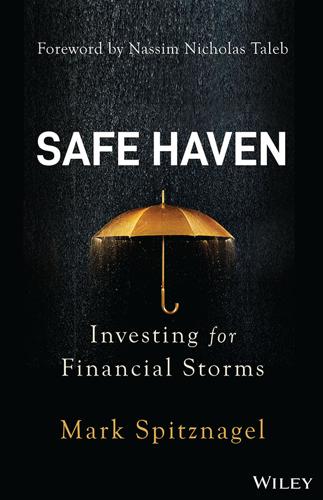
Safe Haven: Investing for Financial Storms
by
Mark Spitznagel
Published 9 Aug 2021
The cartoon insurance payoff, you will recall, is marked by an explosive crash payoff, relative to the losses expected to be experienced the rest of the time. In the general folk wisdom of safe havens, gold is often considered to be an insurance‐like hedge against broad market losses. It is the talisman of fear, and even thought of as protection against banking system collapse, as it is a means to extract savings from the fractional reserve banking system. Of course, gold is perhaps first and foremost thought of as a hedge against inflation. However, it's actually a very noisy hedge against inflation. It is mostly (even almost entirely) tied to movements in real interest rates. (When inflation goes up faster than nominal interest rates, real rates go down, pushing up gold prices.
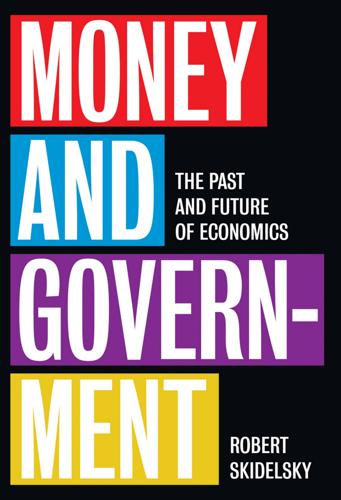
Money and Government: The Past and Future of Economics
by
Robert Skidelsky
Published 13 Nov 2018
Friedman believed that the monetary base – notes, coins and the cash reserves of commercial banks – was the best indicator of future changes in the total money stock, and consequently of the future rate of price increases. Total money stock included bank deposits. Empirical studies were held to demonstrate a ‘reasonably stable ratio between reserves to deposits over the long-run’32 (the money multiplier in a fractional reserve banking system). Since the quantity of cash was fully under central bank control, it was argued that ‘changes in the quantity of cash, reflecting central bank operations’ determined the level of bank deposits and, hence, of the money supply’.33 This is a straightforward QTM argument, exactly the same as Keynes’s in 1923.
…
How this rise will be shared between output and prices will depend on the size of the output gap.33 How much extra money will Santa Claus need to spray round the community to achieve a given inflation target? In the Fisher theory the answer was given by the money multiplier: the amount of new bank loans which can be created by an increase in reserves (‘base money’) in a fractional reserve banking system. If the reserve requirement is 10 per cent, an injection of £1,000 will enable additional loans of £900, leading to additional spending and deposit creation, with the total of new money summing to a multiple of the original injection.34 If the money multiplier is known, then so will be the effect of any given amount of QE on nominal income (output plus prices). 258 t h e n e w mon e t a r i s m However, if the money-multiplier mechanism is leaky, the amount of new money needed to raise nominal income to a desired level is unknown.
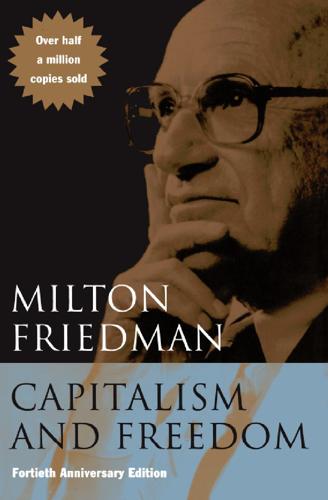
Capitalism and Freedom
by
Milton Friedman
Published 1 Jan 1962
A wave of bank failures would taper down a while, and then start up again as a few dramatic failures or other events produced a new loss of confidence in the banking system and a new series of runs on banks. These were important not only or even primarily because of the failures of the banks but because of their effect on the money stock. In a fractional reserve banking system like ours, a bank does not of course have a dollar of currency (or its equivalent) for a dollar of deposits. That is why “deposits” is such a misleading term. When you deposit a dollar of cash in a bank, the bank may add fifteen or twenty cents to its cash; the rest it will lend out through another window.

Broken Markets: A User's Guide to the Post-Finance Economy
by
Kevin Mellyn
Published 18 Jun 2012
From 1865 to 1914, most of the capital to build the US industrial base and infrastructure was raised in London, and American trade was financed and external claims were settled in sterling. America only briefly joined the gold standard, but instead pursued a liberal (as in loose) domestic credit system based on fractional reserve banking, and until 1913 eschewed the discipline of central banking. Britain accepted and even clung to the burden of maintaining a reserve currency until forced to impose strict exchange controls at the outbreak of war in 1939 largely through its governing class’s confusion between national prestige and practical economics.
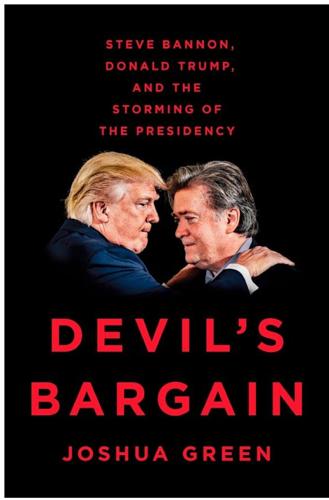
Devil's Bargain: Steve Bannon, Donald Trump, and the Storming of the Presidency
by
Joshua Green
Published 17 Jul 2017
From a distance, his hard-line antigovernment views appeared no different from those of any number of financial-industry power moguls scattered throughout the country, whose collective fortune financed the Republican Party and its affiliated think tanks and pressure groups. Up close, however, Mercer was . . .well, he was different. He resembled the bloodless capitalist hero in an Ayn Rand novel. Mercer wanted to bring back the gold standard and abolish the fractional-reserve banking system upon which the modern economy is built. He funded an Idaho activist who foments legal challenges to environmental laws, claiming they are part of a United Nations plot to depopulate rural America. He was once overheard by a Renaissance colleague insisting that radiation from the atomic bombs dropped on Japan in World War II actually improved the health of people outside the blast zone.
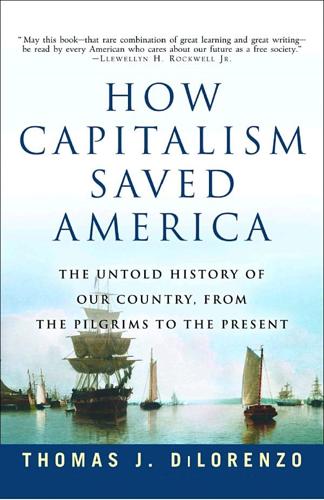
How Capitalism Saved America: The Untold History of Our Country, From the Pilgrims to the Present
by
Thomas J. Dilorenzo
Published 9 Aug 2004
Menlo Park, CA: Institute for Humane Studies. An excellent and comprehensive exposition of the economics of government interventionism. ———. What Has Government Done to Our Money? Santa Ana, CA: Rampart College, 1974. An explanation of why the gold standard is consistent with free-market capitalism but fractional reserve banking is not. Schweichart, Larry. The Entrepreneurial Adventure: A History of Business in the United States. New York: Harcourt Brace, 2000. A history of entrepreneurship in America from the colonial era up through the age of Microsoft. Simon, Julian L. The Ultimate Resource. Princeton, NJ: Princeton University Press, 1981.
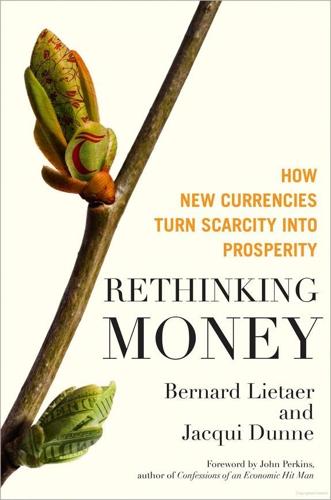
Rethinking Money: How New Currencies Turn Scarcity Into Prosperity
by
Bernard Lietaer
and
Jacqui Dunne
Published 4 Feb 2013
Kung culture, 47; time currency and, 80– 81, 84– 85 Favela, 141 Fear, 4 Federalism, 69 Federal Reserve Act of 1913, 25–26 FEMA, 170–171 Fiat money, 26–28; creditos as, 184–185; inflation and, 91; as social construct, 58 Finite world, 42, 44, 192–193 Fisher equation, 63– 64 Flow network, 32– 33, 61– 63 Fomentos, 105 Food chain, 61 Food stamp, 12 Forgery, 184–185 Fractional reserve banking, 25–26, 39– 40, 228n1, 228n4 Fractional reserve multiplier, 40, 228n1 Fraud, 146–147, 194; counterfeiting, 184–185; emergency currencies and, 170–171; fraudulent currency initiatives, 192 Free clinic, 162–165 Free Lakota Bank, 113–114 Free market, 28, 31– 32, 35, 217 Free money, 176–178 Freigelt, 176–178 Frequent flyer miles: computers enabling, 60– 61; as cooperative currency, 59, 74; inflation and, 92; in multicurrency world, 55 Friendly Favors (FF), 132–133, 183–184 Fuel, 126–128 Functional currency, 199, 201 Fureai kippu, 166–169 Futility, 20 Game, 156–157 Garbage.
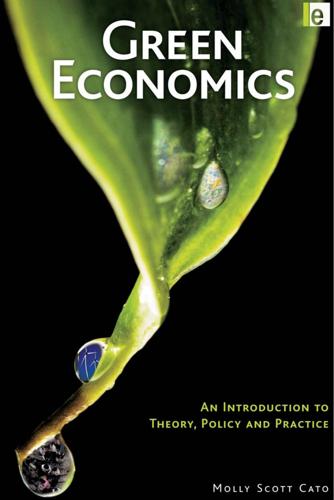
Green Economics: An Introduction to Theory, Policy and Practice
by
Molly Scott Cato
Published 16 Dec 2008
LETS’ major achievement in the UK context is to educate people in the nature of money and work; this is the central reason for the interest in such schemes on the part of green activists as well as green economists. Local currencies for a localized world The justification for the creation of money by fractional reserve banking, i.e. more money than there are real assets to support it, is that it stimulates economic activity. While green economists are concerned to link this to a level of economic activity that the planet can sustain, they are frequently in favour of the creation of money on a local basis to stimulate local production and exchange.
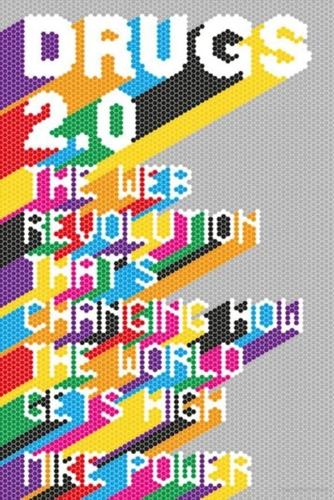
Drugs 2.0: The Web Revolution That's Changing How the World Gets High
by
Mike Power
Published 1 May 2013
As if to illustrate this, one truly psychedelic item was put up for sale on the Silk Road in July 2011, when a vendor named Uglysurfer offered pound weights of American copper pennies for 10.43/lb. The face value of the pennies was US$14.60, but at the time, copper prices were such that the metal contained within a American penny was worth almost three cents. Uglysurfer was demonstrating that the ‘fiat’ system of money and fractional reserve banking, whereby banks can and do create money from thin air, was not to be trusted. ‘Under the best conditions, I could walk into a bank and provide US$25 dollars in paper Federal Reserve Notes, and walk out with a box of 95 per cent copper pennies with a metal value of approximately US$64 (in copper),’ he explained.
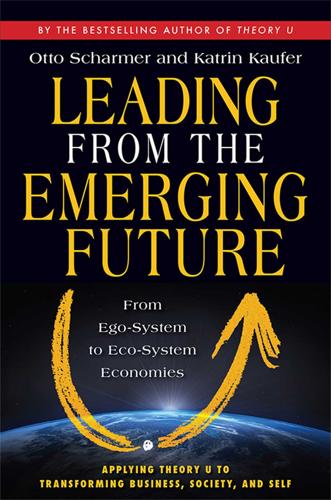
Leading From the Emerging Future: From Ego-System to Eco-System Economies
by
Otto Scharmer
and
Katrin Kaufer
Published 14 Apr 2013
Susan Sweitzer, “Sustainable Food Laboratory: Learning History,” unpublished internal document provided by the author, 2004. 23. Hawken, Blessed Unrest. 24. World Wildlife Fund remains WWF’s official name in Canada, the United States, and the United Kingdom. 25. Banks also hold a competitive advantage over nonbanks through what is called fractional-reserve banking, which allows banks to invest more than they hold as deposits. 26. See www.gabv.org/ (accessed December 10, 2012). 27. On the distinction among purchase, lending, and gift money, see Rudolf Steiner, Rethinking Economics: Lectures and Seminars on World Economics (Great Barrington, MA: SteinerBooks, 2013). 28.

MegaThreats: Ten Dangerous Trends That Imperil Our Future, and How to Survive Them
by
Nouriel Roubini
Published 17 Oct 2022
The commercial banking business model might shudder, faced with risk on a scale far greater than fintech firms pose. Banks hold cash and cash-equivalent deposits for individuals and firms. They retain a small amount of these deposits in liquid assets and lend the rest in the expectation that depositors will never claim more than a fraction of their assets. This arrangement fuels the fractional reserve banking system. Demand deposits become long-term loans that banks record as assets. In this scenario, CBDCs create two serious risks to financial stability. The first is disintermediation as depositors move funds from commercial banks to central banks. Survival would mean converting banks into financial institutions that replace low-cost deposits with long-term borrowing at market rates to finance their long-term loans and mortgages, squeezing if not eradicating their profits.
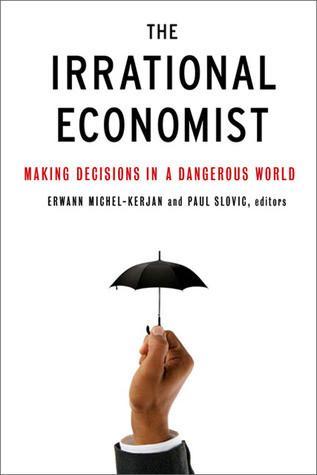
The Irrational Economist: Making Decisions in a Dangerous World
by
Erwann Michel-Kerjan
and
Paul Slovic
Published 5 Jan 2010
Philadelphia: University of Pennsylvania Press. 16 Dumb Decisions or as Smart as the Average Politician? Economic and Behavioral Explanations for Insurance Demand MARK V. PAULY INTRODUCTION Insurance is one of mankind’s greatest inventions. I used to rank it just a little behind fractional reserve banking—a modern banking practice in which banks keep only a fraction of their deposits in reserve and lend out the remainder—which by its nature expands money supply beyond what it would otherwise be. But the recent turmoil in capital markets (with insurance not totally unaffected) suggests that the two financial instruments may now be even.
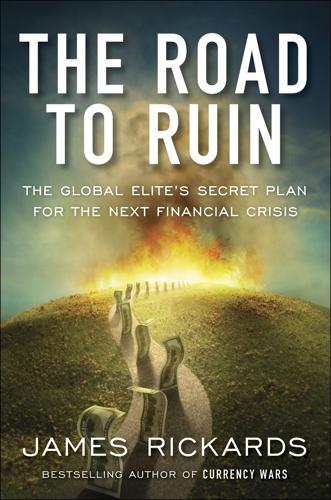
The Road to Ruin: The Global Elites' Secret Plan for the Next Financial Crisis
by
James Rickards
Published 15 Nov 2016
Renaissance bankers realized they could put the gold in their custody to other uses, including loans to princes. This left more notes issued than physical gold in custody. Bankers relied on the fact that the notes would not all be redeemed at once, and they could recoup gold from princes and other parties in time to meet redemptions. Thus was born “fractional reserve banking,” in which physical gold held was a fraction of paper promises made. There has been no end of mischief since. Despite the advent of banking, notes, and fractional reserves, physical gold retained its core role as world money. Princes and merchants still held gold coins in purses and stored gold in vaults.
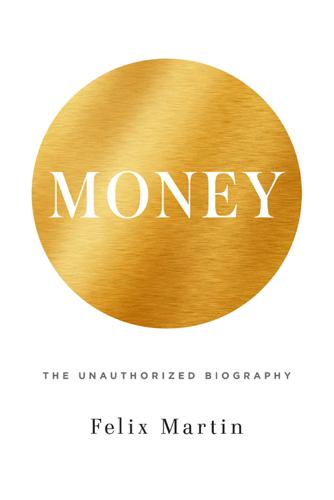
Money: The Unauthorized Biography
by
Felix Martin
Published 5 Jun 2013
Above all, there was the sovereigns’ interest in ensuring the continuing priority of their money, and hence their seigniorage. As a result, the new invention of banking was subjected to draconian regulation. When in 1321 the authorities in Venice discovered that merchants were practising fractional reserve banking—holding only a small proportion of their assets in coin of the state—they passed a law specifying that banks must be able to meet all requests for withdrawals in coin within three days.16 In the same year the Catalonian authorities revised their 1300 order that failed bankers be forced to live on bread and water alone until all their clients were reimbursed.
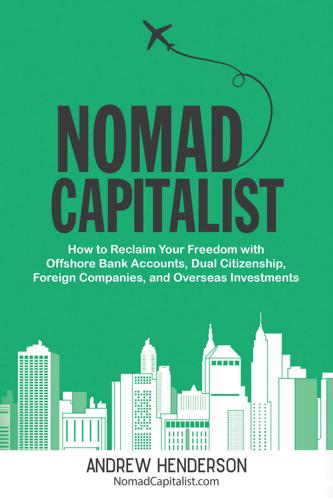
Nomad Capitalist: How to Reclaim Your Freedom With Offshore Bank Accounts, Dual Citizenship, Foreign Companies, and Overseas Investments
by
Andrew Henderson
Published 8 Apr 2018
Relatively few people who live in any of them are worried about a banking system collapse, even as the majority of people in each country use said banks merely because they are part of the ‘home team.’ To an astute financial observer, there is also little difference. While the countries are all wealthy, they are also all broke. To top it off, all three offer fractional reserve banking systems with low levels of liquidity — that is, most of the money deposited is not sitting around the bank. If they are all the same, why doesn’t everyone in the United States just put all of their money into banks in the UK or Ireland where they will get a higher return? Why indeed.

Free to Choose: A Personal Statement
by
Milton Friedman
and
Rose D. Friedman
Published 2 Jan 1980
If, as is typically the case, you deposit not currency but checks on other banks, your bank does not even have currency in hand to deposit in a vault. It has only a claim on another bank for currency, which it typically will not exercise because other banks have matching claims on it. For every $100 of deposits, all the banks together have only a few dollars of cash in their vaults. We have a "fractional reserve banking system." That system works very well, so long as everyone is confident that he can always get cash for his deposits and therefore only tries to get cash when he really needs it. Usually, new deposits of cash roughly equal withdrawals, so that the small amount in reserve is sufficient to meet temporary discrepancies.
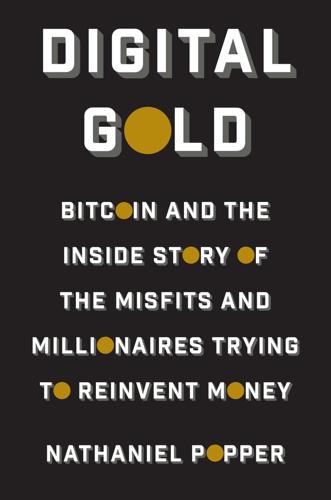
Digital Gold: Bitcoin and the Inside Story of the Misfits and Millionaires Trying to Reinvent Money
by
Nathaniel Popper
Published 18 May 2015
Within a few weeks of his initial exchanges with Satoshi, Martti had totally revamped the Bitcoin website. In place of Satoshi’s original version, which presented complicated descriptions of the code, Martti led off with a brief, crisp description of the big ideas, aimed at drawing in anyone with similar ideological interests. “Be safe from the unstability caused by fractional reserve banking and the bad policies of the central banks,” read the newly designed site. The onslaught of new users was slow to arrive, however. A few dozen people downloaded the Bitcoin program in June, to add to the few hundred who had downloaded it since its original release. Most had tried it once and then turned it off.
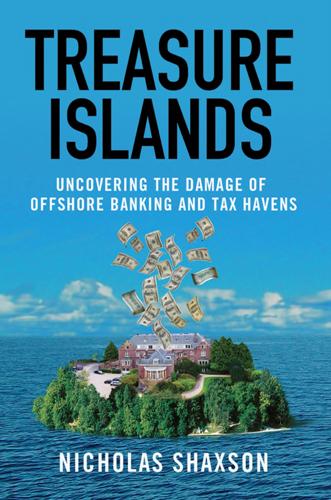
Treasure Islands: Uncovering the Damage of Offshore Banking and Tax Havens
by
Nicholas Shaxson
Published 11 Apr 2011
Under a 10 percent reserve requirement, the bank may lend out only $90 of that to someone else. That person now has $90 to spend, and that $90 will end up in another bank account. That next bank may then lend 90 percent of that $90 out—so $81 more will end up being lent. And the process goes on. This is a well-known principle of so-called “fractional reserve banking,” and if you follow the calculations through you will find that with a 10 percent reserve requirement your $100 theoretically balloons out into $1,000, spread across the economy. Money really is conjured out of thin air like this: This is what banks do. Money is created by the act of lending it.
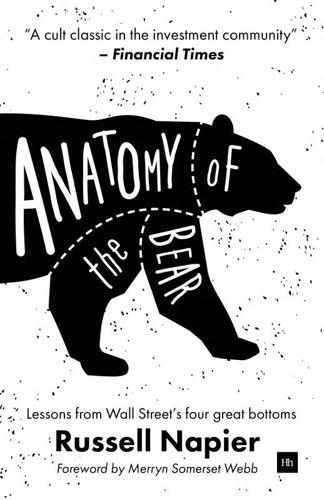
Anatomy of the Bear: Lessons From Wall Street's Four Great Bottoms
by
Russell Napier
Published 18 Jan 2016
From October 1930, such a withdrawal of deposits began, but perhaps none could have anticipated the contraction in the deposit-currency ratio that ensued, from 11.5 in October 1930 to just 4.4 in March 1933. Before the public’s withdrawal of its money was over, the deposit-currency ratio would be reduced to levels not seen since the end of the 19th Century. Given the operation of the fractional reserve banking system, where banks had to maintain cash balances much smaller than their deposit base, this drain of cash from the banks had a very negative impact. In this period the banks needed to reduce deposits by $14 in order to make $1 available for the public to hold as currency. The huge monetary impact of such deposit flight and the inability, or unwillingness, of the Federal Reserve to counteract it, is the key reason why the US recession of 1930 developed into the depression of 1931-32.

Who Owns the Future?
by
Jaron Lanier
Published 6 May 2013
Some of the money to pay for your house might not have ever existed had you not decided to buy. It is invented “out of thin air,” to use the language of critics of the system,* based on the fact that you have made a promise to earn it somehow in the future. *Both progressives like Thom Hartmann and libertarians like Ron Paul assail the fractional reserve banking system. It is often deemed “fraudulent,” a tool of “international bankers,” or a form of indentured servitude. While I agree there is a tremendous cause to criticize the present system, the venom seems directed at basic principles that deserve to be understood in a better light. Ordinary people can help create new money by making promises.
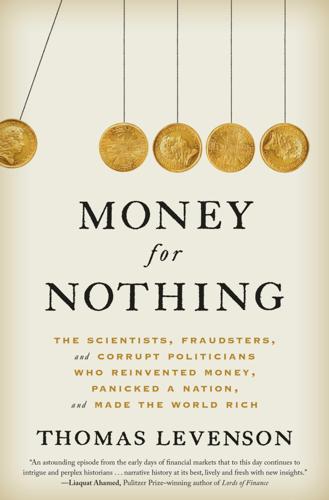
Money for Nothing
by
Thomas Levenson
Published 18 Aug 2020
That requirement turned the fledgling institution into something new on Europe’s financial landscape. Because those who made deposits with the bank could use the banknotes they received in return as cash in any transaction where the other party would accept it, the Bank performed what we now call fractional reserve banking. That is: previously, nationally chartered banks like the Bank of Amsterdam had functioned as pure deposit institutions. You could hand in gold and get paper receipts for your deposit, which could circulate as money—an early banknote. But that was as far as Amsterdam bankers were willing to go.
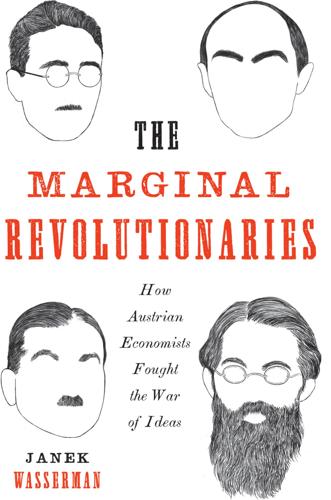
The Marginal Revolutionaries: How Austrian Economists Fought the War of Ideas
by
Janek Wasserman
Published 23 Sep 2019
Rising wages and prices produced an illusion of economic growth, setting the economy up for a fall.57 Mises devoted much of Theory to exploring problems created by expanding the money supply and raising interest rates beyond their “natural” rates. In particular, he examined the role of banks and their use of “fiduciary media.” As Mises recognized, our modern system of fractional reserve banking is based on fiduciary media. When banks issue loans, they are not typically covered by actual deposits. Their reserves represent only a fraction of their total liabilities. Mises identified this kind of expansionary credit creation with inflation, which produced booms—and then busts: “The moment must eventually come when no further extension of the circulation of fiduciary media is possible.
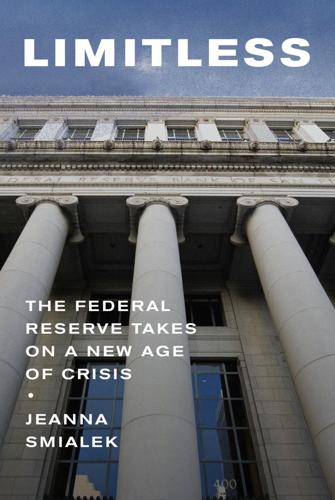
Limitless: The Federal Reserve Takes on a New Age of Crisis
by
Jeanna Smialek
Published 27 Feb 2023
Cohen, Patricia, and Tiffany Hsu. 2020. “$300 Unemployment Benefit: Who Will Get It and When?” New York Times, September 17. Cohn, Gary, and Glenn Hutchins. 2020. “The Fed’s New Mission to Save the Economy.” Wall Street Journal, April 6. Collins, Andrew, and John Walsh. 2014. “Fractional Reserve Banking in the Roman Republic and Empire.” Ancient Society 44:179–212. Committee, Federal Reserve Bank Organization. 1914. “Decision of the Reserve Bank Organization Committee Determining the Federal Reserve Districts and the Location of Federal Reserve Banks Under Federal Reserve Act Approved December 23, 1913.”
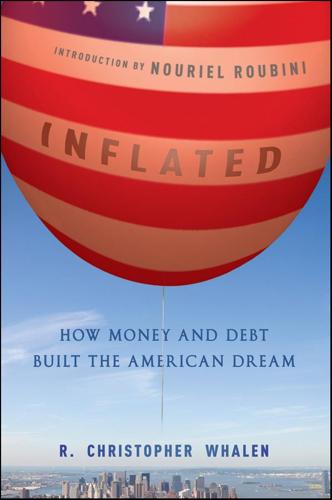
Inflated: How Money and Debt Built the American Dream
by
R. Christopher Whalen
Published 7 Dec 2010
It is interesting to speculate how the financial markets in the United States and Europe would have reacted had a silverite such as Stevenson become president. Rothbard described the scene facing Cleveland in that terrible year: Poor Grover Cleveland, a hard money Democrat, assumed the presidency in the middle of this monetary crisis. Two months later, the stock market collapsed, and a month afterward, in June 1893, distrust of the fraction reserve banks led to massive bank runs and failures throughout the country. Once again, however, many banks, national and state, especially in the West and South, were allowed to suspend specie payments. The panic of 1893 was on.13 Despite long speeches by Bryan and other pro-silver members of the House, on August 28, 1893, the lower chamber voted 239–108 to repeal the Sherman Act.
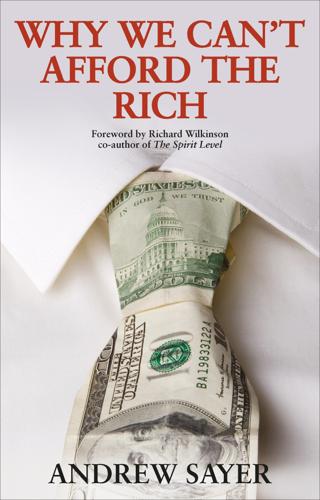
Why We Can't Afford the Rich
by
Andrew Sayer
Published 6 Nov 2014
In this view, banks are ‘intermediaries’, linking hard-working, prudent savers to investors in the economy’s future. This picture is seriously misleading. It is not just that banks lend out much more than they borrow from us, on the assumption that we and other savers will not draw out our savings all at once. This is the widely taught story of ‘fractional reserve banking’. The important point is that they have the power to create electronic money in the form of interest-bearing credit (or debt, from the point of view of the borrower) simply by typing the figures into the borrower’s account. They create such deposits rather than wait for them to come in.64 When we borrow from a bank, or from a credit card company, we are not drawing upon existing money that they already have.